
4 Rudder Types for Sailboats

A rudder is an ancient piece of technology that people still use to steer sailboats today. Modern sailboats use many different types of rudders.
If you turn the rudder to the left, the stern will turn right, and vice versa. You can use either a steering wheel or a tiller to move the rudder. Not every type of boat has the same kind of rudder, nor should every boat - different boats need significantly different rudders.
There are several different types of rudders in common use. Sailboats use full keel rudders, spade rudders, outboard rudders, and skeg-mounted rudders, plus variations on each type. What type of rudder is best depends on the shape of the hull and the boat's size.
Table of contents

Different rudder types and their advantages
Full keel rudders.
Many sailboats have a full keel rather than a fin keel, which requires a particular type of rudder. A full keel is the standard type of keel, or flat blade at the bottom of a sailboat. A full keel is designed for stability, not speed - it can keep you safe in rough water.
A generation or two ago, nearly all cruising boats had full keels. However, this is no longer true. Many customers today prefer fin keels, which are designed with speed rather than stability in mind.
A fin keel is smaller than a full keel and shaped differently. Fin keels are more popular today because many sailors today never go far from the coast. If you are near the coast, fin keels are relatively safe.
With a full keel sailboat , the rudder appears to be part of the keel. It is attached with a hinge and looks like a continuation of the keel. There may be a hole between the keel and the rudder, where the propeller is, although not all boats use this design.
What is the advantage of a full keel rudder?
A full keel rudder is strong and protects the boat from harm. A full keel rudder helps a boat survive a storm. Any debris floating by will not snag on a full keel rudder as it will snag on some other rudders.
Do full keel rudders have any disadvantages?
It is harder to move a full rudder than to move other types of rudders. Water flowing by the boat puts a great deal of pressure on a full keel rudder and makes the rudder hard to move. It takes a lot of force to push the rudder against the water moving past the boat.
Spade rudders
Spade rudders are for fin keel boats rather than full keel boats. A spade rudder sticks straight down into the water. A spade rudder can rotate left or right with a rudder post that extends into the hull.
Advantages and disadvantages of spade rudders
The most obvious advantage of the spade rudder is that it can be part of a fin keel boat. A full keel rudder requires a full keel - you could not attach a rudder of this type to another type of boat.
It is also not nearly as difficult to turn a spade rudder as it is to turn a full keel rudder. The water does not put all of its force on one side of the rudder, so it does not take as much force to turn it.
One disadvantage is that debris floating in the water can get caught on a spade rudder. Spade rudders are more delicate than full keel rudders in many ways. Debris can damage a spade rudder.
A spade rudder can also be damaged by rough water. Large waves may exert enough pressure on a spade rudder that it will break. A large wave can bend the rudder post, and after that happens, your rudder becomes useless.
Outboard rudders
An outboard rudder is not part of the boat's hull and is mounted outside of it, at the back of the boat. Usually, an outboard rudder is not hooked up to a steering wheel.
Instead, it is hooked up to a tiller, which is a steering lever. A tiller can take a bit of getting used to if you are used to a steering wheel, but a tiller is not hard to use. Many sailors prefer a tiller, especially for smaller boats.
Advantages and disadvantages of outboard rudders
If an outboard rudder is damaged, it is not likely to damage the rest of the boat. Since there is no rudder post running through the hull, damage to the rudder usually won't mean damage to anything else as well.
You may also be able to remove and fix a damaged outboard rudder while you are still out at sea. There is no way to remove a rudder that is part of the hull and beneath the boat, but a rudder attached to the boat with hinges may be possible to fix at sea.
Outboard rudders are not necessarily weaker than and can be stronger than other types of rudders. The hinges that hold an outboard rudder in place may be stronger than a rudder post.
In some ways, an outboard rudder is worse than either a spade rudder or a full keel rudder. Unlike a full keel rudder, things like rope floating in the water can get caught on an outboard rudder. Objects floating by can also hit and damage an outboard rudder more easily than they can damage a more durable full keel rudder.
Compared to a spade rudder, the outboard rudder is harder to turn. The water pressure will always be on one side of the rudder; this is not always the case with spade rudders.
Skeg mounted rudders
Skeg rudders are both durable and possible to use on fin keel rather than full keel boats. Skeg mounted rudders are more durable than the spade rudders you usually find on fin keel boats.
Skeg mounted rudders have the same disadvantage as full keel rudders and outboard rudders, which is that they require more energy to turn. The water will put all of its pressure on one side of the rudder. Only spade rudders avoid this problem.
Is a tiller better than a wheel?
Either for inexperienced or veteran sailors, a tiller can work better. With a tiller, you will get immediate feedback. If you turn a wheel, the boat won't turn right away, which can confuse or annoy a new sailor.
The tiller should be long enough, as it is harder to turn if it is shorter. In strong winds, you need a long lever to turn your boat without it taking a great deal of strength.
It is easier to turn a wheel than to turn a tiller, as there is more leverage with a steering wheel. Therefore, wheels are better for larger boats; as a tiller is harder to turn with a bigger boat.
A tiller's advantage is that it is more responsive than a wheel, even though it is harder to turn. The boat will start to change direction almost immediately if you use a tiller. In racing, it is normal to use a tiller because you can change direction more quickly.
How does a rudder work?
A rudder works through water pressure. If you turn the rudder, the pressure becomes higher on one side of the rudder than the other. The rudder then moves toward the side with the lower pressure, which causes the boat to change direction.
When a sailboat turns, it pivots around a point near the middle of the boat. Both the stern and the bow move simultaneously, with the middle of the boat not moving. You have to take this into account while sailing, or else you might swing the end of your ship into another boat.
What is the purpose of the keel?
The keel keeps the boat stable. Without a keel sticking down from the boat into the water, it would be easy for the wind to push the boat around. Without a keel, the wind could easily push you sideways and make the ship much harder to control.
A keel is also weighted. The keel is full of ballast, which is weight that keeps the boat from flipping over. Without ballast, a boat would be top-heavy and unsafe.
Keels are usually made out of the same material as the rest of the boat - if the boat is aluminum, the keel will be as well. The ballast is usually lead.
While full keels are better in rough weather in most ways, a fin keel does a better job of preventing the wind from blowing your boat around. Wind can create leeway, which is sideways movement of the boat. Leeway is most likely if you are sailing into the wind.
Do rudders often fail at sea?
Yes, a rudder failure is one of the more common hazards you might encounter at sea. Not every sailboat has a good, durable rudder. The rudders on cheap boats, especially cheap fiberglass boats, can fail.
The rudder pole should neither be too weak nor too strong. If the rudder pole is too weak, it will bend easily. If it is too strong, it may damage the hull rather than bend, which is even more dangerous.
A rudder has a metal framework inside of it. If the framework breaks, the rudder will become unusable. With a cheaper boat, the metal framework may not be welded together properly.
Make sure you buy a sailboat that has a reputation for safety. Don't buy the cheapest boat you can find - look into whether or not the boat is safe to take out to sea.
Related Articles
Daniel Wade
I've personally had thousands of questions about sailing and sailboats over the years. As I learn and experience sailing, and the community, I share the answers that work and make sense to me, here on Life of Sailing.
by this author
Learn About Sailboats
Sailboat Parts
Most Recent

What Does "Sailing By The Lee" Mean?
October 3, 2023

The Best Sailing Schools And Programs: Reviews & Ratings
September 26, 2023
Important Legal Info
Lifeofsailing.com is a participant in the Amazon Services LLC Associates Program, an affiliate advertising program designed to provide a means for sites to earn advertising fees by advertising and linking to Amazon. This site also participates in other affiliate programs and is compensated for referring traffic and business to these companies.
Similar Posts

Affordable Sailboats You Can Build at Home
September 13, 2023

Best Small Sailboat Ornaments
September 12, 2023

Discover the Magic of Hydrofoil Sailboats
December 11, 2023
Popular Posts

Best Liveaboard Catamaran Sailboats
December 28, 2023

Can a Novice Sail Around the World?
Elizabeth O'Malley
June 15, 2022

4 Best Electric Outboard Motors

How Long Did It Take The Vikings To Sail To England?

10 Best Sailboat Brands (And Why)
December 20, 2023

7 Best Places To Liveaboard A Sailboat
Get the best sailing content.
Top Rated Posts
© 2024 Life of Sailing Email: [email protected] Address: 11816 Inwood Rd #3024 Dallas, TX 75244 Disclaimer Privacy Policy
- Understanding boat rudders: Navigating the key component for smooth sailing
Navigating a boat requires a complex interplay of various components, and one of the most crucial elements is the rudder. In this comprehensive guide, we will delve into the world of boat rudders, exploring their functionality, importance, and role in steering a ship to smooth sailing.
What are boat rudders?
Boat rudders are an essential component of the vessel's steering system. They are hydrofoil-like structures located at the stern (rear) of the boat, underwater. The primary function of the rudder is to control the direction of the boat by redirecting the flow of water as the boat moves forward.
The role of boat rudders in steering
Boat rudders play a vital role in steering a ship. When the helmsman turns the wheel or tiller, the rudder changes its angle, redirecting the water flow on one side of the boat, creating more resistance on that side, and causing the boat to turn in the opposite direction.
Types of boat rudders
Spade rudders: Spade rudders are simple and streamlined rudders attached directly to the hull. They are commonly found in modern sailboats and provide excellent maneuverability and responsiveness.
Skeg rudders: Skeg rudders are partially submerged and supported by a skeg, a vertical extension of the hull. These rudders offer increased protection and are often used in larger motorboats and trawlers.
Balanced rudders: Balanced rudders have a portion of the rudder forward of the pivot point, which balances the force applied by the helmsman. This design reduces the effort required to steer the boat.
Barn door rudders: Barn door rudders are large, flat, and wide rudders resembling barn doors. They are commonly seen in traditional fishing vessels and provide excellent control in rough seas.
Spade hung rudders: Spade hung rudders are free-floating rudders attached to the boat only at the top, allowing them to swing freely. They are commonly used in high-performance sailing yachts.
Read our top notch articles on topics such as sailing, sailing tips and destinations in our Magazine .
Components and mechanics of boat rudders
A typical boat rudder consists of several key components:
Rudder blade: The rudder blade is the flat, vertical surface responsible for redirecting the water flow. It is the most critical part of the rudder and comes in various shapes and sizes.
Rudder stock: The rudder stock is a sturdy vertical shaft that connects the rudder blade to the steering mechanism. It provides the necessary support and stability for the rudder.
Tiller or wheel: The tiller or wheel is the steering control operated by the helmsman. When turned, it causes the rudder to change its angle and steer the boat.
Rudder bearings: Rudder bearings are the mechanisms that allow the rudder to pivot smoothly on the rudder stock. Properly lubricated and maintained bearings ensure easy steering.
Steering linkage: The steering linkage consists of rods or cables connecting the tiller or wheel to the rudder stock. It transmits the helmsman's steering inputs to the rudder.
Steering a ship: The interaction between rudder and helm
The process of steering a ship involves a coordinated effort between the rudder and the helm. When the helmsman turns the wheel or tiller, the rudder angle changes, causing a difference in water flow on either side of the boat. This creates a force imbalance, turning the boat in the desired direction.
The effectiveness of the steering system depends on various factors, such as the rudder's size, shape, and angle, the vessel's speed, and the water conditions. Proper coordination between the helmsman and the rudder is essential for precise maneuvering.
Maintaining and repairing boat rudders
Regular maintenance is crucial to ensure the optimal performance and longevity of boat rudders. Here are some maintenance tips:
Inspect for damage: Regularly inspect the rudder blade, stock, and bearings for any signs of wear, damage, or corrosion.
Lubrication: Ensure the rudder bearings are well-lubricated to prevent friction and allow smooth movement.
Antifouling: Apply antifouling paint to the rudder to prevent marine growth, which can negatively impact performance.
Check steering linkage: Inspect and adjust the steering linkage regularly to maintain precise control.
Address issues promptly: If any problems or abnormalities are detected, address them promptly to prevent further damage.
Rudder design innovations
Advancements in technology have led to innovative rudder designs aimed at improving performance and efficiency. Some notable innovations include:
Hydrodynamic profiles: Rudder blades are now designed with advanced hydrodynamic profiles to reduce drag and enhance maneuverability.
Rudder fins: Some rudders are equipped with additional fins or foils to improve stability and minimize yawing motion.
Retractable rudders: Certain sailboats feature retractable rudders, which can be raised when sailing in shallow waters, reducing the risk of grounding.
Steer-by-wire systems: Modern vessels are adopting steer-by-wire systems, replacing traditional mechanical linkages with electronic controls for smoother steering.
The influence of rudder size and shape on turning radius
The size and shape of the rudder directly impact the vessel's turning radius. Larger rudders with greater surface area provide more steering force and can turn the boat more quickly. However, larger rudders also create more drag, which can affect overall speed and fuel efficiency. The optimal rudder size depends on the boat's size, weight, and intended use.
Rudder efficiency and hydrodynamics
The hydrodynamics of the rudder significantly affect its efficiency. Smooth and streamlined rudder designs minimize drag and turbulence, resulting in improved performance and fuel economy. Advanced hydrodynamic analysis and simulation tools help optimize rudder shapes for various vessels and operating conditions.
Common rudder issues and troubleshooting
Like any mechanical component, boat rudders can experience issues over time. Some common problems and troubleshooting tips include:
Stiff steering: If the steering feels stiff or unresponsive, check for obstructions in the rudder bearings or linkage.
Vibrations: Vibrations during steering may indicate misaligned rudder blades or bent rudder stocks.
Leaking bearings: Leaking rudder bearings require immediate attention to prevent water ingress and corrosion.
Excessive play: Excessive play in the rudder could be due to worn steering linkage or loose connections.
Reduced maneuverability: Reduced maneuverability may result from a fouled or damaged rudder blade.
Rudder steering systems
Various steering systems are employed in conjunction with rudders, each offering unique advantages:
Tiller steering: Common in smaller boats, tiller steering directly connects the tiller to the rudder stock, providing direct and responsive control.
Wheel steering: Larger boats often use wheel steering, which utilizes a mechanical or hydraulic system to transfer steering inputs to the rudder.
Hydraulic steering: Hydraulic steering systems offer smooth and effortless steering, ideal for larger vessels.
Electric steering: Electric steering systems, also known as electro-hydraulic steering or electronic power steering (EPS), utilize electric motors to assist in steering the boat. These systems work in conjunction with hydraulic components, making steering more effortless and responsive for the boat operator.
So what are you waiting for? Take a look at our range of charter boats and head to some of our favourite sailing destinations .
FAQs about rudders

- Switch skin
Understanding Marine Rudders: Types, Usage, and Design Considerations
Introduction to Marine Rudders
Marine rudders are essential components in a vessel’s steering system, playing a critical role in maritime navigation. They are devices typically located at the stern of a ship, designed to direct the flow of water, thereby altering the vessel’s course. The fundamental purpose of a rudder is to provide directional control, which significantly enhances the manoeuvrability and overall control of ships.
The concept of the rudder has evolved significantly over the centuries. Early rudders were simple, often consisting of a large oar or a flat board attached to the stern of the vessel. These rudimentary designs laid the groundwork for the sophisticated rudder systems used in modern marine engineering. The evolution of rudders can be traced back to ancient civilizations, such as the Egyptians and Chinese, who developed early steering mechanisms to improve the navigability of their watercraft.
Rudders function based on basic mechanical principles. When the rudder is turned, it creates a pressure difference between its two sides, causing the vessel to pivot around its vertical axis. This action alters the direction of the incoming water flow, enabling the ship to change course. The effectiveness of a rudder in steering a vessel is influenced by factors such as its size, shape, and speed of the vessel.
In modern maritime navigation, the significance of rudders cannot be overstated. They are integral to the safe operation of ships, allowing for precise manoeuvring in various sea conditions. Advanced rudder designs have been developed to meet the demands of different types of vessels, from small boats to large ocean liners. These designs incorporate features that enhance the efficiency and responsiveness of the rudder, ensuring that ships remain controllable even in challenging environments.
Understanding the basic principles and historical context of marine rudders provides a foundation for exploring their various types, usage, and design considerations, which are critical for anyone involved in the field of maritime engineering and navigation.
The Role and Importance of Marine Rudders
Marine rudders are integral components of a vessel’s steering system, playing a crucial role in determining the direction and stability of both small boats and large commercial ships. Positioned at the stern, the rudder works by redirecting the flow of water as it passes over its surface, thereby creating a turning force that helps navigate the vessel. This interaction is essential for controlling the course of the ship, making marine rudders indispensable for effective manoeuvrability.
In small boats, the rudder’s impact is immediately noticeable. As the sailor adjusts the tiller or steering wheel, the rudder pivots, altering the vessel’s direction almost instantaneously. This direct response is vital for sailing in tight spaces or navigating through crowded marinas. On larger commercial ships, the rudder’s role becomes even more significant. These vessels rely on advanced steering systems, where the rudder works in conjunction with other components such as the propeller and bow thrusters to ensure precise and safe navigation.
The importance of marine rudders is particularly evident in challenging weather conditions and complex maritime environments. In rough seas or during storms, the rudder helps maintain the vessel’s stability by counteracting the forces exerted by waves and wind. This stability is critical for preventing capsizing and ensuring the safety of the crew and cargo. Additionally, in narrow or heavily trafficked waterways, the rudder’s precision allows for careful manoeuvring, avoiding collisions and grounding.
Furthermore, the rudder’s efficiency is enhanced by its design and integration with the vessel’s propulsion system. Modern rudders are often designed with hydrodynamic shapes to minimize resistance and maximize control. The synergy between the rudder and propulsion components, such as the propeller, is crucial for achieving optimal performance. The rudder’s ability to swiftly and accurately respond to steering commands is what enables a vessel to navigate safely and efficiently across various marine environments.
Types of Marine Rudders
Marine rudders are critical components in ship design, providing the necessary control and manoeuvrability for navigation. The primary types of marine rudders include balanced, semi-balanced, and unbalanced rudders, each offering unique design features and advantages. Additionally, specialized designs such as spade rudders, skeg rudders, and flapped rudders are utilized for specific applications.
Balanced Rudders: Balanced rudders are designed so that the centre of pressure is located along the rudder stock, reducing the steering effort required. This configuration enhances manoeuvrability and minimizes the load on the steering gear. Balanced rudders are particularly advantageous for larger vessels where efficient steering is crucial.
Semi-Balanced Rudders: Semi-balanced rudders have a portion of the rudder area ahead of the stock, providing a compromise between balanced and unbalanced designs. This type of rudder offers improved control at various speeds and is commonly used in medium-sized vessels. The semi-balanced configuration provides a balance between manoeuvrability and stability.
Unbalanced Rudders: Unbalanced rudders have the entire rudder area aft of the stock. While this design requires more steering effort, it can provide greater stability, especially in smaller vessels. Unbalanced rudders are often found on older ships and smaller boats where simplicity and robustness are prioritized over efficiency.
Spade Rudders: Spade rudders are a type of balanced rudder where the entire rudder blade is unsupported by the hull, except at the top. This design allows for excellent manoeuvrability and responsiveness, making it a popular choice for high-speed vessels such as yachts and ferries.
Skeg Rudders: Skeg rudders are partially supported by a skeg, which is an extension of the ship’s keel. This support provides additional strength and stability, making skeg rudders suitable for ships operating in rough waters or ice conditions. The skeg also helps protect the rudder from damage.
Flapped Rudders: Flapped rudders incorporate a movable flap at the trailing edge, enhancing the lift and control effectiveness. This design is particularly useful for vessels requiring precise manoeuvring, such as tugboats and harbour vessels. The flap provides improved turning capability without significantly increasing the size of the rudder.
Each type of marine rudder offers distinct benefits and is chosen based on the specific requirements of the vessel and its operational environment. Understanding these types helps in making informed decisions about rudder selection, ensuring optimal performance and safety at sea.
Materials Used in Marine Rudder Construction
Marine rudders are critical components in the navigation and control of vessels. The materials used in their construction significantly impact their performance, durability, and maintenance requirements. Among the most commonly utilized materials are steel, aluminium, and composite materials, each offering distinct properties that cater to specific needs and conditions.
Steel is perhaps the most traditional material used in marine rudder construction. Known for its exceptional strength and durability, steel rudders can withstand harsh marine environments and the mechanical stresses associated with large vessels. The high tensile strength of steel ensures that the rudder can handle significant forces during operation, making it a preferred choice for commercial ships and large cargo vessels. However, steel is prone to corrosion, necessitating regular maintenance and protective coatings to prolong its lifespan.
Aluminium, on the other hand, is valued for its lightweight properties and resistance to corrosion. Its lower density compared to steel reduces the overall weight of the rudder, contributing to improved fuel efficiency and performance of smaller vessels, such as yachts and recreational boats. Aluminum rudders require less frequent maintenance, but they may not offer the same level of strength as steel, limiting their use in larger or more heavily loaded ships.
Composite materials, such as fiberglass-reinforced polymers, are increasingly popular in modern marine rudder construction. These materials combine the benefits of both steel and aluminium, providing high strength-to-weight ratios and excellent resistance to corrosion. Composite rudders are highly customizable, allowing for advanced designs that enhance hydrodynamic performance. Additionally, they tend to require less maintenance compared to their metal counterparts. However, the initial cost of composite materials can be higher, and their performance can vary based on the quality of the manufacturing process.
When selecting materials for marine rudders, it is crucial to consider the type of vessel and its operating conditions. Factors such as the size of the vessel, exposure to corrosive environments, and the mechanical loads experienced during navigation all play a role in determining the most suitable material. By carefully evaluating these factors, vessel designers can optimize rudder performance, ensuring safe and efficient maritime operations.
Design Principles and Considerations
Designing marine rudders requires a comprehensive understanding of various principles that ensure optimal performance and reliability. One of the foremost considerations is hydrodynamic efficiency, which involves minimizing resistance and maximizing lift to improve manoeuvrability. The rudder’s shape and size are critical in achieving this balance, often tailored to the specific type of vessel and its operating conditions.
Structural integrity is another vital aspect, as rudders must withstand substantial forces during operation. This entails selecting appropriate materials and construction techniques that provide durability while maintaining a manageable weight. The choice of materials often depends on factors such as the vessel’s size, operating environment, and maintenance practices.
The optimization of rudder size and shape is a complex task that involves balancing several parameters. A larger rudder can offer better control, but it also increases drag and may impact the vessel’s speed and fuel efficiency. Conversely, a smaller rudder may reduce drag but could compromise manoeuvrability. Therefore, designers must find an optimal configuration that aligns with the vessel’s performance requirements and operational profile.
Compatibility with the vessel’s hull design is another crucial consideration. The rudder must integrate seamlessly with the hull to avoid adverse interactions that could affect the vessel’s stability and handling. This requires precise alignment and positioning, often achieved through iterative testing and refinement.
Modern rudder design heavily relies on computational fluid dynamics (CFD) to simulate and analyze the flow characteristics around the rudder and hull. CFD allows designers to explore various configurations and identify the most efficient designs without the need for extensive physical testing. This not only accelerates the design process but also helps in achieving a higher degree of precision.
Lastly, designers must balance performance goals with construction costs. Advanced materials and complex designs can enhance rudder performance but may also increase manufacturing expenses. Therefore, it is essential to find cost-effective solutions that do not compromise the rudder’s functionality and durability.
Installation and Maintenance of Marine Rudders
Proper installation and maintenance of marine rudders are critical for ensuring optimal performance and longevity. The installation process begins with aligning the rudder accurately. Aligning the rudder to the vessel’s centerline is essential to prevent asymmetric steering and ensure smooth navigation. Precision in positioning also helps in reducing hydrodynamic drag, thereby enhancing fuel efficiency.
Integration with the steering system is another crucial aspect. The rudder must be securely attached to the stock and linked to the steering gear. This connection should be free from any play or looseness, as even minor discrepancies can lead to steering inefficiencies. Utilizing high-quality bearings and seals can prevent premature wear and ensure seamless operation. Additionally, it is recommended to use corrosion-resistant materials, particularly in saltwater environments, to prolong the rudder’s lifespan.
Routine maintenance is indispensable for the continued reliability of marine rudders. Regular inspections should be conducted to identify any signs of wear, corrosion, or structural damage. One common issue is galvanic corrosion, which occurs when dissimilar metals are in contact in a marine environment. To mitigate this, it is advisable to use sacrificial anodes, which protect the rudder by corroding in place of the more critical components.
Wear and tear on the rudder’s surface and bearings should be monitored closely. Occasional lubrication of moving parts can help in maintaining smooth operation and preventing friction-related damage. In addition to mechanical inspections, it is wise to check for any biofouling – the accumulation of barnacles, algae, and other marine life – which can significantly affect the rudder’s efficiency. Regular cleaning and applying anti-fouling coatings can help manage this issue.
In the event of any detected issues during inspections, timely repairs are crucial. Addressing minor problems promptly can prevent them from escalating into major failures. Ensuring all fasteners and fittings are secure, replacing worn-out parts, and applying protective coatings can collectively enhance the rudder’s durability and performance. By adhering to these best practices in installation and maintenance, marine rudders can continue to provide reliable service and contribute to the vessel’s overall efficiency and safety.
Case Studies of Marine Rudder Applications
Marine rudders play a pivotal role in the manoeuvrability and efficiency of vessels. By examining real-world applications, we can better understand how different types of marine rudders impact vessel performance, fuel efficiency, and navigational safety. This section delves into case studies from both commercial and recreational maritime sectors, showcasing success stories and lessons learned.
One notable case study involves a commercial shipping company that upgraded its fleet with spade rudders. The company reported a significant improvement in maneuverability, particularly in congested ports. The spade rudder’s streamlined design reduced hydrodynamic drag, leading to a 5% increase in fuel efficiency. Moreover, the enhanced control allowed for safer navigation in narrow channels, reducing the risk of accidents.
In another example, a luxury yacht manufacturer opted for semi-balanced rudders in their latest model. This decision was driven by the need for precise handling and stability at high speeds. The semi-balanced rudders provided a perfect balance between ease of steering and maintaining course stability. As a result, the yacht achieved excellent performance in both calm and rough seas, receiving positive feedback from owners and captains alike.
A case study from the fishing industry highlights the use of flapped rudders on trawlers. These rudders, equipped with movable flaps, offered enhanced maneuverability essential for navigating crowded fishing grounds. The increased control allowed for more efficient trawling operations, leading to higher catch rates. Additionally, the flapped rudders contributed to fuel savings, as the vessel could maintain an optimal course with minimal resistance.
Lessons learned from these case studies emphasize the importance of selecting the appropriate rudder type based on the vessel’s specific requirements. Factors such as vessel size, operational environment, and performance expectations must be carefully considered. The right rudder choice can lead to significant improvements in fuel efficiency, navigational safety, and overall vessel performance, showcasing the critical role of rudder design in maritime operations.
Future Trends in Marine Rudder Technology
As the maritime industry advances, marine rudder technology continues to evolve, driven by innovations in materials, design techniques, and the integration of smart systems. One significant trend is the development of advanced composite materials that offer enhanced strength, reduced weight, and improved corrosion resistance. These materials, such as carbon fiber and advanced polymers, are increasingly being adopted to manufacture rudders that are not only more durable but also contribute to overall fuel efficiency by reducing drag.
In addition to material advancements, design techniques are undergoing a transformation with the aid of computational fluid dynamics (CFD) and other simulation tools. These technologies allow for the precise modeling of rudder performance under various conditions, leading to optimized shapes and configurations that enhance maneuverability and stability. By leveraging CFD, engineers can experiment with innovative rudder designs that were previously impractical, thus pushing the boundaries of what is possible in marine navigation.
The integration of automated and smart ship systems represents another significant trend in marine rudder technology. Modern vessels are increasingly equipped with sophisticated control systems that can adjust rudder angles in real-time based on data from various sensors and navigational inputs. This automation not only improves the accuracy of steering but also enhances safety by enabling quicker responses to changing maritime conditions. Moreover, the advent of autonomous ships is expected to further drive the need for advanced rudder systems capable of seamless integration with onboard AI and machine learning algorithms.
Looking ahead, the potential impact of these trends on maritime navigation and vessel design is profound. Enhanced rudder technology will lead to more efficient and environmentally friendly ships, capable of navigating complex routes with greater precision. As innovation continues, it is anticipated that rudders will become even more integral to the overall design of vessels, contributing to a new era of maritime excellence. These advancements herald a future where marine rudder technology not only meets but exceeds the ever-evolving demands of the shipping industry.
NV Tech Desk
What is a cargo crane in marine industry, “ballast keel” in marine glossary, “ballast” in marine glossary, “baggywrinkle” in marine glossary, “azimuth” in marine glossary, “athwartship” in marine glossary, meaning of “ecdis”, meaning of “arpa”, meaning of “amidship”, meaning of “amidships”, subscribe to our mailing list to get the new updates.
Lorem ipsum dolor sit amet, consectetur.
The Types of Sailboat Rudders
- Snowboarding
- Scuba Diving & Snorkeling
Full Keel Rudder
On a sailboat , as the rudder is moved to one side by means of the tiller or steering wheel, the force of the water striking one edge of the rudder turns the stern in the other direction to turn the boat. Different types of rudders have different advantages and disadvantages. The type of rudder is often related to the boat’s type of keel.
Rudder on Full-Keel Sailboat
As shown in this photo, the rudder of a full-keel boat is usually hinged to the aft edge of the keel, making a continuous surface. The engine’s propeller is usually positioned in an aperture between the keel and rudder.
Advantages of Full Keel Rudder
The primary benefit of this rudder configuration is the strength and protection provided to the rudder. It is hinged at top and bottom, well distributing the forces on the rudder. Rope (such as lobster pot warps) or debris in the water cannot snag on the rudder.
Disadvantage of Full Keel Rudder
Because the sideways force of the water on the rudder is entirely behind the rudder’s pivoting point at its leading edge, putting all the force on one side of the rudder, it takes more energy to move the rudder. This is one reason why larger boats seldom have tillers—because it can require much force to “push” the rudder out against the water streaming past the keel.
Spade Rudder
Most fin keel boats have a spade rudder, which extends straight down from the aft hull section. The rudder post comes down through the hull into the rudder itself, allowing the entire rudder to rotate to either side, pivoting around the post.
Advantages of Spade Rudder
The spade rudder is self-standing and does not require a full keel or skeg for its mounting. The rudder post inside the rudder can be moved aft from the leading edge (see next page on Balanced Rudder) so that the force of the water is not all on one side when the rudder is turned. This requires less energy to steer than with a keel- or skeg-mounted rudder.
Disadvantage of Spade Rudder
A spade rudder is more vulnerable to debris or objects in the water, which may strike the rudder and exert a force on the rudder post, the only structure supporting the whole rudder. Even the force of water when the boat “falls” off a wave can exert damaging stress on a spade rudder. If the rudder post is bent, the rudder may jam and become useless.
Balanced Spade Rudder
Note the clear air space at the top of the leading edge of this balanced spade rudder. The rudder post is several inches back from the front of the rudder. When the rudder is turned, the leading edge rotates to one side of the boat while the trailing edge rotates to the other side. While the turning action on the boat is the same, the forces on the helm are more nearly balanced, making it very easy to steer.
Skeg-Mounted Rudder
Some fin keel sailboats have a skeg-mounted rudder like the one shown. The skeg offers the same advantages as a keel mounted rudder: the rudder is protected from objects in the water and has more structural strength than a rudder mounted only on the rudder post.
It also has the same disadvantage: because it is not “balanced” as a spade rudder may be, with water forces distributed on both sides, it requires more force to turn the rudder.
Outboard Rudder
An outboard rudder is mounted outside the hull on the boat’s stern, such as shown in this photo, rather than below the hull using a rudder post or hinges to the keel or skeg. Most outboard rudders are turned with a tiller rather than a steering wheel since there is no rudder post to which to gear a wheel.
Advantages of Outboard Rudder
An outboard rudder does not require a hole through the hull for a rudder post and thus is less likely to cause trouble if damaged. The rudder can often be removed or serviced while the boat is still in the water. Hinges at the top and bottom of the rudder section may provide more strength than a single rudder post.
Disadvantages of Outboard Rudder
Like a spade rudder, an outboard rudder is vulnerable to being struck by or caught in objects or rope in the water. Unlike a spade rudder it cannot be balanced in the water flow, so the force of water is always on one side of the pivot point, requiring more energy for turning the rudder.
A rudder is often related to keel shape .
- Choosing an Inboard or Outboard Engine
- Choosing a Centerboard or Fixed Keel Sailboat
- How to Tow a Dinghy Behind a Sailboat
- The Sunfish: A Perfect Lake or Urban Sailboat
- Learn How to Sail a Small Sailboat – 1. The Parts of the Boat
- Using AIS on Your Sailboat
- How to Gybe a Sailboat
- How to Raise the Mainsail
- Best Sailing and Boating Apps
- How to Boat
- When to Adjust Sailboat Sails for Stronger Winds
- How to Tack a Sailboat
- How to Use a Sailboat's Outhaul
- How to Anchor a Sailboat
- How to Whip a Line End Using the Oldest and Best Method
- Control Your Tiller Without a Tiller-Tamer

ONE, HMM And Yang Ming Confirm The Alliance Partnership

ICS Publications Announces The Launch Of “A Practical Guide To Shipboard Inspections”

‘Helios’ Sets New Guinness World Record For Most Solar Panels On A Cargo Vessel

Shipowners Who Force Seafarers To Sail High-Risk Areas May Face Sanctions

Types of Rudders Used For Ships
Have you ever noticed that ships, unlike most aeroplanes, do not have the same kinds of rudders?
The type of rudder that would suit a particular ship is a decision that needs to be based on various factors like hull form , speed, propeller design , the structural arrangement of the stern , clearance between the propeller and the stern, and also a few hydrodynamic factors that dictate the flow of water aft of the propeller.
How ship designers go about deciding the type of rudder, is actually an iterative process. In the concept ship design stage, we actually do not (or cannot afford to) decide the suitable rudder for the ship.
So what designers and naval architects do is, estimate a very approximate dimension of the rudder along with the propeller.
But as we enter the preliminary design of the ship, the rudder and propeller dimensions are almost fixed, giving us an almost clear idea of the type of rudder that would best fit the design problem.

However, what becomes significantly important from a designer’s point of view, is deciding on the type and location of the rudder, depending on the hull and propeller design.
Let’s try to understand this in a simple way.
The selection of the proper type of rudder is as important as the location of the rudder behind the propeller. The location of the rudder should be such that it is properly oriented within the propeller’s outflow so as to produce the required turning moment on the ship (Before we go ahead, you might like to read How does a rudder work on a ship? ). A slight change in the rudder type, dimension, and position can bring about a huge variation in the ship’s response to the rudder, as well as the turning ability of the ship. So, optimization is the key.
Related Reading:
Understanding the design of ship propeller
Understanding the design of container ships
Understanding the design of oil tankers
Types of Rudders For Ships
To broadly categorize conventional rudders, there are two types of ship rudders:
1. Spade or Balanced Rudder
A spade rudder is basically a rudder plate that is fixed to the rudder stock only at the top of the rudder. In other words, the rudder stock (or the axis of the rudder) doesn’t run down along the span of the rudder.
The position of the rudder stock along the chord of the rudder (width meaning, from the forward to aft end of the rudder) actually decides whether the rudder is balanced of semi-balanced one.
In balanced rudders, (which spade rudders generally are) the rudder stock is at such a position such that 40% of the rudder area is forward of the stock and the remaining is aft of it.
A genuine question that must have come up in your mind is, why is such a position chosen for the rudder stock? The answer lies in simple physics.
The centre of gravity of the rudder will lie somewhere close to 40% of its chord length from its forward end. If the axis of the rudder is placed near to this location, the torque required to rotate the rudder will be much lesser than what is required to move it, had the axis been placed at the forward end of the rudder.
So, the energy requirement of the steering gear equipment is reduced, therefore lowering the fuel consumption of the ship .
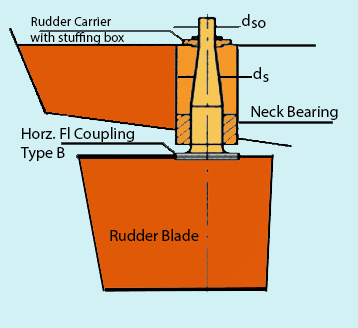
2. Unbalanced Rudders
These rudders have their stocks attached at the forward most point of their span. Unlike balanced rudders, the rudder stock runs along the chord length of the rudder. The reason is simple.
In this case, the torque required to turn the rudder is way higher than required for a corresponding balanced rudder. So, the topmost part of the rudder has to be fixed to the spindle so as to prevent it from vertical displacement from its natural position. However, unbalanced rudders are not widely used now.
Having discussed the conventional types of rudders, let us shift into something yet more interesting. Researchers and ship operators had found significant problems with the balanced and unbalanced rudders. That is, in case there was a failure of the steering gear mechanism while turning a ship. The rudder would remain still with its angle of attack in that condition. The solution to this was found in designing an optimized Semi-Balanced Rudder.
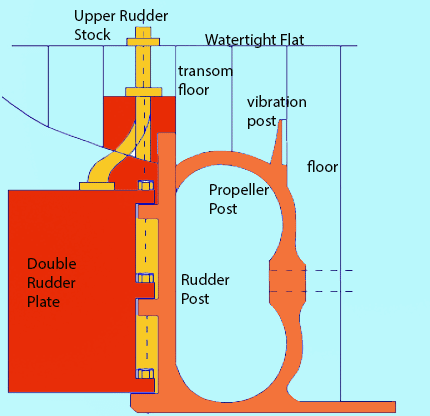
a. Semi- Balanced Rudder
If you have been able to visualize a balanced and unbalanced rudder by now, it should be pretty easy to visualize a semi-balanced rudder. In fact, the rudder you see on most ships are semi-balanced in the modern industry. The name semi-balanced itself implies, that the rudder is partly balanced and partly unbalanced. If you refer to the figure below, you’ll see that a portion of the chord length from the top is unbalanced, and the remaining chord length is balanced. Why? Read on.
The top part being unbalanced will help in acting as structural support to the rudder from vertical displacement. And the balanced part will render less torque in swinging the rudder. As a result, a semi-balanced rudder returns to the centreline orientation on its own if the steering gear equipment fails during a turn.
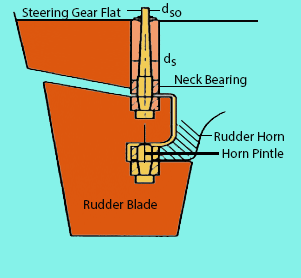
Note in the above figure the Rudder horn. Semi-balanced rudders are again of two types depending upon the depth of the horn (which affects the response and torque characteristics of the rudder). A shallow horn rudder will have a horn which extends hardly half the chord length of the rudder from the top. Whereas, a deep horn rudder will feature a horn deeply extending up to more than 50 % of its chord length from the top of the rudder.
Apart from these, designers have developed some other, rather unconventional rudder systems, which gets more interesting to look into.
Understanding the design of ship’s hull
Different technologies to measure hull stresses
b. Flaps Rudder
You must have watched an aeroplane’s wings closely. Did you watch those flaps coming in and out of the aft end of the wing? Why do you think they do that? Primarily to change the effective angle of attack of the entire aerofoil section of the wing. You’ll see, during a takeoff, how all the flaps are completely deployed. That actually helps in attaining the effective angle of attack so as to get the maximum lift force.
The same principle, when used in rudders, provides a similar result. Just that, in case of rudders, the flaps are not retractable and they have their significant effects when the rudder is given some angle of attack.
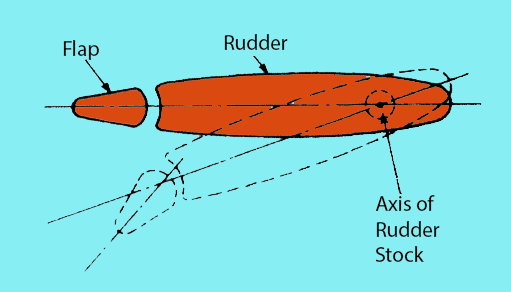
c. Pleuger Rudder
Perhaps one of the most innovative rudder mechanisms you will ever come across. Suppose you have a ship, too large to be manoeuvre in a basin with size constraints, such that the ship cannot use its propeller during the manoeuvre. This situation often arises in case of large ships operating in space-constrained basins, or in any case of low-speed manoeuvres.
So, a Pleuger rudder (as you can see in the figure below), has a smaller auxiliary propeller housed within it (which runs by a motor). As this housing is mounted on the rudder itself, it generates a thrust (which is smaller than what is generated by the ship’s main engine propeller) in a direction that is oriented along the rudder, therefore allowing effective manoeuvre in slow speed condition.
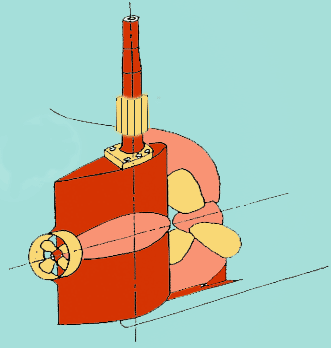
Such a rudder can be used in normal conditions also. Just that, in normal speeds, the Pleuger is not operated. However, when the Pleuger is run, the main engine propeller must not be operated simultaneously, which will otherwise cause the Pleuger to be torn away.
Different types of dry docks for ships
Types of ship’s keel
Voith Propulsion
You must be wondering why a propulsion system has popped into the discussion when we are interested in rudder systems. Well, that’s something you need to thank the researchers for. Because this propulsion system is one of a kind, which acts as a rudder itself. It doesn’t need a rudder control surface to change the direction of the ship. How? Read on.
As you can see in the figure below, this propeller has a completely different orientation. To visualize it in simple terms, it consists of a number of hydrofoil blades mounted on a disc, which is in turn, mounted onto the hull. The disc rotates in a horizontal plane, about a horizontal axis, and therefore imparts a rotation into the blades.
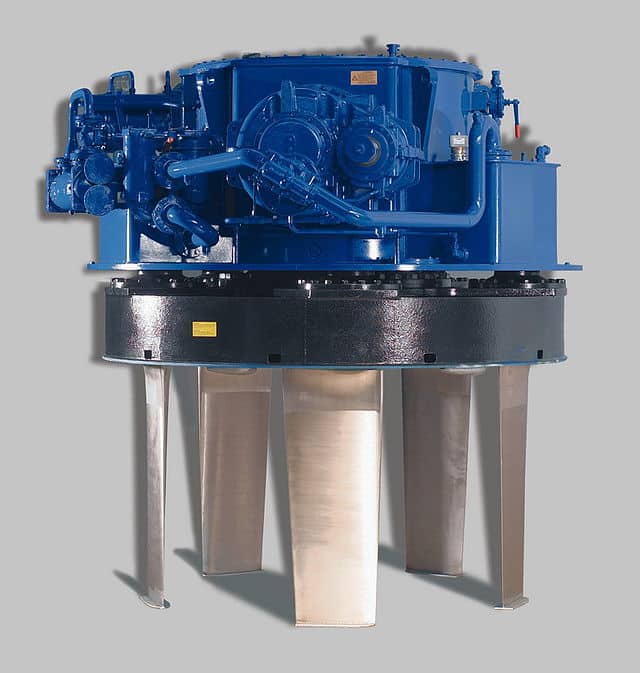
But how does a rotation in a horizontal plane impart thrust to the ship? Here’s the answer. The blades themselves can be adjusted to have a varying angle of attacks during the operation of the propeller. Depending on that, the direction and magnitude of thrust are varied. Well, if we are manipulating the direction of the thrust too, then we don’t actually need a rudder. Which is actually why a Voith propeller acts as a combined propulsion and steering system for the ship.
It is of no doubt that propulsion and steering systems have been innovated and invented to a great extent when compared to many other aspects in the ship design industry which still require the eyes of modern technological applications. However, as we are transiting into an era of faster, and environmentally safer technologies, newer hull forms are being developed. This has given the industry a wider scope to develop and design newer steering systems for the future.
- Understanding the shipbuilding process
- Types of vibrations on ships
- Understanding the design of bulk carriers
Article In Pictures

Disclaimer : The information contained in this website is for general information purposes only. While we endeavour to keep the information up to date and correct, we make no representations or warranties of any kind, express or implied, about the completeness, accuracy, reliability, suitability or availability with respect to the website or the information, products, services, or related graphics contained on the website for any purpose. Any reliance you place on such information is therefore strictly at your own risk.
In no event will we be liable for any loss or damage including without limitation, indirect or consequential loss or damage, or any loss or damage whatsoever arising from loss of data or profits arising out of, or in connection with, the use of this website.

Do you have info to share with us ? Suggest a correction

About Author
Soumya is pursuing Naval Architecture and Ocean Engineering at IMU, Visakhapatnam, India. Passionate about marine design, he believes in the importance of sharing maritime technical knowhow among industry personnel and students. He is also the Co-Founder and Editor-in-Chief of Learn Ship Design- A Student Initiative.
Read More Articles By This Author >
Daily Maritime News, Straight To Your Inbox
Sign Up To Get Daily Newsletters
Join over 60k+ people who read our daily newsletters
By subscribing, you agree to our Privacy Policy and may receive occasional deal communications; you can unsubscribe anytime.

BE THE FIRST TO COMMENT
If you can try and give the semi balance rudder pintles clearances which we have to keep maximum and minimum. If you can give me in detail I would be mush happy. Thank you
Distance of rudder from the stern frame should be how much ?
by seeing how we find which type of rudder it is
can u plz explain how does the load is transmitted to rudder from steering gear?????
@Subhash: Please check this article: https://www.marineinsight.com/naval-architecture/understanding-steering-gear-ships/
It was informative. I like your materials very much. I think a few more things could be added here. You mentioned nothing about so called Rotor Rudders, nor the T-Rudders ( combination of Flap + Rotor). Also Schilling rudders, which have very specific hydrodinamic shape, could be mentioned. Combination of Twin Schilling rudders is actually astonishingly mobile.
Thank you for the value addition
Leave a Reply
Your email address will not be published. Required fields are marked *
Subscribe to Marine Insight Daily Newsletter
" * " indicates required fields
Marine Engineering
Marine Engine Air Compressor Marine Boiler Oily Water Separator Marine Electrical Ship Generator Ship Stabilizer
Nautical Science
Mooring Bridge Watchkeeping Ship Manoeuvring Nautical Charts Anchoring Nautical Equipment Shipboard Guidelines
Explore
Free Maritime eBooks Premium Maritime eBooks Marine Safety Financial Planning Marine Careers Maritime Law Ship Dry Dock
Shipping News Maritime Reports Videos Maritime Piracy Offshore Safety Of Life At Sea (SOLAS) MARPOL
WAIT! Did You Download 13 FREE Maritime eBooks?
Sign-up and download instantly!
We respect your privacy and take protecting it very seriously. No spam!

My Cruiser Life Magazine
All About the Rudder on a Sailboat
The rudder on a sailboat is one of those important parts that often gets overlooked. It’s hidden underwater most of the time and usually performs as expected when we ask something of it.
But when was the last time you seriously considered your sailboat rudder? Do you have a plan if it fails? Here’s a look at various designs of sail rudder, along with the basics of how it works and why it’s there.
Table of Contents
How are sailboat rudders different than keels, how does the rudder work, wheel steering vs. tiller steering, full keel rudder sailboat, skeg-hung rudders, spade rudder, variations on designs, emergency outboard rudder options, looking to sail into the sunset grab the wheel, steer your sail boat rudder, and get out there, sail boat rudder faqs.
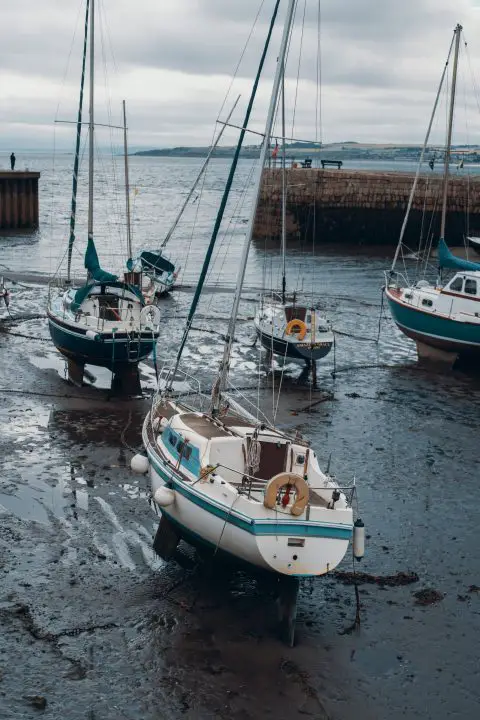
What Is a Boat Rudder?
The rudder is the underwater part of the boat that helps it turn and change direction. It’s mounted on the rear of the boat. When the wheel or tiller in the cockpit is turned, the rudder moves to one side or another. That, in turn, moves the boat’s bow left or right.
When it comes to sailing, rudders also offer a counterbalance to the underwater resistance caused by the keel. This enables the boat to sail in a straight line instead of just spinning around the keel.
Sailboat hull designs vary widely when you view them out of the water. But while the actual shape and sizes change, they all have two underwater features that enable them to sail–a rudder and a keel.
The rudder is mounted at the back of the boat and controls the boat’s heading or direction as indicated by the compass .
The keel is mounted around the center of the boat. Its job is to provide a counterbalance to the sails. In other words, as the wind presses on the sails, the weight of the ballast in the keel and the water pressure on the sides of the keel keeps the boat upright and stable.
When sailing, the keel makes a dynamic force as water moves over it. This force counters the leeway made by air pressure on the sails and enables the boat to sail windward instead of only blowing downwind like a leaf on the surface.
The rudder is a fundamental feature of all boats. Early sailing vessels used a simple steering oar to get the job done. Over the years, this morphed into the rudder we know today.
However, thinking about a rudder in terms of a steering oar is still useful in understanding its operation. All it is is an underwater panel that the helmsperson can control. You can maintain a course by trailing the oar behind the boat while sailing. You can also change the boat’s heading by moving it to one side or the other.
The rudders on modern sailboats are a little slicker than simple oars, of course. They are permanently mounted and designed for maximum effectiveness and efficiency.
But their operating principle is much the same. Rudders work by controlling the way water that flows over them. When they move to one side, the water’s flow rate increases on the side opposite the turn. This faster water makes less pressure and results in a lifting force. That pulls the stern in the direction opposite the turn, moving the bow into the turn.
Nearly all boats have a rudder that works exactly the same. From 1,000-foot-long oil tankers to tiny 8-foot sailing dinghies, a rudder is a rudder. The only boats that don’t need one are powered by oars or have an engine whose thrust serves the same purpose, as is the case with an outboard motor.
Operating the Rudder on a Sailboat
Rudders are operated in one of two ways–with a wheel or a tiller. The position where the rudder is operated is called the helm of a boat .
Ever wonder, “ What is the steering wheel called on a boat ?” Boat wheels come in all shapes and sizes, but they work a lot like the wheel in an automobile. Turn it one way, and the boat turns that way by turning the rudder.
A mechanically simpler method is the tiller. You’ll find tiller steering on small sailboats and dinghies. Some small outboard powerboats also have tiller steering. Instead of a wheel, the tiller is a long pole extending forward from the rudder shaft’s top. The helmsperson moves the tiller to the port or starboard, and the bow moves in the opposite direction. It sounds much more complicated on paper than it is in reality.
Even large sailboats will often be equipped with an emergency tiller. It can be attached quickly to the rudder shaft if any of the fancy linkages that make the wheel work should fail.
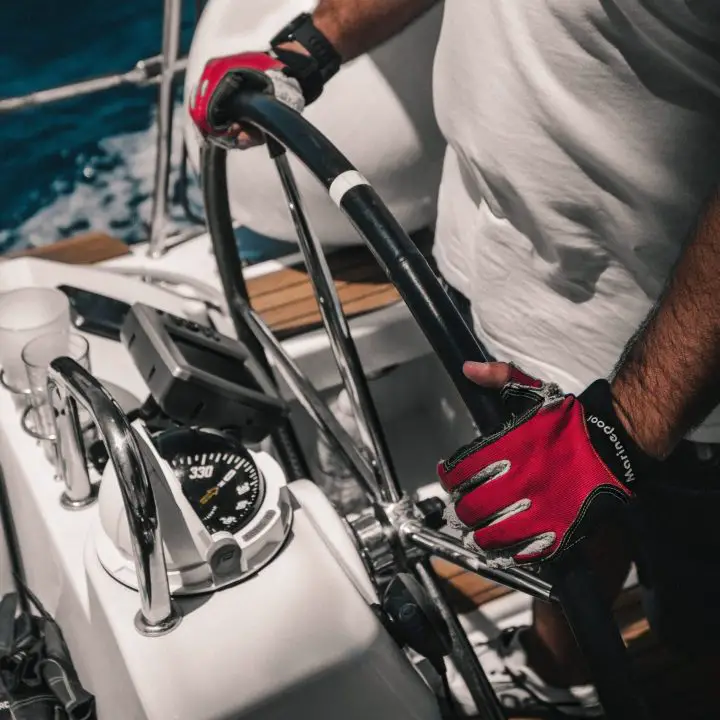
Various Sail Boat Rudder Designs
Now, let’s look at the various types of rudders you might see if you took a virtual walk around a boatyard. Since rudders are mostly underwater on the boat’s hull, it’s impossible to compare designs when boats are in the water.
Keep in mind that these rudders work the same way and achieve the same results. Designs may have their pluses and minuses, but from the point of view of the helmsperson, the differences are negligible. The overall controllability and stability of the boat are designed from many factors, and the type of rudder it has is only one of those.
You’ll notice that rudder design is closely tied to keel design. These two underwater features work together to give the boat the sailing characteristics the designer intended.
The classic, robust offshore sailboat is designed with a full keel that runs from stem to stern. With this sort of underwater profile, it only makes sense that the rudder would be attached to the trailing edge of that enormous keel. On inboard-powered sailboats, the propeller is usually mounted inside an opening called the aperture between the keel and rudder.
The advantages of this design are simplicity and robustness. The keel is integrated into the hull and protects the rudder’s entire length. Beyond reversing into an obstacle, anything the boat might strike would hit the keel first and would be highly unlikely to damage the rudder. Not only does the keel protect it, but it also provides a very strong connection point for it to be attached to.
Full keel boats are known for being slow, although there are modern derivatives of these designs that have no slow pokes. Their rudders are often large and effective. They may not be the most efficient design, but they are safe and full keels ride more comfortably offshore than fin-keeled boats.
Plenty of stout offshore designs sport full keel rudders. The Westsail 38s, Lord Nelsons, Cape Georges, Bristol/Falmouth Cutters, or Tayana 37s feature a full keel design.
A modified full keel, like one with a cutaway forefoot, also has a full keel-style rudder. These are more common on newer designs, like the Albergs, Bristols, Cape Dorys, Cabo Ricos, Island Packets, or the older Hallberg-Rassys.

A design progression was made from full keel boats to long-fin keelboats, and the rudder design changed with it. Designers used a skeg as the rudder became more isolated from the keel. The skeg is a fixed structure from which you can mount the rudder. This enables the rudder to look and function like a full keel rudder but is separated from the keel for better performance.
The skeg-hung rudder has a few of the same benefits as a full keel rudder. It is protected well and designed robustly. But, the cutaways in the keel provide a reduced wetted surface area and less drag underwater, resulting in improved sailing performance overall.
Larger boats featuring skeg-mounted rudders include the Valiant 40, Pacific Seacraft 34, 37, and 40, newer Hallberg-Rassys, Amels, or the Passport 40.
It’s worth noting that not all skegs protect the entire rudder. A partial skeg extends approximately half the rudder’s length, allowing designers to make a balanced rudder.
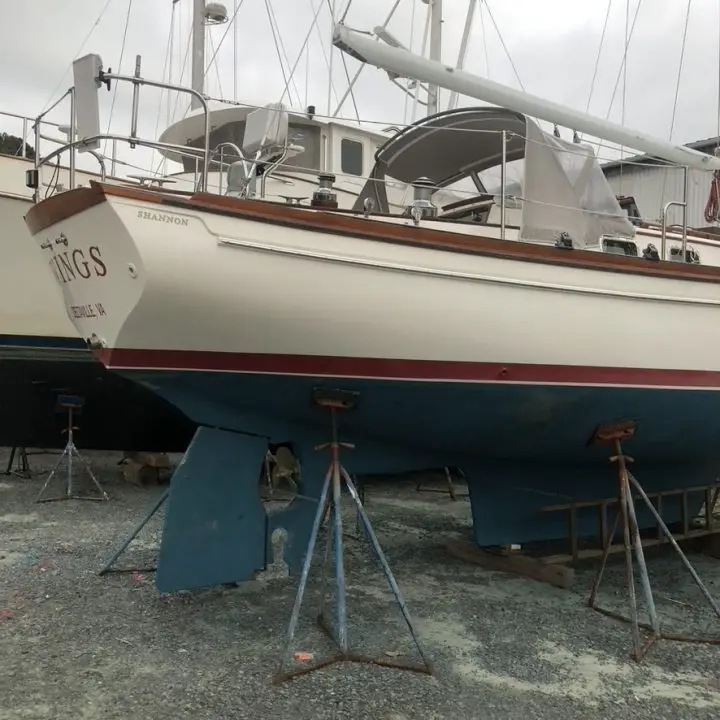
With higher-performance designs, keels have become smaller and thinner. Fin keel boats use more hydrodynamic forces instead of underwater area to counter the sail’s pressure. With the increased performance, skegs have gone the way of the dinosaurs. Nowadays, rudders are sleek, high aspect ratio spade designs that make very little drag. They can be combined with a number of different keel types, including fin, wing keels , swing keels, or bulb keels.
The common argument made against spade rudders is that they are connected to the boat by only the rudder shaft. As a result, an underwater collision can easily bend the shaft or render the rudder unusable. In addition, these rudders put a high load on the steering components, like the bearings, which are also more prone to failure than skeg or full keel designs. For these reasons, long-distance cruisers have traditionally chosen more robust designs for the best bluewater cruising sailboats .
But, on the other hand, spade rudders are very efficient. They turn the boat quickly and easily while contributing little to drag underwater.
Spade rudders are common now on any boat known for performance. All racing boats have a spade rudder, like most production boats used for club racing. Pick any modern fin keel boat from Beneteau, Jeanneau, Catalina, or Hunter, and you will find a spade rudder. Spade rudders are common on all modern cruising catamarans, from the Geminis to the Lagoons, Leopards, and Fountaine Pajots favored by cruisers and charter companies.
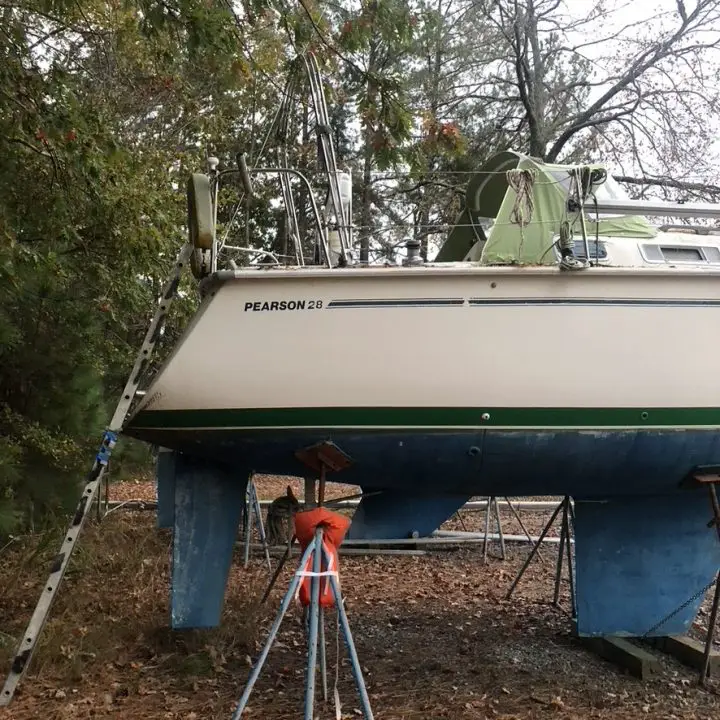
Here are two alternative designs you might see out on the water.
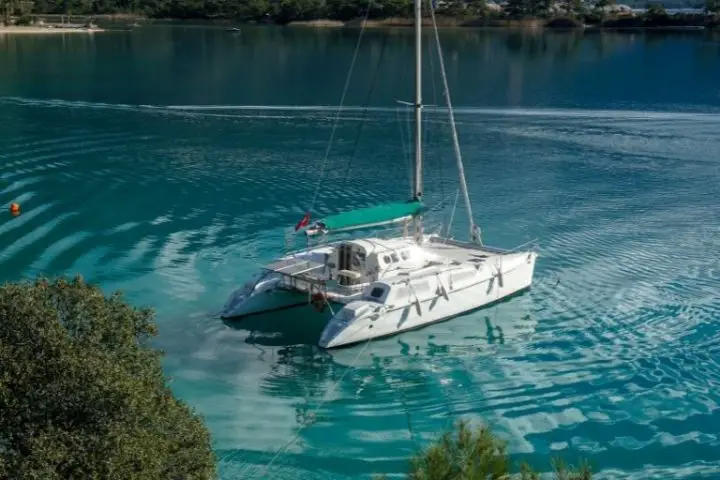
Transom-Hung or Outboard Rudders
An outboard rudder is hung off the boat’s transom and visible while the boat is in the water. Most often, this design is controlled by a tiller. They are common on small sailing dingies, where the rudder and tiller are removable for storage and transport. The rudder is mounted with a set of hardware called the pintle and gudgeon.
Most outboard rudders are found on small daysailers and dinghies. There are a few classic big-boat designs that feature a transom-hung rudder, however. For example, the Westsail 38, Alajuela, Bristol/Falmouth Cutters, Cape George 36, and some smaller Pacific Seacrafts (Dana, Flicka) have outboard rudders.
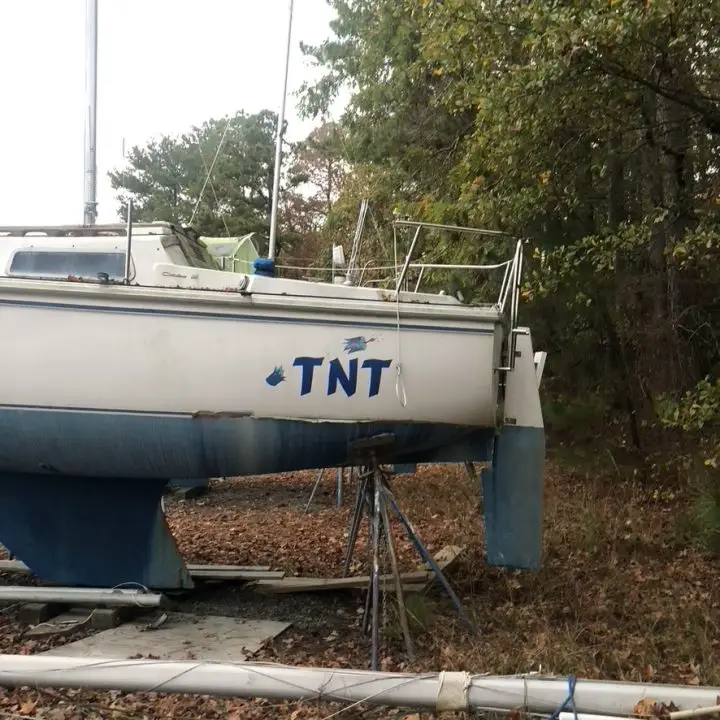
Twin Sailing Rudder Designs
A modern twist that is becoming more common on spade rudder boats is the twin sailboat rudder. Twin rudders feature two separate spade rudders mounted in a vee-shaped arrangement. So instead of having one rudder pointed down, each rudder is mounted at an angle.
Like many things that trickle down to cruising boats, the twin rudder came from high-performance racing boats. By mounting the rudders at an angle, they are more directly aligned in the water’s flow when the boat is healed over for sailing. Plus, two rudders provide some redundancy should one have a problem. The twin rudder design is favored by designers looking to make wide transom boats.
There are other, less obvious benefits of twin rudders as well. These designs are easier to control when maneuvering in reverse. They are also used on boats that can be “dried out” or left standing on their keel at low tide. These boats typically combine the twin rudders with a swing keel, like Southerly or Sirius Yachts do. Finally, twin rudders provide much better control on fast-sailing hulls when surfing downwind.
Unbalanced vs. Balanced Rudders
Rudders can be designed to be unbalanced or balanced. The difference is all in how they feel at the helm. The rudder on a bigger boat can experience a tremendous amount of force. That makes turning the wheel or tiller a big job and puts a lot of strain on the helmsperson and all of the steering components.
A balanced rudder is designed to minimize these effects and make turning easier. To accomplish this, the rudder post is mounted slightly aft of the rudder’s forward edge. As a result, when it turns, a portion of the leading edge of the rudder protrudes on the opposite side of the centerline. Water pressure on that side then helps move the rudder.
Balanced rudders are most common in spade or semi-skeg rudders.
Sail Rudder Failures
Obviously, the rudder is a pretty important part of a sailboat. Without it, the boat cannot counter the forces put into the sails and cannot steer in a straight line. It also cannot control its direction, even under power.
A rudder failure of any kind is a serious emergency at sea. Should the rudder be lost–post and all–there’s a real possibility of sinking. But assuming the leak can be stopped, coming up with a makeshift rudder is the only way you’ll be able to continue to a safe port.
Rudder preventative maintenance is some of the most important maintenance an owner can do. This includes basic things that can be done regularly, like checking for frayed wires or loose bolts in the steering linkage system. It also requires occasionally hauling the boat out of the water to inspect the rudder bearings and fiberglass structure.
Many serious offshore cruisers install systems that can work as an emergency rudder in extreme circumstances. For example, the Hydrovane wind vane system can be used as an emergency rudder. Many other wind vane systems have similar abilities. This is one reason why these systems are so popular with long-distance cruisers.
There are also many ways to jury rig a rudder. Sea stories abound with makeshift rudders from cabinet doors or chopped-up sails. Sail Magazine featured a few great ideas for rigging emergency rudders .
Understanding your sail rudder and its limitations is important in planning for serious cruising. Every experienced sailor will tell you the trick to having a good passage is anticipating problems you might have before you have them. That way, you can be prepared, take preventative measures, and hopefully never deal with those issues on the water.
What is the rudder on a sailboat?
The rudder is an underwater component that both helps the sailboat steer in a straight line when sailing and turn left or right when needed.
What is the difference between a rudder and a keel?
The rudder and the keel are parts of a sailboat mounted underwater on the hull. The rudder is used to turn the boat left or right, while the keel is fixed in place and counters the effects of the wind on the sails.
What is a rudder used for on a boat?
The rudder is the part of the boat that turns it left or right
Matt has been boating around Florida for over 25 years in everything from small powerboats to large cruising catamarans. He currently lives aboard a 38-foot Cabo Rico sailboat with his wife Lucy and adventure dog Chelsea. Together, they cruise between winters in The Bahamas and summers in the Chesapeake Bay.
Leave a comment
Your email address will not be published. Required fields are marked *
Save my name, email, and website in this browser for the next time I comment.
Knots & Thoughts
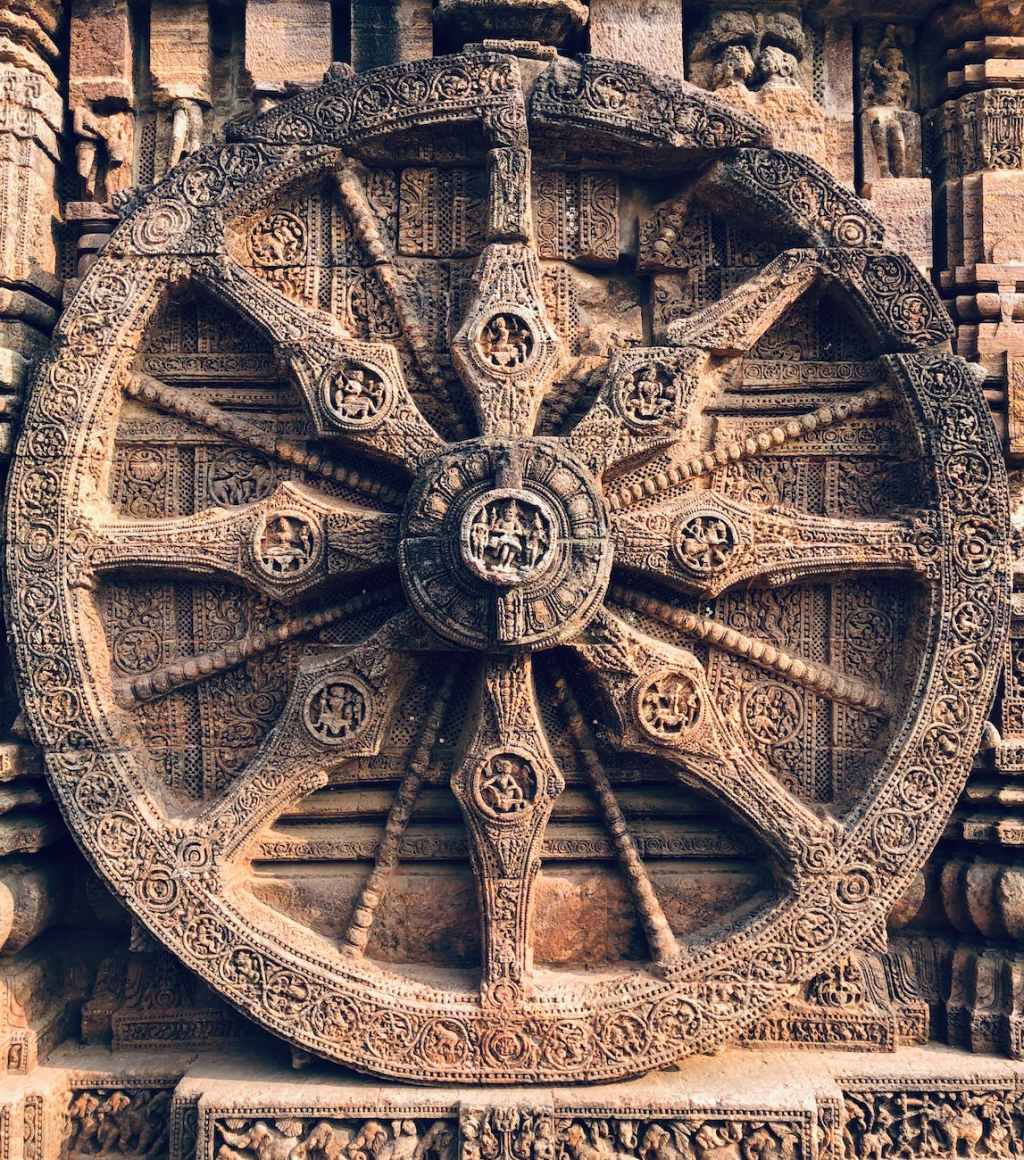
Navigating Rudder Types: A Comprehensive Guide for Boaters
Ahoy, fellow boaters! Have you ever thought about what propels boats forward and how they maneuver in the water? The answer lies in a boat’s rudder. Without a rudder, your vessel would be like a leaf floating in the wind—directionless and adrift! In this blog post, we’ll take a deep dive into different types of rudders and how they affect a boat’s performance. So let’s get started on our journey to understanding all the different types of rudders.
When you buy a boat, it’s important to know the ins and outs of the boat you’re buying – including what type of rudder it has. A rudder is one of the most important parts of a boat as it helps steer or control the direction in which your boat goes. In this blog post we will discuss the different types of rudders and how they work.
What do a spade rudder, an outboard rudder, and a full keel rudder have in common? They’re all types of rudders! But did you know that there are other types of rudders? In this blog post, we will explore the basics of what makes a rudder and how different types of rudders can be used to navigate different boats. We’ll look at skeg-mounted rudders, twin rudders, fin keels, and more! So strap on your life preservers and get ready to learn about boat navigation with rudders.
Spade Rudder
A spade rudder is one of the most common types of rudders used on sailboats. It is usually mounted on the back (transom) or off one side of the boat on an outboard rudder. Spade rudders provide excellent directional control when cruising or racing, but require more effort when steering due to their large size and weight. Outboard Rudders – An outboard rudder is typically found on smaller boats like dinghies, kayaks, and canoes and may be made from wood or plastic. Outboard rudders are lightweight and inexpensive compared to other types of rudders, but they don’t provide as much control as larger rudders do. Full Keel Rudders – Full keel boats are typically equipped with full keel rudders that are built into the hull itself. These heavy-duty rudders provide excellent directional control even in rough waters due to their large size and because they are mounted closer to the centerline of the boat.
Skeg-Mounted Rudders
On some boats with fin keels (smaller sailboats), skeg-mounted rudders may be used instead of full keel type ones. Skeg-mounted rudders have less surface area than full keel ones so they require less force from the water to turn them effectively. Twin Rudders – Twin or double-headed (two separate) rudders are sometimes used on larger sailing boats for additional control in rough water conditions or for improved maneuverability when tacking or jibing (changing direction). Twin Rudders should always be mounted symmetrically so that each half gets equal pressure from the flow of water around them; otherwise, one side will overpower the other and make steering difficult.
Spade Rudders are probably the most common type of rudder found on boats. They are usually attached to the back of the boat with a rudder post and held in place with a stainless steel stock known as a rudder blade. These are great for smaller boats because they don’t require much force from water pressure in order to turn them. Outboard Rudders are typically used on larger boats such as sailboats, as they make steering easier due to their larger size. They are mounted on either side of the hull, near the rear of the vessel and connected by a rudder tube that runs through both sides. The force of water on each side causes them to move in unison for better control over direction and course changes.
Skeg-mounted Rudders are another option that can be used on both small and large boats alike. This type is mounted beneath a fin keel or full keel along with an outboard motor at the stern end of the boat. These allow for more maneuverability than other types because they take advantage of both water flow around them and smaller fins below them which help keep them steady in rough waters. Twin Rudders can also be used on larger vessels when extra control is needed due to their size or speed. They provide more control by having two independent rudders placed at opposite ends of the vessel; this allows for greater control over turning and directional changes in open waters or even shallow ones where extra drag may be present due to shallow depths or obstructions like rocks or sand bars.
What is a Rudder?
A rudder is a flat plate or blade that is attached to the stern (or back) of a boat. It is typically connected to the steering mechanism through either a wheel or tiller (a long handle). The purpose of the rudder is to turn the boat from side to side by redirecting the flow of water against it. When angled correctly in the water, it creates an opposite force which turns the boat. Rudders can be made from wood or metal such as stainless steel.
Skeg-Mounted Rudders vs Outboard Rudders
Skeg-mounted and outboard rudders are two of the most popular types of rudders. Skeg-mounted rudders attach directly to the sternpost or keel while outboard rudders attach directly onto brackets mounted outside of the vessel’s hull. Skeg-mounted rudders are usually found on smaller boats because they provide better control in shallow waters and require less maintenance than their outboard counterparts. Outboard rudders are typically used for larger vessels due to their greater control in rough waters and their ability to withstand higher levels of water pressure without failure.
Full Keel vs Fin Keel Rudders
Full keel and fin keel rudders are two other popular types of rudder designs. Full keels provide greater stability and better protection against drag which makes them ideal for sailing boats with large sails or heavier loads like full keel sailboats. Fin Keels are designed for smaller boats with lighter loads like fin keeled sailboats or motorboats as they offer superior maneuverability and more responsive steering when compared with full keels due to their smaller surface area creating less force against the water flow. Their design also allows them to be tucked up under the hull when not in use so they don’t cause extra drag while underway.
Twin Rudders & Modern Rudders
Twin Rudder systems are becoming increasingly popular among naval architects as they provide increased control over larger vessels like catamarans that require two separate steering systems working together for optimal performance in rough waters or strong currents. Modern Rudders also feature advanced design elements such as curved blades which help reduce drag by allowing water flow around them more efficiently than traditional flat blades would allow thus decreasing fuel consumption and increasing speed potential for powerboat applications where every second counts! Additionally, modern designs often incorporate rudder bearings such as roller bearings which reduce friction between surfaces leading to smoother steering action even at high speeds!
As you can see there are many different types of rudders available for use on sailboats today–each with its own advantages and disadvantages depending on your vessel’s size, design, and intended use. Understanding which type will best suit your needs requires knowledge about naval architecture principles such as balance between force applied by water flow against a rudder stock versus size/area of a rudder blade; drag caused by stainless steel bearings in a rudder tube; angle at which water enters/leaves a full rudder; depth/size ratio for smaller vessels; etc… But fear not! With some research (and maybe help from an experienced naval architect) you can find just what you need to steer your ship through any sea condition like an old salt!
No matter what type of vessel you own, understanding its rudder system is essential for safe navigation while out at sea! Different types offer varying levels of maneuverability depending on your needs – whether it’s just getting from point A to point B or navigating tricky shallow waters with lots of obstacles – so make sure to weigh your options carefully before deciding which one is right for you and your boat design! With modern rudders featuring roller bearings and stainless steel construction, you’ll have no problem finding one that fits your needs perfectly – just make sure not to forget about proper maintenance so that you can avoid any unwanted rudder failure!
Rudder selection depends greatly on whether you want maximum maneuverability or maximum stability; full keels provide greater stability while fin keels provide better maneuverability depending on your type of boat and its intended purpose. Regardless if you choose skeg-mounted, outboard, twin, full keel, fin keel, or modern rudder designs; selecting an appropriate size based on your vessel’s length overall will ensure proper performance so make sure you check that before making any final decisions! With this comprehensive guide now firmly tucked away within your brain bank you should now be able to select just about any type of sailboat rudder! So grab hold of your tiller (or wheel) once again sailors—the sea awaits us! Happy sailing!
You might also check out our post: The Battle of the Anchors | How to Choose the Right Anchor for your Boat
AND DON’T FORGET!!!!!! S-arrrr-bscribe!
If you enjoyed this blog and support our mission of bringing folks a rippin’ good time and dishing out some knowledge while we’re at it… Give us some booty! Who doesn’t need booty after all?
Share this:
Leave a reply cancel reply.

- Already have a WordPress.com account? Log in now.
- Subscribe Subscribed
- Copy shortlink
- Report this content
- View post in Reader
- Manage subscriptions
- Collapse this bar
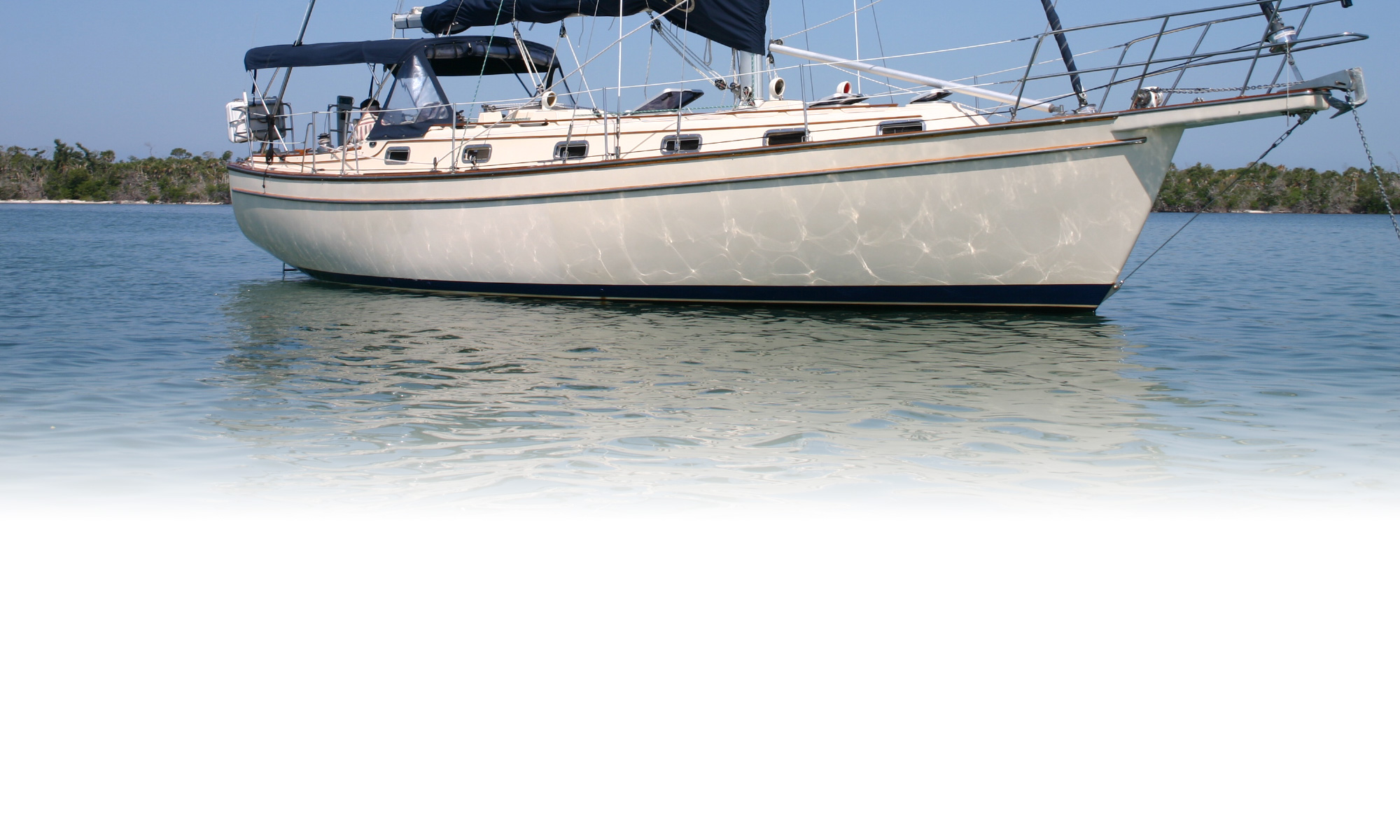
New Rudders
Replacement Sailboat Rudders and Centerboards
Four Types of Rudders On Sailboats
The four rudder types are: full rudder, spade rudder, skeg rudder, and outboard rudder. We will discuss the advantages and disadvantages of each.
Full Rudder
The full or full keel rudder is at the aft end of a full length keel. The keel-rudder runs along the entire length of the bottom of the boat’s hull. This full length rudder is safe and more resistant to damage. The leading edge of the keel protects the rudder from debris. The full rudder is a trademark of offshore cruisers like Cabo Ricos and Wetsails. Damage may be avoided even when grounding. The boat will rest safely on its side until the tide returns and lifts the boat off the shoal.
Spade Rudder
The spade rudder rests below the transom separate from the keel. A spade rudder turns easily because the water rushes both against its fore and aft edges – good when using a tiller. There’s less wet area so the spade rudder is fast. The spade, along with partial spade rudders are becoming popular in many sailboat designs.
Skeg Rudder
Compared to other styles, the skeg rudder is modern in safety and performance and popular on current production boats. The skeg rudder is similar to a spade keel and is fast. The skeg rudder’s fore edge is protected by a “faux keel” that extends from aft of the hull. Hylas yachts are known for their skeg rudders.
Outboard Rudder
Outboard rudders are used on smaller boats. They are attached to the transom of the boat, hanging off the stern. Racing prams employ outboard rudders. They are also easy to jerry rig as emergency rudders. Any long piece of metal and flat piece of wood, as in a cabin door, can work.
Each type of rudder has its advantages and disadvantages. Most importantly, inspect your rudder regularly and carry a spare.
Foss Foam products can create a replacement rudder for your sailboat. Contact us for more information.
- Anchoring & Mooring
- Boat Anatomy
- Boat Culture
- Boat Equipment
- Boat Safety
- Sailing Techniques
Rudder Revolution: The Ultimate Guide to Boat Rudders
A rudder is a critical component of a sailboat, allowing the boat to steer and change direction. Without one, a sailboat would be at the mercy of the wind and waves, making it nearly impossible to navigate and control.
A rudder is a flat blade attached to the stern of a boat that can be turned to change the boat’s direction. There are several types, each with unique characteristics, advantages, and disadvantages. This article will closely examine a rudder’s purpose, history, parts, styles, and function.
Key Takeaways
- A sailboat rudder is a flat plate or blade attached to a boat's stern, used to control the boat's direction and enhance its stability and performance.
- The rudder's design has evolved over time, and modern advances in materials and technology have led to further improvements in its function and efficiency.
- Different types of rudders include full-spade, semi-balanced, and skeg-hung, each with varying sizes and shapes depending on their purpose.
- The rudder consists of four primary components: the shaft, blade, tiller, and stock, all of which must be precisely aligned and maintained for optimal performance.
What is a sailboat rudder?
A sailboat rudder is a flat plate or blade attached to a boat’s stern . It is usually made of wood, fiberglass, or metal, and it can vary in size and shape depending on the type of boat. Different types of rudders, including spade, transom-hung, and balanced rudders, serve another purpose.
The purpose of a rudder is to control the boat’s direction as it helps stability and enhances the boat maintain s performance. It also enables the boat to manoeuvre in tight spaces like harbors and marinas. A rudder is essential for navigation and improves safety and maneuverability.
History of the boat rudder
The concept of the rudder has been around for thousands of years, and its design has evolved. The rudder was a simple, unbalanced blade fastened outside the hull in ancient times.
It became a more balanced design during the Middle Ages, allowing for better control and manoeuvrability. In modern times, advances in materials and technology have led to further improvements in design.
In the modern era, shipbuilding and navigation technology have advanced significantly, resulting in more refined and efficient rudders. This is evident in hydraulic and electronic steering systems, which give sailors greater control over their sailboats.
One of the most notable innovations is improved materials, such as fibreglass and composites. These materials are stronger, lighter, and more durable than traditional materials, making sailboats more accessible and enjoyable for a broader range of people.
Another example of recent innovation is the use of advanced steering systems, such as self-feathering propellers and retractable rudders. These systems have revolutionized how sailboats are controlled, providing sailors greater control and maneuverability in all conditions.
The rudder is also critical in competitive sailing, where the design and performance can often determine the outcome of a race. In this high-stakes environment, sailors depend on precise control and manoeuvrability, especially in challenging conditions such as strong winds and rough seas.
For example, the America’s Cup, one of the world’s oldest and most prestigious sailing events, is a testament to the importance of rudder technology in competitive sailing.
In recent years, America’s Cup has seen cutting-edge designs and technology, including advanced materials, hydraulic and electronic steering systems, and even wings and foils to increase stability and speed.
Similarly, the Volvo Ocean Race, a round-the-world sailing race, demonstrates rudder technology’s importance in competitive sailing. The harsh conditions encountered during the race, including high winds and rough seas, require advanced steering systems to ensure the sailors’ and their ships’ safety and success.
How does a rudder work?
Boats have rudders because they are essential for navigation. The rudder allows the ship to turn in the desired direction, making it easier to steer and avoid obstacles.
They also improve safety and manoeuvrability and increase the ship’sefficiency and speed. A sailboat rudder works by directing the flow of water.
The rudder is turned by a mechanism, such as a tiller or a wheel, and this movement changes the direction of the water flow, causing the boat to turn in the desired order. The forces acting on it include the water flow, the wind, and the boat’s movement.
As mentioned, its primary function is to steer the boat and control its direction, keeping it on course by adjusting to changes in wind and currents. When the tiller is turned, the blade moves to one side, creating a turning force and causing the boat to change direction.
The rudder also helps to increase stability by reducing the boat’s roll and improving its handling in rough conditions. Turning the rudder in the opposite direction to that of the turn rises stability, helping to ensure smooth, controlled manoeuvring. Setting the correct angle when turning is essential, as too much or too little can cause instability or lack of control.
By redirecting the flow of water around the hull, the rudder creates a force that reduces roll, or the side-to-side movement of the boat, which can make sailing difficult. Additionally, having control over that force enables sailors to adjust the course of their vessel quickly and precisely in even the most challenging waters.
Types of rudders
The full-spade rudder is a popular choice for many sailors, characterized by its large, spade-shaped design that extends down into the water. It offers increased control and manoeuvrability due to its expansive surface area, making it easier for the sailor to make quick and precise turns.
It also provides increased stability, allowing the boat to withstand choppy waters or high-speed turns more easily. However, its large size can cause drag, reducing the boat’s efficiency, and it is more vulnerable to damage in shallow water due to its size.
Semi-balanced
Sailors who want a good balance of control and stability often choose the semi-balanced rudder, which is more compact than its full-spade counterpart. It offers improved maneuverability due to its streamlined shape and reduced drag, allowing the boat to move quickly through the water.
Additionally, it provides a reasonable degree of stability, making it suitable for sailors who don’t require maximum control in turbulent conditions.
However, a few drawbacks are also worth noting. The semi-balanced rudder has less stability than the full-spade model and can be more fragile in rough waters . Additionally, its smaller size decreases control and may not be suitable for experienced sailors who need maximum manoeuvrability.
The skeg-hung rudder is an excellent choice for sailors prioritising stability and efficiency. This type has a large blade mounted on a long, narrow fin that extends downward from the boat’s hull, which provides stability and reduces drag. The key advantages of this design are greater stability in rough conditions and improved speed and efficiency.
However, this style is less manoeuvrable than full-spade or semi-balanced, so there may be better choices for sailors looking to make quick and precise turns. Additionally, the skeg-hung version may be more susceptible to damage when navigating shallow or rocky waters, such as groundings or impacts.
Boats with two rudders are designed to offer improved control, stability, and performance. The two are typically located near the stern of the boat, on either side of the keel. The broader base created by two rudders can help improve stability in rough conditions and allow for more precise navigation and quick course adjustments.
This can be especially important for competitive sailing events where performance is essential. Catamarans and trimarans are often explicitly designed with multiple rudders, while some larger vessels may use two to provide increased control and maneuverability in stronger winds or choppy seas.
Parts of a rudder
The rudder of a boat consists of four primary components – the shaft, blade, tiller, and stock. The vertical shaft connects the blade to the stern and allows up-and-down movements. The horizontally-oriented blade provides turning force when pushed by water flow.
Attached to the shaft is a lever known as the tiller, which controls direction. Finally, the stock is fixed onto the vessel’s stern and kept in place while allowing directional changes.
The shaft is essential for connecting the blade of a rudder to a boat. It’s crucial to select the suitable material for the shaft depending on what kind of sailing will be done. Marine grade stainless steel, aluminium, and composite materials are all common choices. The alignment of the shaft must be precise for efficient steering; if it is misaligned, manoeuvring the vessel can become difficult.
Understanding the shape and design of the blade is essential for ensuring your boat operates effectively. Different types of blades, such as curved, flat, and spoon-shaped, can be chosen based on the size of your vessel and the sailing you will be doing.
A well-designed blade provides efficient control and stability, while a poorly designed one may make it difficult to control. Choosing the right blade is essential in getting optimal performance from your vessel.
The tiller is essential to the boat’s steering system , as it connects and provides force to the rudder shaft. The alignment and tension of the tiller must be carefully adjusted to ensure smooth and effective direction control. If these components are adjusted correctly, it can result in excellent or smooth steering movements, which can be detrimental to the safety and performance of your vessel.
The stock is an integral part of the assembly and is responsible for transmitting tiller force to the blade. It must be securely attached to the boat’s hull to provide proper control and direction. A properly connected stock guarantees that your vessel will respond correctly when turned with the tiller.
The rudder is essential to any sailboat, providing critical steering and control that enables boats or ships to navigate successfully and safely. Over the centuries, the design and technology have evolved significantly, from simple steering oars to more advanced self-feathering propellers and retractable units.
Understanding different types, their function, and how to maintain them is vital for safe sailing. From wooden sailboats to modern racing yachts, the rudder continues to be a necessary part of navigation, ensuring stability and manoeuvrability. As technology continues to evolve, boaters can look forward to even more efficient and advanced rudders in the future.
Q: What is the purpose of a rudder on a boat?
A: The purpose of a rudder on a boat is to steer and maintain its direction. It helps the boat change direction by creating a turning force when the tiller is turned, and it increases stability by reducing the boat’s roll and improving its handling in rough conditions.
Q: How does a rudder work?
A: A rudder creates a turning force when the tiller is turned. The blade moves to one side, causing the boat to change direction. It also helps to increase stability by reducing the boat’s roll and improving its handling in rough conditions.
Q: What are the parts of a rudder?
A: The parts include the shaft, blade, tiller, and stock. The shaft connects the blade to the boat while the blade creates a turning force when moved across one side. The tiller is then used as a lever to steer while the stock attaches it all to the stern of your boat.
Q: What are the different types of rudders?
A: There are three main types of rudders – full-spade, semi-balanced, and skeg-hung – each with varying sizes and shapes depending on their purpose. Full-spade have large blades that extend below your hull, while semi-balanced ones have smaller ones that partially extend beneath them. Meanwhile, Skeg-hung has smaller blades attached to a skeg that extends below your hull.
Q: How does a rudder affect the performance of a boat?
A: A properly maintained rudder positively affects performance by providing precise control over steering and better control in choppy waters due to increased stability from reduced rollover risk. Poorly working rudders, however, can make controlling your vessel difficult, which can then lead to decreased performance overall
Steer clear of trouble: Boating in shoals
Understanding weather helm and its dangers, related posts, understanding the boom of a boat, understanding the importance of boat chines, hull speed calculator.
- Cookie Policy
- Privacy Statement
© 2023 TIGERLILY GROUP LTD, 27 Old Gloucester Street, London, WC1N 3AX, UK. Registered Company in England & Wales. Company No. 14743614
Welcome Back!
Login to your account below
Remember Me
Retrieve your password
Please enter your username or email address to reset your password.
Add New Playlist
- Select Visibility - Public Private

Rudders and steering systems – Part 1
by Simon Jollands | Boat Maintenance , Preparation , Yacht ownership
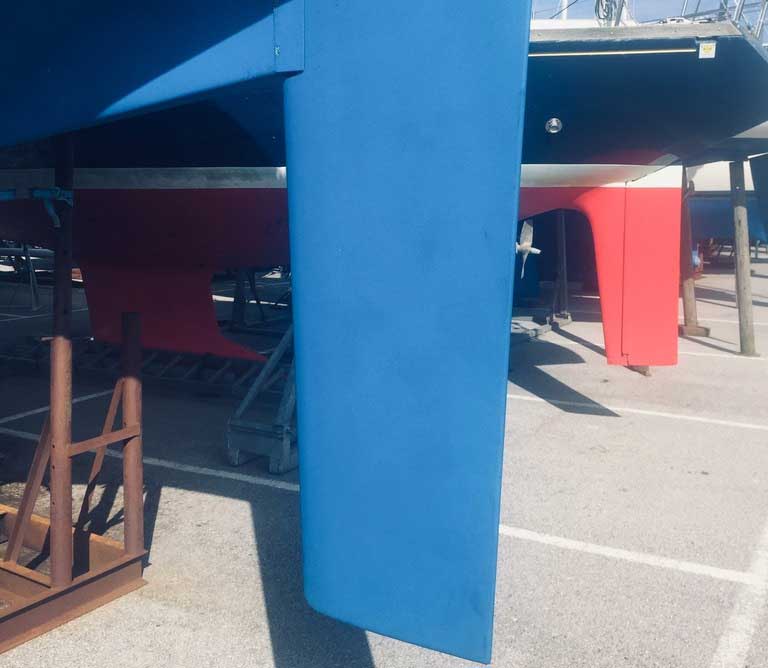
A rudder is one of the most critical parts of a boat. Rudder failure is a common occurrence on neglected or overworked boats and a very unpleasant and potentially dangerous thing to happen when you are out at sea.
It is important for a boat owner to fully understand how their boat’s steering system works. For example, do you know whether your rudder stock is hollow or solid? Is it made from stainless steel or aluminium, or is it composite? More importantly, do you understand how the system can fail? It is always best with boats to leave nothing to chance and and to know how to spot early signs of trouble. This particularly applies to rudders.

Spade rudder
The spade rudder system is common on many modern designs of both sail and power boats. This type is known as a balanced rudder, meaning that it pivots at a point well back from its forward edge (whereas transom hung rudders are referred to as unbalanced rudders). This makes it easier to turn than a transom hung rudder. A spade rudder is suspended beneath the hull, well astern of a fin keel.
Spade rudders have a rudder stock which reaches from the bottom of the rudder up into the hull. The stock can be hollow or solid and made from stainless steel, aluminium or composite materials. The rudder blade is built around the stock and reinforced with a frame which is welded to the stock. So when the rudder stock is turned, the frame and blade turn as one. The blade itself is usually made in two halves of fibreglass which are bonded together. The core is usually filled either with foam or plywood and occasionally is a solid laminate.
On most spade rudders, there are two bearings contained in a bearing tube. One of these bearings is at the point where the rudder stock enters the hull and another one higher up at the top of the tube which may also have a seal.
Spade rudders are subjected to considerable stresses and some experts would say are more vulnerable to failure than the old fashioned transom hung varieties. This is partly because they are hidden from sight and therefore difficult to inspect when afloat and partly because there is more that can go wrong if a spade rudder isn’t inspected regularly. The big issue is that it is very difficult to prevent water from getting into the core, causing corrosion and eventually, rudder failure.

Spade r udder checks :
- Check if water continues to drip from the rudder after the boat has been hauled out.
- Check for any rust-like stains on the the rudder surface, which are an indicator of crevice corrosion.
- Bearing failure – check bearings for excessive play when ashore by moving the bottom of the rudder blade from side to side. Up to 2mm play is acceptable.
- Check bearing tube to hull joint for any signs of cracking.
- Check the flexible rubber, bellows type of seal is in good order.
- Stiff steering can be caused by plastic bearing failure. Roller bearings can fail suddenly.
- Rudder stock failure – check seawater has not penetrated the bearing tube which will cause a stainless steel rudder stock to corrode and eventually fail. The rudder stock’s lower bearing where it enters the bearing tube should be inspected for excessive play or signs of crevice corrosion and galvanic corrosion. Check the shaft seal for signs of leaking. If it is leaking it needs to be replaced. Check the upper part of the bearing tube is well supported and not showing any signs of movement.
- Framework failure – check for water penetration into the rudder blade. This can cause corrosion of the metal frame, resulting in the rudder stock breaking away and failing to turn the blade. Check if there is any movement between the rudder and the rudder stock. If so, the rudder will need to be repaired or replaced.
- Delamination – check the rudder blade for bulges which indicates water has penetrated the rudder and is causing delamination. Check the edges of the blade for signs of cracking or splits which could allow water to penetrate the blade.


Learn ColRegs: Traffic Separation Schemes
How a propeller works.
Have a look around any boatyard and you will notice quite a variety of propellers – some have two blades, some have three and others have four or more. While most propellers are completely rigid some have blades that fold.
Five dangers a vessel may encounter at sea
What are the main dangers a vessel may face at sea and what should skippers do to reduce the risk of these happening?
Navigating Through Rough Waters: Tips for Handling Adverse Weather Conditions in a Sailboat - Safe Skipper Boating & Safety Afloat Apps for phones & tablets
www.safe-skipper.com
Share on Facebook Share on Twitter Share on Linked In Share by Email
safe_skipper_apps

Recent Posts
- Navigating Through Rough Waters: Tips for Handling Adverse Weather Conditions in a Sailboat
- Docking a Motorboat
- Sailing Safely at Night – Best Practice
- Navigating narrow channels
- New Sailboats
- Sailboats 21-30ft
- Sailboats 31-35ft
- Sailboats 36-40ft
- Sailboats Over 40ft
- Sailboats Under 21feet
- used_sailboats
- Apps and Computer Programs
- Communications
- Fishfinders
- Handheld Electronics
- Plotters MFDS Rradar
- Wind, Speed & Depth Instruments
- Anchoring Mooring
- Running Rigging
- Sails Canvas
- Standing Rigging
- Diesel Engines
- Off Grid Energy
- Cleaning Waxing
- DIY Projects
- Repair, Tools & Materials
- Spare Parts
- Tools & Gadgets
- Cabin Comfort
- Ventilation
- Footwear Apparel
- Foul Weather Gear
- Mailport & PS Advisor
- Inside Practical Sailor Blog
- Activate My Web Access
- Reset Password
- Customer Service

- Free Newsletter

Blue Jacket 40 Used Boat Review

Catalina 270 vs. The Beneteau First 265 Used Boat Match-Up

Ericson 41 Used Boat Review

Mason 33 Used Boat Review

How to Create a Bullet-Proof VHF/SSB Backup

Tips From A First “Sail” on the ICW

Tillerpilot Tips and Safety Cautions

Best Crimpers and Strippers for Fixing Marine Electrical Connectors

Polyester vs. Nylon Rode

Getting the Most Out of Older Sails

How (Not) to Tie Your Boat to a Dock

Stopping Mainsheet Twist

Fuel Lift Pump: Easy DIY Diesel Fuel System Diagnostic and Repair

Ensuring Safe Shorepower

Sinking? Check Your Stuffing Box

What Do You Do With Old Fiberglass Boats?

Boat Repairs for the Technically Illiterate

Boat Maintenance for the Technically Illiterate

Whats the Best Way to Restore Clear Plastic Windows?

Stopping Holding-tank Odors

Giving Bugs the Big Goodbye

Galley Gadgets for the Cruising Sailor

The Rain Catcher’s Guide

Sailing Gear for Kids

What’s the Best Sunscreen?

UV Clothing: Is It Worth the Hype?

Preparing Yourself for Solo Sailing

R. Tucker Thompson Tall Ship Youth Voyage

On Watch: This 60-Year-Old Hinckley Pilot 35 is Also a Working…

On Watch: America’s Cup

On Watch: All Eyes on Europe Sail Racing

Dear Readers
- Boat Maintenance
Building a Faster Rudder
Boost performance with a bit of fairing and better balanced helm..
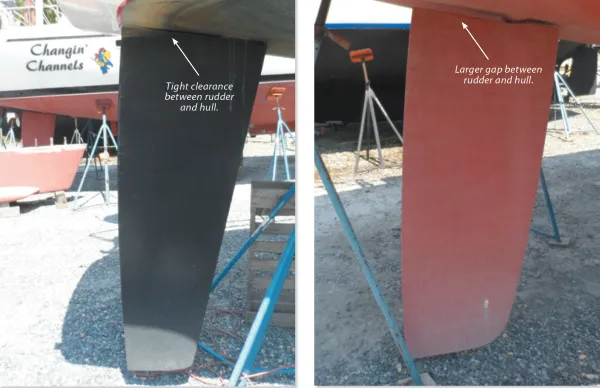
We’re cruisers not racers. We like sailing efficiently, but we’re more concerned with safety and good handling than squeezing out the last fraction of a knot. Heck, we’ve got a dinghy on davits, placemats under our dishes, and a print library on the shelf. So why worry about perfection below the waterline?
The reason is handling. A boat with poorly trimmed sails and a crudely finished rudder will miss tacks and roll like a drunkard downwind when the waves are up. On the other hand, a rudder that is properly tuned will agilely swing the boat through tacks even in rough weather, and provide secure steering that helps prevents broaching when things get rolly. The difference in maximum available turning force between a smooth, properly fitted rudder and the same rudder with a rough finish and poor fit can be as much as 50% in some circumstances, and those are circumstances when you need it the most. It’s not about speed, it’s about control.
It Must Be Smooth
Smooth is fast. That’s obvious. But it makes an even bigger difference with steering. Like sails, only half of rudder force comes from water deflected by the front side of the blade. The rest results from water being pulled around the backside as attached flow. How well that flow stays attached is related to the shape of the blade, which we can’t easily change, and to the surface finish of the blade, which we can.
Remember the school experiment, where you place a spoon in a stream of water and watched how the water would cling to the backside of the spoon? Now, try the experiment again as a grown-up, but with a different set of materials.
Try this with a piece of wood that is smooth and one that is very rough; the water will cling to the smooth surface at a greater angle than the rough surface. Try piece of smooth fiberglass or gelcoat; the water will cling even better because the surface is smoother. Try a silicone rubber spatula from the kitchen. Strangely, even though the surface is quite smooth, the water doesn’t cling well at all. We’ll come back to that.
Investigators have explored this in a practical way, dragging rudders through the water in long test tanks (US Navy) and behind powerboats.

If we are trying to climb to windward, it’s nice to get as much lift out of the rudder as practical, before drag becomes too great or before it begins to stall with normal steering adjustments. If the boat has an efficient keel and the leeway angle is only a few degrees, the rudder can beneficially operate at a 4-6 degree angle. The total angle of attack for the rudder will be less than 10 degrees, drag will be low, and pointing will benefit from the added lift. If the boat is a higher leeway design—shoal draft keels and cruising catamarans come to mind—then the rudder angle must stay relatively low to avoid the total angle (leeway + rudder angle) of the rudder from exceeding 10 degrees. That said, boats with truly inefficient keels but large rudders (catamarans have two—they both count if it is not a hull-flying design) can sometimes benefit from total angles slightly greater than 10 degrees—they need lift anywhere they can get it.
How can you monitor the rudder angle? If the boat is tiller steered, the tiller will be about 0.6 inches off center for every degree or rudder angle, for every 3 feet of tiller length. In other words, the 36-inch tiller should not be more than about 2 inches off the center line. If the boat is wheel steered, next time the boat is out of the water, measure the rudder angle with the wheel hard over. Count the number of turns of the wheel it takes to move the rudder from centered to rudder hard over, and measure the wheel diameter. Mark the top of the rim of the wheel when the boat is traveling straight, preferably coasting without current and no sails or engine to create leeway.
The rim of the wheel will move (diameter x 3.146 x number of turns)/(degrees rudder angle at hard over) for each degree of rudder angle. Keep this in the range of 2-6 degrees when hard on the wind, as appropriate to your boat. It will typically be on the order of 4-10 inches at the steering wheel rim. A ring of tape at 6 degrees can help.
How do we minimize rudder angle while maintaining a straight course? Trimming the jib in little tighter or letting the mainsheet or traveler out a little will reduce pressure on the rudder and reduce the angle. Some boats actually sail to weather faster and higher, and with better rudder angles, by lowering the traveler a few inches below the center line.
On the other hand, tightening the mainsheet and bringing the traveler up, even slightly above the center line on some boats, will increase the pressure and lift.
Much depends on the course, the sails set, the rig, the position of the keel, the wind, and the sea state. Ultimately, some combination of small adjustments should bring the rudder angle into the appropriate range. Too much rudder angle and you are just fighting yourself.
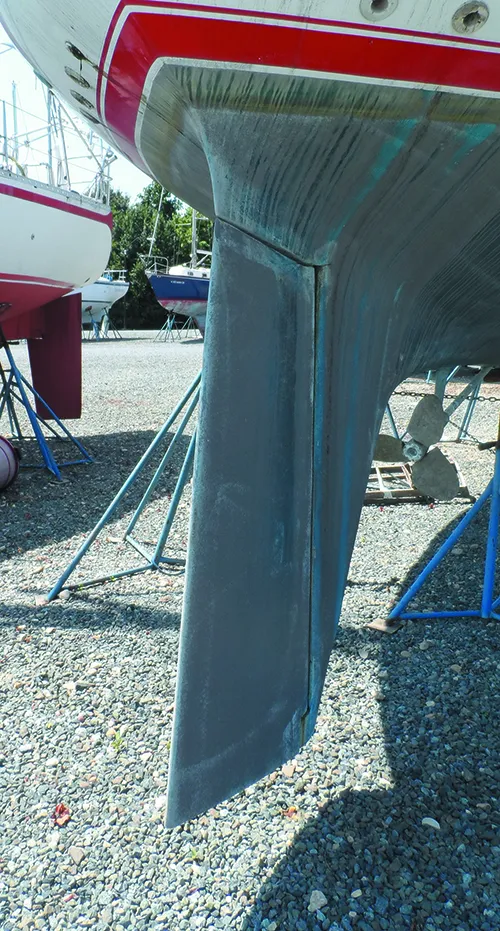
- Turn this rudder just 10 degrees and the end plate is lost, reducing the amount of lift generated.

- This rudder might as well be transom hung, the way that the end cap just disappears.
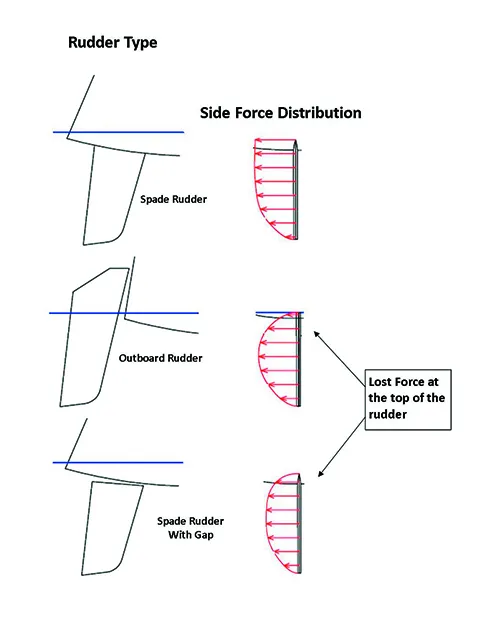
- Stern-hung rudders, and spade rudders with large gaps between the hull and the top of the rudder will lose their lift at the “tip” of the blade near the surface.
Surface roughness affects the lift from the rudder in two ways. A rougher surface has slightly lower lift through the entire range of angles, the result of a turbulent boundary layer instead of smooth flow over the entire surface. More dramatically, rougher blades stall at lower angles and stall more completely. The difference between a faired rudder with a polished finish and a rudder carrying a 10-year accumulation of rolled-on antifouling paint can be as much is 35 percent (see “Rudder Savvy to Boost Boat Performance,” above).
What can we do? If your rudder is a lift up type, don’t use bottom paint. Fair the blade within an inch of its life and lay on a gloss topside paint as smoothly as possible, sanding between coats. If you use a brush, stroke the brush parallel to the waterline, not along the length of the blade.
Which is faster, a gloss finish or one that has been dulled with 1000 grit sandpaper? Opinions go both ways, and we believe it may depend on the exact nature of the paint, which leads to the question, “Should we wax the blade?” The answer is a resounding, no.
Wax is a hydrophobic (readily beads water), like the silicone rubber spatula you tested, and as a result, water doesn’t always cling as well. Thus, whether the paint should be deglossed or not depends on the chemistry of the paint, but in all cases the final sanding should be 1000 grit or finer.
If the rudder stays in the water, antifouling paint is required. Sand the prior coat perfectly smooth. There should be no evidence of chips, runners, or any irregularity at all. Using a mohair roller, lay the paint on thin, and apply multiple coats to withstand the scrubbing you will give your rudder from time to time.
Even if you use soft paint on the rest of the boat, consider hard paint for the rudder. Sure, it will build up and you will have to sand it off periodically, but the rudder is small and no part of your boat is more critical to good handling. Take the time to maintain it as a perfect airfoil.
Close the Gap
Ever notice the little winglets on the tips of certain airplanes? As we know, those are intended to reduce losses off the tip of the wing. The alternatives are slightly longer wings or slightly lower efficiency. At the fuselage end of the wing, of course, there is no such loss because the fuselage serves as an end plate. The same is true with your rudder.
There’s not much you can do about losses from the tip; making the rudder longer will increase the chance of grounding and increase stress on the rudder, rudder shaft, and bearings. Designers have experimented with winglets, but they the catch weeds and the up-and-down motion of the transom makes them inefficient. However, we can improve the end plate effect of the hull by minimizing the gap between the hull and the rudder.
In principle it should be a close fit, but in practice the gap is most often wide enough to catch a rope. Just how much efficiency is lost by gap of a few inches? The answer is quite a lot. A gap of just an inch can reduce lift by as much as 10-20 percent, depending on the size and shape of the rudder and the speed. A gap of 1-2 mm is quite efficient, but normal flexing of the rudder shaft may lead to rubbing.
If the gap is tight, the slightest bend from impact with a submerged log can cause jamming and loss of steering, though in my experience once the impact is sufficient to bend the shaft, a small difference in clearance is unlikely to make much difference; the shaft will bend until the rudder strikes the hull. Just how tight is practical depends on the type of construction, fitting accuracy, and how conservative the designer was in their engineering.
Carbon shafts, tubular shafts, and rudders with skegs flex less, while solid shafts generally flex more, all things being equal. Normally a clearance of about 1/4-inch per foot of rudder cord is practical, and performance-oriented boats often aim for much less. If you can reach your fingers through, that’s way too much. Hopefully the hull is relatively flat above the rudder so that the gap does not increase too much with rudder angle.
Practical Sailor’s technical editor Drew Frye is the author of the books Keeping a Cruising Book for Peanuts and Rigging Modern Anchors. He blogs at his website, sail delmarva.blogspot.com .
RELATED ARTICLES MORE FROM AUTHOR
22 comments.
How happy to see good technical information about the science of boat speed and control. This information is valuable to everyone, but the “mainly just cruising” cohort usually doesn’t get enough in an easily understandable form. I always suggest some club level racing as the best way to learning how to sail, but many prospective racers have been put off from the sport or haven’t had good opportunities to join the fleets. Technical seminars are generally either too advanced for beginners to understand properly, and the beginner classes are frequently too basic to inspre those who would benefit from a deeper knowledge base in the science of sailing. Good on you, Practical Sailor, for your technical stories hitting the “sweet spot,” getting this information to those we’ll benefit most.
Great article. How about considering modifying a rudder to make it a hydrodynamically balanced rudder. I did it to my boat and the difference is outstanding. If I remember correctly 7% of the rudder area is forward of pivot center. It is a skeg hung rudder that now turns like it’s a spade rudder.
I’m “skeg hung” also. Would you be so kind as to posting a link or providing info as to you accomplished this feat. Thanks!
A very clear explanation of some quite complicated hydrodynamics – thank you! I am surprised by the US Navy results showing benefit of sanding further than 400 grit. Most other experimental data suggest there is negligible advantage in going beyond about 360 grit. Is the original reference publicly available? On Michael Cotton’s comment, a couple of points: Firstly, the amount of balance (i.e how far back you put the stock in the blade) has no impact on the hydrodynamic performance of a spade rudder. What it does do is change the feel of the rudder; a well balanced rudder will be easier to use, thereby probably allowing the steerer to sail the boat better. For a skeg rudder, the hydrodynamic impact of changing the balance depends very much on how the skeg/blade combination is configured. Secondly, 7% of rudder area forward of the stock is not enough for most rudders. The position of the centre of pressure is dependent on a lot of factors (aspect ratio, rudder angle etc.), but it is usually at least 15% back from the leading edge on a spade rudder, more often 20%. A balance somewhere between 10% and 15% is likely to give just enough feel without too much weight. However, rudder balance is still a bit of a black art, it really does depend on the rudder geometry.
the statement that one doesn’t want a silicone/silane coated ( super-smooth, hydrophobic: silicone-silane is just the example I am choosing, since it is now in use as a massively-speeding hull-coating, ttbomk ), as it *induces* flow-separation…
looks to me like conflating cavitation with flow-separation.
People have no problem teflon/ptfe-coating aviation-wings, as a means of *preventing* flow-separation.
the super-slick shape of a Cirrus’s composite wing, if made super-smooth/polished & super-slippery, “air-phobic”, as it were, *improves* its performance, not detracts from it….
Flow is always 1. laminar, then 2. turbulent, then 3. flow-separation.
unless the angle-of-attack ( AoA ) is small-enough to prevent separation.
The Gentry Tufts System, for *seeing* when a separation-bubble begins, on a sail, is brilliant ( Arvel Gentry was a fluid dynamicist, & realized that once one has a *series* of tufts, from luff on back, about 1/4 up the luff, one can *see* the beginning of a flow-separation-bubble, & tune the sail to keep it *just*-beginning, because *that* is MAX lift. Wayback Machine has his site archived, btw )
The aircraft designer Jan Roskam wrote of a DC-10 crashing because pebbled-ice as thick as the grit on 40-grit sandpaper had formed on the upper wings…
obviously, engineered to require laminar, there, but having turbulent, cost all those lives.
iirc, it was Arvel Gentry, or “Principles of Yacht Design”, that stated it takes a ridge of about 0.1mm, only, to trip the flow around a mast from laminar to turbulent…
Given how barnacles & such are generally 100x or more as thick as that, when removed from a hull, I think laminar-flow is something that exists only for the 1st day or so after launching!
I now want to see experiment showing polar curves for rudders coated normally, uncoated, & ailicone-silane coated, to see if it is the coating that induces separation-bubbles, or if it is AoA exceeding functional angle, for that surface & foil,, while the boundary-layer is in specifically turbulent flow, as opposed to the ideal laminar, as aviation’s results indicate…
just an amateur student of naval-architecture & aircraft-design ( Daniel P. Raymer’s “Conceptual Aircraft Design” is *brilliant*, btw ), who happens to study this stuff autistically, as that is the only way to make my designs become absolutely-competent, is all…
I got a pearson and the rudder broke. Can I just replace with a outboard rudder mount it off set for room for outboard need info.
You could but it will not work very well. How badly it would perform is difficult to say. It might be just poor or disastrous. Things really need to be balanced on sail boats.
Polished rudders stall at low angles of attack and ask any hobie cat racer.
Pi is NOT 3.146
3.1416 maybe
Yup, 3.1416. Typo.
Before 2005 , when I fully retired and went cruising 10 months per year, I changed auto pilots, the hydraulics of which reduced the maximum rudder angle. “Someday” had always been difficult to steer in marinas, so I added 30% more rudder area to the Gulfstar 41′ by deepening and following the existing angles. (the pivot was unchanged, as all added area was aft of that.) It increased rudder effort noticeably, but not excessively, improved motor maneauvering and allowed being able to hold a close line better. Noticeably, it caused a lot more stalling of the rudder whenever it was turned very much. A recent tangle with a Guatemala fish net damaged the extension, which I had intended to be sacrificial. I cleaned up the separation somewhat, but have not replaced the extension. The boat again now requires more steering correction when heading at all upwind, but the rudder does not stall as easily.
This is not a scientific study, just my personal non-scientific observations. The added rudder area was quite low, and the fairing quality was…well! modest.
I’ve seen data suggesting ~ 400 grit is best, and I’ve seen data suggesting polished is best. They were both smart, respected guys that I would not second guess. My conclusion is that other factors, such as the specific foil profile and the type of coating, are involved. Let’s just agree that many layers of rolled bottom paint with a few lumps and chips is sub-optimal! We’re talking about cruising boats.
Thanks for great article. I’m convinced enough to go sand my bottom paint off the lifting rudder of my Dragonfly Tri.
Absolutely! No lifting rudder should have bottom paint. My Farrier rudder was sanded fair and painted with gloss white.
Dagger boards and center boards that retract still need antifouling, since they do not lift clear of the water, but because they are in a confined space with little oxygen or water flow, fouling is very limited. Because the space is tight and paint build-up can cause jamming, sand well and limit the number of coats. For my center board I go with two coats on the leading edge (exposed even when lifted) and one coat on the rest.
I do remember a comment directed to cruisers a few years back suggesting that a faster cruiser would be more likely to get out of the way of dirty weather, especially with modern forecasting. I reckoned that this concept would gain traction, but I haven’t seen it. Can anyone weigh in on this opinion?
I would agree ONLY for coastal crusing when a safe harbor is always no more than a day away. OR ocean racing where speed matters and the boat is kept light. We all know weather reports past 24hours are a guide not a guarantee. Once a storm is bearing down NO boat even a fast one is going it out run a storm. Also we sail on boats that need wind and it’s always a balance between a course between high pressure systems (doldrums) and low pressure systems (high likelyhood of a storm) so because we seek wind sometimes we get more then we want. Try and avoid that and you risk venturing too far into the high pressure system and NO wind. So yes weather forecasts can give you a 1-2 day weather window and a fast boat that can get the hell out of dodge and put a few miles between itself and the oncoming weather could avoid a storm. BUT we are usually not talking about a world ocean race boat vs an old full keel tank. We are talking a faster but still rather slow loaded down cruising boat. It may be only the difference of 7knot average vs 9 knots average. Even a faster cruiser/racer is not a stripped down Volvo series racer. And even those super fast ocean racers pushing the edge of technology get caught in storms and frankly I would not want to use one of those boats as my floating home on the water. They are a thrilling ride but far from comfortable. And they STILL can’t sail fast enough to out run a storm and guarantee you you will never have to sail in big waves and high winds. There is not a cruising SAIL boat that is as fast as a center console fishing boat with 1200hp in outboards on the back and guess what when a squall is coming even they get caught and can’t out run it. And no it’s not a hurricane and it won’t last long but it’s enough when it hits you if your on a light boat over canvased because trying to outrun the oncoming squall it’s enough to get scary. And then there is comfort. Even when there is no storm near you the swell from a storm hundreds of miles away can make for a uncomfortable ride in a boat designed to go fast vs a heavy displacement boat that just pushes threw waves and Has the tonnage not to get knock around. So much of this article screams weekend coastal sailing as even a week on anchor all that work to smooth your rudder will be canceled out by bottom growth todays antifoul paints don’t work as good as the older but far more toxic formulas so even the most meticulously cleaned cruising boat picks up growth ya you can dive and clean it regularly but I often it’s like Sisyphus pushing that rock up the hill. And besides if your sailing on a fullkeel with a keel hung rudder most of this is mute. yes a clean smooth bottom makes a difference on any boat but it’s the full keel and its tendency to track straight the over all weight and momentom of the boat it’s not fast and never will be but they can maintain their hull speed and track a comfortable ride threw chop and be unaffected by the swell. I’ll take a old full keel boat with a protected rudder I know is very unlikely to ever hit something to bend it or loose my rudder ever over a spade rudder or even worse duel rudders both hung exposed with a long but thin bolted on keel that if you hit a coral head means a haul out to inspect it as it more then likely cause a lot of expensive damage. And if not fixed right could lead to a future disaster (Cheeki Rafiki).
As interesting as the article reads, I wonder how it helps a prospective buyer of a used boat. Pictures will not do, and neither will taking several boats out of the water to examine them; it’s too expensive. It would be more helpful to indicate which boat manufacturers have the type of rudder the author recommends. After all, the buyer usually cannot be expected to change a rudder prior to buying it; it is also expensive. By the way, these types of very sophisticated articles are seen when it comes to hulls, keels, or rigging but without identifying the boats that carry the wrong equipment. If a specific rudder or keel configuration is not the proper one for efficient sailing, the author ought to state which boats carry the proper ones so that the buyer will concentrate on the whole (the boat) rather than the part.
I was describing the opportunity to improve the existing rudder. As I think back, I have modified the rudder of every boat I have owned in order to improve efficiency. The first two got small changes in balance and improved trailing edge sharpness. On the third I tightened the the hull clearance and changed the section. On my current boat I adding an anti-ventilation fence to improve high speed handling. https://4.bp.blogspot.com/-2ZGPzKdj_tE/WyF9G2mHtLI/AAAAAAAAOwE/r6zgQEr4vkcDB4ciMLcgboFdazDAseDBgCLcBGAs/s1600/ian%2Brudder%2Bfence.jpg None of these tasks was overly difficult, and none was undertaken until I had sailed the boat for a season and learned what balance she liked and noted her habits.
For me, I buy a boat based on reputation, a test sail, and in most cases, a survey. As you imply, it is the whole boat you are buying. Does it have good bones? Do you feel happy at the helm? Then comes the fine tuning. I’ve been told that I sell a boat when I run out of things to tweak.
wow, so now case reports/medical reports/evidence don’t count as “evidence”, but certain remedies, even if they are cited in medical journals but do not work in the real world, count as evidence to you?? Maybe we need to redefine evidence based on your philosophies.Anyway, i’ve wasted enough time here. goodbye.
Weight 2.5 tonnes
Do you have any articles on the ideal cross section shape for an outboard rudder mounted 50mm from the transom vertically The yacht is a 26 ft trailer sailer weight 2.5 tonnes
The most common choice would be NACA 0012. http://airfoiltools.com/airfoil/details?airfoil=n0012-il
There are many ways to build a rudder, including laminated solid rot-resistant wood and fiber glass covered foam with a metal armature core. For the DIY, laminated wood is probably the most practical.
LEAVE A REPLY Cancel reply
Log in to leave a comment
Latest Videos
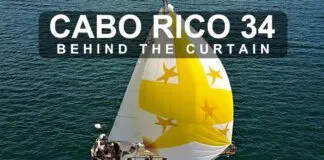
Cabo Rico 34 Boat Review

Super Shallow Draft Sailboat: The Leeboard Sharpie

Hans Christian 41T – Boat Review

Seven dead after superyacht sinks off Sicily. Was the crew at...
Latest sailboat review.
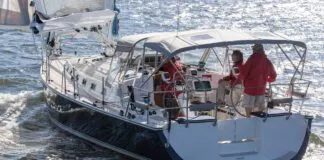
- Privacy Policy
- Do Not Sell My Personal Information
- Online Account Activation
- Privacy Manager
Jordan Yacht Brokerage
We Never Underestimate Your Dreams
Sailboat rudder types – full, spade, skeg, outboard.
The four rudder types are: full, spade, skeg, and outboard. This article discusses the advantages and disadvantages of each.
Full The full or full keel rudder lies at the aft end of a full length keel. The keel-rudder streches along the entire length of the bottom of the hull. The full rudder is safe and nearly invulnerable to damage. The leading edge of the keel protects the rudder from flotsam. The full rudder is quintessential of offshore cruisers like Wetsails and Cabo Ricos. Even grounding may not cause damage. The boat will sit comfortable on its side until the tide returns and floats the boat back up.
Spade The spade rudder lies at the aft separate from the keel. A spade rudder is easy to turn because the water rushes both against its fore and aft edges – great for using a tiller. A spade rudder is also fast as the wet area less than a full keel. The boat racing along with less resistance. Spade and partial spades are becoming the most popular rudder type. The Hylas 70 has a partial spade rudder as well as early 54’s.
Skeg A skeg rudder is more modern in performance and safety. It is the most popular and common type of rudder on production boats these days. The rudder is fast and looks like a spade keel. Except, the skeg rudder has a fake keel which extends from the hulls aft and protects the fore edge. Most Hylas yachts have skeg rudders.
Outboard Outboard rudders are seen on smaller boats. They simply hang over the stern of the boat. For example, racing prams use outboard rudders. They are easy to fasion as emergency rudders. You can make one out of a handlerail and cabin door.
Conclusion A rudder is either full, spade, skeg, or outboard. Each type has its benefits. The most important part is make sure she is in good condition and have a spare.
4 Replies to “Sailboat Rudder Types – Full, Spade, Skeg, Outboard”
Ahoy Mateys, it’s Fox Axel the Pirate. I’ve got a swashbuckling yarn to tell ye. Me was drifting along way out at sea. Me had lost me steering while pillaging a friendly ship. The knaves canon knocked me rudder off. Me had nought to to turn to. The authorities would hang me, the villainous lot. But, me was getting desperate out of grub and rum, nothing to sage me drunken pirate ways. I had lost me last vestige of sanity.
Finally, me saw in the distance a giant whaler coming. The big ship sailed straight at me. “Ahoy mateys!” me spake. The freighter came near, too near. Shiver me timbers. The goulish crew must be drunk out of thee minds. Me could not steer away. She rammed straight slicing me ship in twain. Down to Davy Jones’ locker we went. Take care with ye rudders mateys – the Pirate of Monkey Isle.
Ok ye swabs ave a told me to finish me story. Ere dis da rest. As the freighter tore away leaving me to perish in the sea. I climbed on a board of driftwood from me sinkin’ ship. I passed out adrift, alone. When I came to, I found meself shipwrecked on a deserted island. I stumbled around and ran into, who of all? Big Red, me pirate enemy! Aye, I’m shipping as mate with his goulish fleet until I can betray and kill him. Aye, hope Big Red ain’t reading dis here blog. Black Fox the Pirate.
I am ye swab. I am too sharp for some ere fool like ye. I ain’t gots no book learning, but me hast carniving ways from many years below the mast. Iffen ye be trying to betray me, I am a gonna get ye.
Thank you for sharing this article.It’s quite easy to understand the difference.
Leave a Reply
Your email address will not be published. Required fields are marked *
Save my name, email, and website in this browser for the next time I comment.
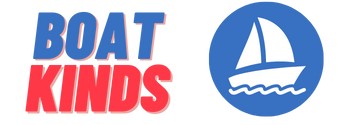
What is a Boat Rudder? – Types & Important Facts to Know
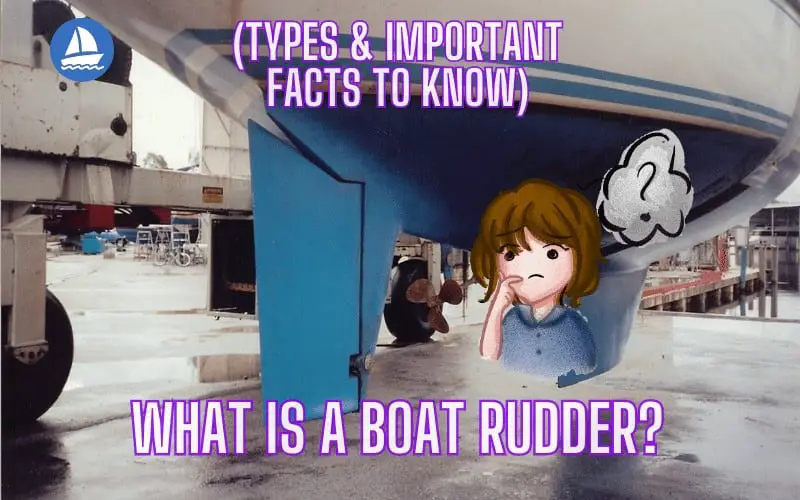
A boat rudder is a flat or curved piece of material, usually made of metal, wood, or composite materials, attached to the stern (rear) of a boat or ship to control its direction of movement.
Table of Contents
The rudder can be turned left or right using a steering mechanism, such as a tiller or a wheel, and its movement redirects the flow of water passing over the boat’s hull, causing the boat to turn in the desired direction.
The size and shape of a rudder can vary depending on the size and type of boat or ship it is installed on, as well as the intended use of the vessel.
Smaller boats may have a single, smaller rudder, while larger vessels may have multiple rudders or a more extensive, more complex rudder system.
Additionally, some boats, such as sailboats, may have a retractable or removable rudder to minimize drag when sailing.
Boat Rudder – Definition and History
The history of the boat rudder dates back to ancient times when boats were first developed for transportation and trade.
The earliest rudders were simple oars or paddles that were used to steer the boat by dragging them through the water. Later, larger boats and ships required a more efficient method of steering, and the rudder was developed.
The first known depiction of a rudder comes from a Han dynasty tomb model in China, dated to the 1st century AD.
This early rudder was made of wood and was attached to the hull by a yoke, which allowed the rudder to pivot from side to side.
Over time, the design of the rudder evolved, with improvements in materials and technology leading to more efficient and effective steering systems.
In the Middle Ages, European ships began using a sternpost rudder, which was mounted on the sternpost and allowed for more precise steering control.
By the 19th century, iron and steel were being used to make rudders, which were stronger and more durable than their wooden predecessors.
Today, boats and ships of all sizes use a variety of rudder designs and materials, ranging from small fiberglass rudders on recreational sailboats to massive steel rudders on ocean-going cargo ships.
The basic principles of the rudder remain the same, however, providing boats and ships with the ability to navigate and maneuver through the water.
How Rudders Work Types Of Rudders And Their Advantages
Rudders work by redirecting the flow of water passing over a boat’s hull, creating a force that turns the boat in the desired direction.
When the rudder is turned, it creates a pressure differential on either side of the rudder, which causes the water to flow around the rudder and deflects the water in the opposite direction, thus changing the direction of the boat.
There are several types of rudders used on boats and ships, each with its advantages and disadvantages:
1-Balanced Rudder
A balanced rudder is a type of rudder used on boats and ships that are designed to reduce the force required to turn the rudder and improve steering efficiency.
A balanced rudder has a smaller surface area, which reduces the amount of water resistance and drag created by the rudder, making it easier to turn.
The balance of the rudder is achieved by using a counterweight or a smaller rudder at the front of the main rudder. The counterweight or front rudder offsets the force created by the pressure differential on the main rudder, making it easier to turn.
Balanced rudders are commonly used on sailing vessels, where precise steering control is important. They can also be found on powerboats and larger ships, where they provide improved maneuverability and reduced drag.
One of the main advantages of a balanced rudder is that it requires less force to turn than a conventional rudder, which reduces the amount of energy required to steer the vessel. This can result in improved fuel efficiency and reduced operating costs.
Additionally, the smaller size of the rudder can make it less effective in high winds or rough seas.
2-Unbalanced Rudder
An unbalanced rudder is a type of rudder used on boats and ships that do not have a counterweight or a smaller rudder to offset the force created by the pressure differential on the rudder.
Unbalanced rudders are simpler in design and less expensive to manufacture than balanced rudders, but require more force to turn and are less efficient.
Unbalanced rudders have a larger surface area than balanced rudders, which creates more water resistance and drag when turning. This can make the boat more difficult to steer and can reduce the overall speed and efficiency of the vessel.
Unbalanced rudders are commonly used on smaller boats and recreational vessels, where the reduced manufacturing costs and simplicity of design are important factors.
However, larger vessels such as commercial ships and military vessels typically use balanced rudders or other more advanced steering systems to provide greater maneuverability and control.
Overall, unbalanced rudders have the advantage of being less complex and less expensive than other types of rudders, but their larger size and greater resistance can make them less efficient and more difficult to control.
Proper maintenance and care of the rudder are important to ensure it operates effectively and safely.
3-Semi-Balanced Rudder
A semi-balanced rudder is a type of rudder used on boats and ships that combines features of both balanced and unbalanced rudders.
Semi-balanced rudders have a smaller surface area than unbalanced rudders, which reduces the amount of water resistance and drag created by the rudder, making it easier to turn.
However, unlike unbalanced rudders, semi-balanced rudders have a small counterweight or a smaller rudder at the front to partially offset the force created by the pressure differential on the main rudder.
Semi-balanced rudders are commonly used on smaller to medium-sized boats and ships, where maneuverability and ease of use are important factors, but the cost is also a concern.
The smaller size of the rudder allows for improved efficiency and reduced drag, while the partial balance provided by the counterweight or smaller rudder at the front makes it easier to turn than an unbalanced rudder.
Semi-balanced rudders can provide a good balance between efficiency and ease of use, but they may not be as effective in extreme conditions as fully-balanced rudders. They also require proper maintenance and care to ensure that they operate effectively and safely.
4-Skeg-Mounted Rudder
A skeg-mounted rudder is a type of rudder used on boats and ships that are attached to a vertical structure, called a skeg, which extends from the bottom of the boat’s hull. The skeg provides support and stability for the rudder and helps to protect it from damage.
Skeg-mounted rudders are commonly used on larger boats and ships, such as commercial vessels and yachts. They are typically mounted near the stern of the boat, and the skeg extends downward from the hull to provide additional support for the rudder.
This design allows for greater maneuverability and control, particularly in rough or choppy waters.
One of the main advantages of a skeg-mounted rudder is its ability to provide a stable and secure attachment for the rudder, which can reduce the risk of damage or failure. Additionally, the skeg can help to protect the propeller and other underwater components from damage.
However, the additional structure required for a skeg-mounted rudder can increase the weight and complexity of the boat, which can affect performance and efficiency.
Skeg-mounted rudders can also be more difficult to repair or replace than other types of rudders, particularly if damage occurs to the skeg itself.
5-Transom or Outboard Rudder
A transom or outboard rudder is a type of rudder used on boats where the rudder is mounted on the transom or the exterior of the hull, rather than being attached to a skeg or other support structure.
Transom or outboard rudders are commonly used on small boats, such as sailboats and motorboats, and are particularly common on boats with outboard motors.
The main advantage of a transom or outboard rudder is that it is relatively simple and inexpensive to install and maintain. This type of rudder can also provide good maneuverability and responsiveness, particularly at lower speeds.
However, transom or outboard rudders can be less effective at higher speeds, as they can create more drag and turbulence.
They may also be more susceptible to damage from impact with objects in the water and may require more frequent maintenance and replacement than other types of rudders.
6-Flaps Rudder
Boats also have flaps and rudders, but they work slightly differently from those on aircraft.
Boat flaps, also known as trim tabs, are small hinged surfaces attached to the stern of a boat that can be adjusted up or down to change the angle of the boat’s hull in the water.
By changing the angle of the hull, the boat can be made to ride higher or lower in the water, which can improve stability, reduce drag, and improve fuel efficiency. Boat flaps are typically used to adjust the boat’s trim while underway, especially in rough water or when carrying a heavy load.
The rudder on a boat is a hinged surface attached to the stern that can be turned left or right to steer the boat.
Unlike aircraft rudders, boat rudders are not used to control yaw or side-to-side movement, but rather to turn the boat left or right. The size and shape of the rudder affect the boat’s turning ability, and some boats have more than one rudder to improve maneuverability.
In summary, boat flaps and rudders are used to adjust the boat’s trim and steer the boat, respectively, and work differently from their counterparts on aircraft.
7-Spade Rudder
A spade rudder is a type of boat rudder that is designed with a single blade that is attached to the hull of the boat. The term “spade” refers to the shape of the rudder, which is narrow and tapered like a spade or shovel.
Compared to other types of rudders, such as skeg-mounted or transom-mounted rudders, a spade rudder offers several advantages.
Because it is mounted on the hull rather than the keel or transom, a spade rudder can be positioned farther aft and closer to the propeller, which can improve the boat’s maneuverability and reduce the turning radius.
Additionally, a spade rudder is typically lighter and more responsive than other types of rudders, which can make it easier to control the boat in a variety of conditions.
However, there are also some potential drawbacks to spade rudders. Because they are mounted directly to the hull, they can be vulnerable to damage from impacts or groundings.
Additionally, they may require more maintenance than other types of rudders due to their complex design and construction.
8-Twin Rudders
Boats with twin rudders have two separate rudders mounted on the stern of the boat, usually one on each side of the keel. This arrangement offers several advantages over a single rudder configuration.
One of the primary benefits of twin rudders is improved maneuverability. Because each rudder can be angled independently, the boat can be steered more precisely and with greater responsiveness, making it easier to navigate in tight spaces or rough water.
Additionally, twin rudders can provide greater stability and control when the boat is heeled over or sailing at high speeds.
Another advantage of twin rudders is redundancy. If one rudder becomes damaged or fails, the boat can still be steered using the other rudder, which can be a critical safety feature in emergencies.
However, there are also some potential drawbacks to twin rudder configurations. They can be more complex and expensive to design and install than a single rudder and may require additional maintenance to keep both rudders operating smoothly.
Additionally, twin rudders can create more drag than a single rudder, which can reduce the boat’s speed and fuel efficiency.
However, they may not be necessary or practical for all types of boats and applications.
How Does a Rudder Work?
A rudder is a hinged surface located at the stern (rear) of a boat that is used to control the direction of the boat. When the rudder is turned to one side, the force of the water flowing past it creates a turning moment that causes the boat to turn in the opposite direction.
The principle behind how a rudder works are based on the Bernoulli principle, which states that as the speed of a fluid (such as water) increases, its pressure decreases.
When the boat is moving forward, water flows past the rudder at a higher speed on one side than the other.
This creates a pressure differential, with higher pressure on the side where the water is flowing more slowly and lower pressure on the side where the water is flowing more quickly. The resulting force on the rudder creates a turning moment that causes the boat to turn.
To turn the boat to the left, the rudder is turned to the right, creating a higher pressure on the right side of the rudder and a lower pressure on the left side, which turns the boat to the left.
Conversely, turning the rudder to the left creates a higher pressure on the left side of the rudder and a lower pressure on the right side, which turns the boat to the right.
The size and shape of the rudder, as well as the speed and direction of the water flow, all affect the turning ability and responsiveness of the boat.
Additionally, other factors such as wind, currents, and the boat’s weight and balance can also influence how a rudder works and how effectively it can steer the boat.
The advantages of rudders include improved steering and maneuverability, greater control over the direction and speed of the boat, and increased safety and stability.
However, rudders can also create drag and resistance, which can reduce the boat’s speed and efficiency, particularly in light winds or calm waters. Proper maintenance and care of the rudder are important to ensure it operates effectively and safely.
Hi, My name is Steve. Boating is my hobby :). Bought and sold many bots during the last 15 years. You can find the most current and old boat sales here. I am working hard to find the best gift ideas, to analyze the latest gadgets and accessories, and to provide reviews and recommendations to improve your boating experience. I hope you enjoy my site.
Leave a Reply Cancel reply
Your email address will not be published. Required fields are marked *
Recent Posts
Novi Boats for Sale at Just US$1,410,000 *2023 New Fishing Boat
Novi Boats for Sale is world-renowned and one of the most recognized boats in the UK. Novi Lobster Boats for Sale These have a long and impressive history stretching back over thirty years. They...
WesCraft Boats for Sale at Just US$39.900 **2023 WesCraft Boats Craigslist & Reviews
WesCraft Boats for Sale price of this branded boat is only 39,900 dollars. If you are in the market for a new watercraft and have decided to go with a traditional style of boat, you may want to...

Boating Basics Online is reader-supported. When you buy via our links, we may earn a commission at no cost to you. Learn more
What is a Boat Rudder? – Types & Important Facts to Know
Written by J. Harvey / Fact checked by S. Numbers
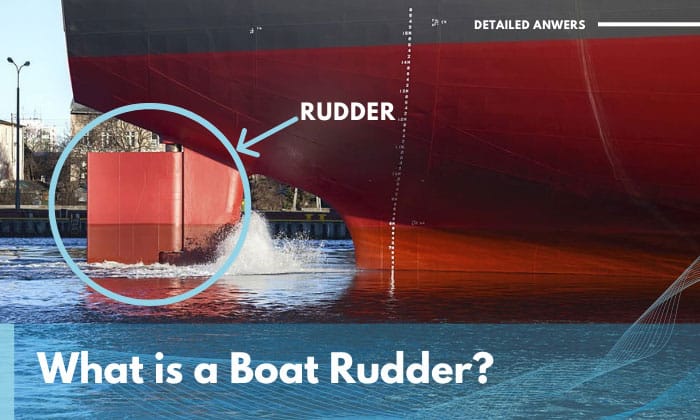
Learning to operate a boat requires a lot of knowledge and practice, and it also helps to know what part of the boat is responsible for certain functions. For this article, let’s take a look at the rudder.
But what is a boat rudder, and what does a rudder do on a boat?
The rudder is found at the vessel’s stern and is part of the boat or ship’s steering mechanism. Keep reading to learn more.
Table of Contents
Boat Rudder – Definition and History
1. balanced, 2. unbalanced, 4. semi-balanced, 5. skeg-mounted, 6. transom or outboard, how does a rudder work, frequently asked questions.
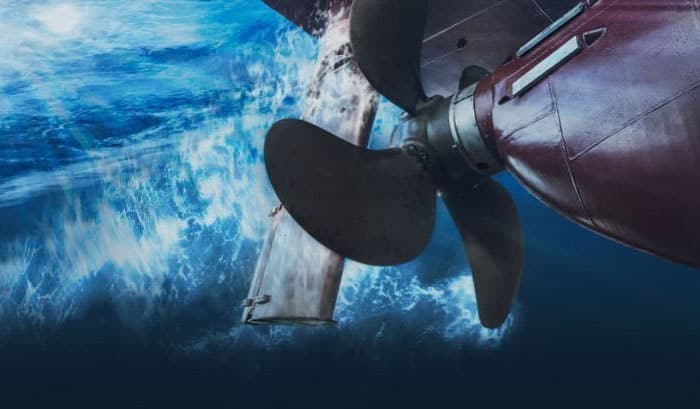
The standard axial rudder definition refers to the steering apparatus on a vertical (or, in some cases, nearly vertical) axis. This boat part can be managed using a tiller, steering wheels , or buttons on a control console.
Boats are not the only vehicles to utilize rudder steering. Airplanes, for example, also depend on this apparatus to rotate on a vertical axis. Similar to boats, the rudder in aircraft is located at the rear – the stabilizer’s outer edge, to be specific.
The exact original date of invention of rudders is unknown. However, there is enough historical evidence to get a rough estimate of when rudders were invented, which points to the Ancient Egyptians during the BC era with their steering oars.
That said, many would argue that the Egyptian steering oar is not a true rudder. In this case, the design that most resembles the modern rudder on a sailboat is believed to have originated in China during the Warring States Period (475 to 221 BC).
However, the modern rudder used on the motor boat was conceptualized in 1843 with the advent of the balanced ships rudder.
Aside from the balanced rudder, many different kinds of rudder work on a ship or boat. Here, we will cover a few of the more common types and what sets them apart.
Types of Rudder and Their Purpose/Function
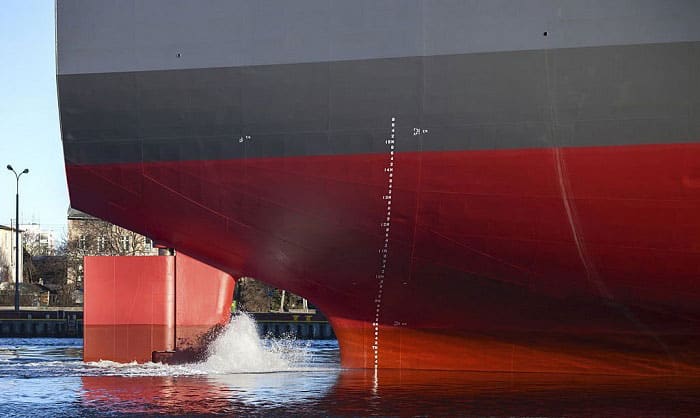
This type is attached to the boat and supported by a pintle on the bottom and stock on the top, effectively holding the rudder in place. It is characterized by being partially positioned in front of the connecting post, which balances the rudder.
Balanced rudders produce less resistance and allow for smooth and efficient sailing. You can find this rudder on a ship used for commercial purposes or a vessel with medium size.
An unbalanced sailing boat rudder is designed with a rudder stock that runs from the top to the bottom of its span’s forward-most point. The longer stock allows the rudder to make sharper turns without becoming undone.
Unbalanced rudders are often used on smaller watercraft. However, they’re not very popular today as they don’t perform as well as their semi-balanced counterpart.
The most common type you can find nowadays, especially on twin-screw ships, these rudders are only balanced in their lower half. As a result, they have positive features from both balanced and unbalanced versions – providing stability while ensuring ease of operation.
The rudder is connected to and supported by a skeg, which gives it additional protection from possible damage due to debris. However, the basic skeg-mounted design makes it more difficult to turn a vessel; but this can be addressed with a semi-balanced design.
The semi-balanced skeg, or horn rudder, only uses a half-length skeg to support the rudder. The lower half of the rudder is not connected to anything, just like a spade rudder.
Skeg-mounted rudders are most often used on yachts with fin keels. Both full- and semi-balanced skegs can ensure the yacht can withstand heavy impacts, making the vessel sturdier and more resilient.
The rudder is connected to the stern above the water, meaning it’ll only be partially submerged and can be removed while the boat is still afloat. Rudders utilizing this design are usually controlled with a tiller.
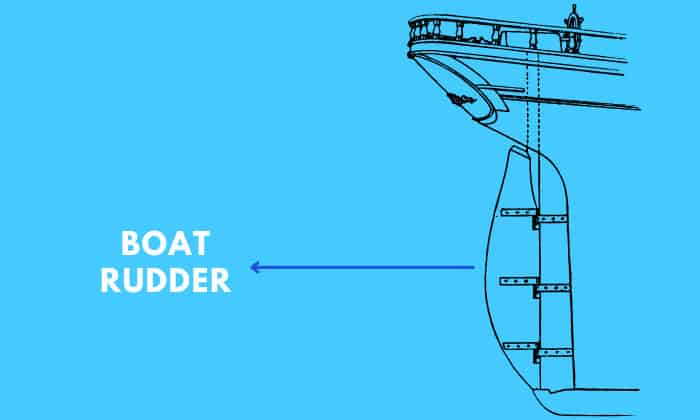
Rudders function by controlling the flow of water using its contact surface. When the rudder is straight, it maintains the flow of water and helps to keep a vessel on its course. The vessel is able to remain steady even with the different forces acting on it, such as the movement of surface water and wind.
When the rudder is turned to one side, it manipulates the water pressure. The resulting difference between the two sides creates a force shift that allows the boat to turn in the same direction where the rudder is angled.
When a rudder is turned to an angle, a certain amount of counterforce pushes back on the rudder resulting in resistance. This makes it difficult to turn a boat as often depicted in various entertainment media, and this resistance is more evident when using a tiller instead of a wheel.
The boat’s ability to make sharper turns is affected by the rudder’s design, as explained above. However, having a wider range for turning also comes with problems, such as being more prone to mechanical problems.
The size of the rudder directly impacts its performance. If it is too small, there would not be enough force to influence the boat’s course, whereas a too-large rudder will result in a lee helm. Even its placement affects performance, as positioning anywhere else but the stern may render it useless.
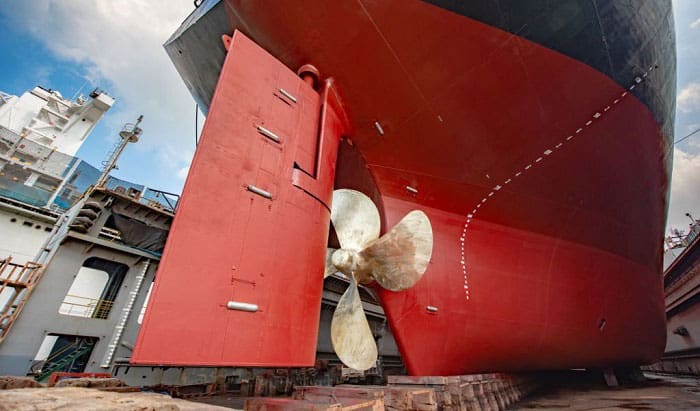
Is a rudder the same as a propeller?
No, they are two different components found on a boat, and each has its function.
As mentioned above, the rudder is responsible for steering and maintaining the vessel in a specific direction. The propeller is responsible for moving the boat forward by rotating its blades and creating a pushing force.
It is by making use of both the rudder and propeller that we can properly move and control the boat when traversing the water. Having just one of them for operating a vessel would be difficult.
What does a rudder on a boat look like?
The rudder on each boat may look a bit different, and the type of hull on the vessel also influences this appearance. In general, rudders look like flat plates or sheets, and they often resemble a fin or blade.
Do small boats have rudders?
Some very small boats like kayaks can have a rudder, but these may not be enough in some situations or may be more likely to experience a malfunction.
Kayakers make up for this with special techniques for steering the boat, such as the stern rudder, where the paddle is held in a certain way to mimic how a rudder works.
What is a boat rudder? Now you know the answer, but be sure to keep learning about the other important parts and mechanisms found on a watercraft. Knowing the tools you work with is always a good way to improve, which also applies to boating.
Did you find this useful or interesting? What other boat part do you think warrants this level of attention? Tell us your thoughts and suggestions in the comments section below.
Remember to boat safely.

“My intention from the first day establishing Boating Basics Online is to provide as much help as possible for boaters who want to experience a first safe and convenient trip. So feel free to join us and share your beautiful journeys to the sea!”

Professional BoatBuilder Magazine
The rudimentaries of rudders.
By Steve D'Antonio , Jul 12, 2018

Even stoutly constructed rudders are vulnerable to deterioration over time, especially when mild steel or high-carbon-stainless steel is buried in composite foil sections, which inevitably become saturated with seawater.
Like other systems and gear aboard cruising and commercial vessels, rudders have terms to identify their parts and functions. When measuring a rudder, the span and chord are the vertical height and fore-and-aft width, respectively, while the top of portion closest to the hull is referred to as the root , and the bottom is called the tip . Another term frequently used when discussing rudder design, particularly for sailing vessels, is aspect ratio —simply the square of the rudder’s span divided by the rudder’s area. As a rule of thumb, longer, narrower rudders are more efficient than short, wide rudders, and the aspect ratio describes precisely this relationship. Thus, rudders on high-performance sailing vessels are said to have a high-aspect ratio. Walking around a boatyard one day and measuring a few cruising sailboat rudders, I came up with aspect ratios of between 1.7 and 2.1, while one high-performance sailing vessel’s rudder came in at 3.5. The 20-knot semi-displacement lobster yacht’s rudder I measured yielded an even 2.0 aspect ratio, which is considered respectable for this application.
More identifiable rudder components include the stock ; web or armature ; rudderport or log ; stuffing box or compression tube ; bearing ; gudgeon ; and pintle . Not every rudder has all these components.
Rudderstocks
The rudderstock is essentially a shaft or tube that protrudes from the top and sometimes the bottom, depending upon type, of many rudder designs. Because this component provides the primary connection between the rudder’s blade (the flat section that imparts the steering force) and the vessel’s steering system, its design, construction, and material are consequential.
Most stocks are made of stainless steel, bronze, or aluminum, while some are carbon fiber, and they may be solid or hollow. Stainless steel is by far the most common, but it has a penchant for crevice corrosion when exposed to oxygen-depleted water. Insidiously, corrosion nearly always occurs in places where it cannot easily be seen—such as inside many composite (fiberglass and core material) rudder blades and beneath flax-type stuffing-box packing (the problem is exacerbated when the vessel is used infrequently).
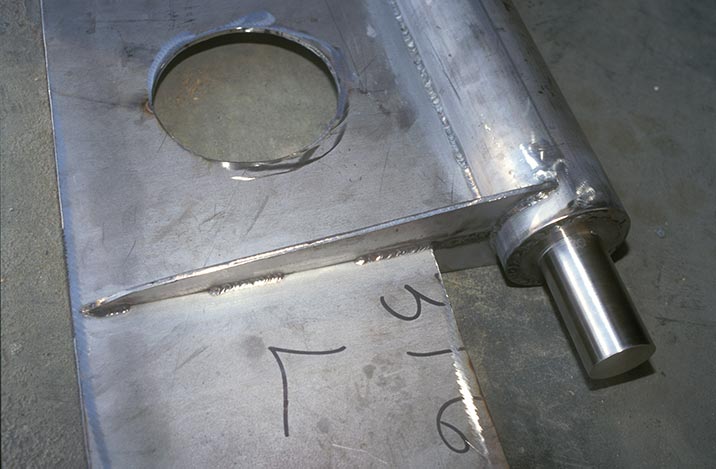
This all-stainless rudderstock and webbing is well crafted and ready to be covered with its composite shell.
Of the stainless steel alloys, some resist this corrosion better than others. Stainless-steel rudderstocks should be manufactured with strong, highly corrosion-resistant proprietary shafting alloys such as A22. The next best choice is 316L stainless steel, which also resists crevice corrosion well. Critically important is the L suffix, meaning “low carbon,” a requirement if it is to be welded, as nearly every rudderstock must be, to the support within composite rudders, or to all-metallic plate-steel rudders. Failure to source low-carbon stainless steel for the stock or the web leads to weld decay, sometimes referred to as carbide precipitation, where the region around the weld loses its resistance to corrosion and rusts when exposed to water.
Aluminum rudderstocks are nearly always tubular. Common on aluminum vessels to reduce the likelihood of galvanic corrosion, aluminum stocks are also relatively common on fiber reinforced plastic (FRP) vessels, particularly large ones. Rudder blades, particularly on aluminum vessels, are often fabricated from aluminum. Of the various aluminum alloys, only a few possess the necessary corrosion-resistance and strength necessary for use as rudderstocks. Of these, the 6000 series, and 6082 in particular—an alloy of aluminum, manganese, and silicon—are popular for this application.
Because aluminum, like stainless steel, suffers from corrosion, it should not be used as stock or web material in composite rudders. Referred to as poultice corrosion, it occurs when aluminum is exposed to oxygen-depleted water. Because oxygen is what allows aluminum to form its tough, corrosion-resistant oxide coating, the metal should never be allowed to remain wet and starved of air as it would be inside a composite rudder blade after water makes its way in around the stock and pintle.
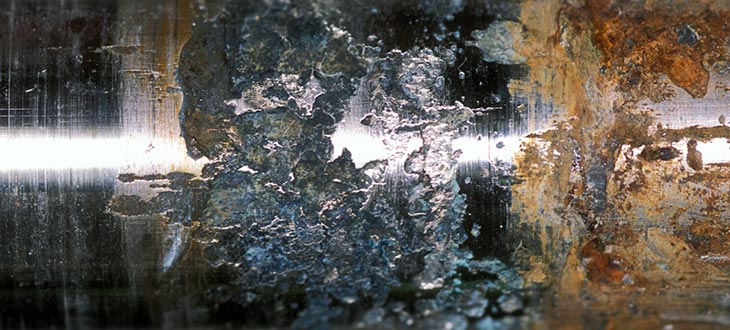
Rudderstock material can corrode in way of the oxygen-starved environment around the packing in a stuffing box.
Bronze, a once popular rudderstock material, is no longer common in today’s production vessels. Although strong and exceptionally corrosion resistant (immune to crevice corrosion), bronze is not easily welded to attach to a rudder’s internal structural webbing, and has thus been supplanted by stainless alloys. Bronze rudderstocks, particularly those that have seen many sea miles, are also known for wearing, or hourglassing, within stuffing boxes, where the flax rides against the stock. If a bronze stock rudder is chronically leaky, disassemble the stuffing box and check for excessive wear. The same is true for stainless and aluminum stocks: chronic leakage is often an indication of corrosion at the packing. Finally, because of their galvanic incompatibility, neither bronze nor copper alloys should be used aboard aluminum vessels for rudderstocks or any other rudder or stuffing box components.
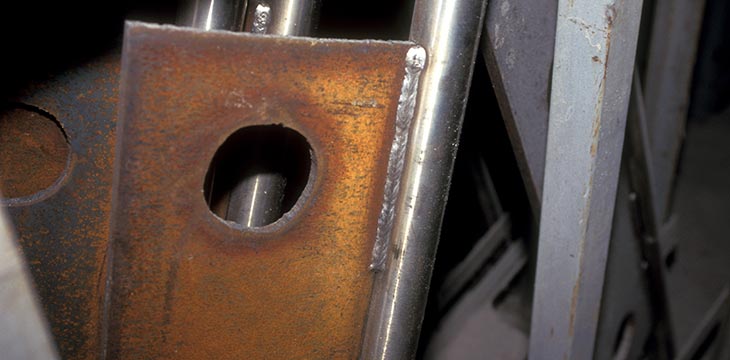
Mild-steel webbing welded to a stainless-steel rudderstock is a recipe for eventual corrosion and failure.
The webbing, or internal metallic support system, in most composite rudders must be strong enough to carry the loads of service and be made of the appropriate material. At one time, many rudders were built using stainless-steel stocks and ordinary, rust-prone mild or carbon-steel webbing. Inadvisably, some still are. The union between a stainless stock and FRP rudder blade is tenuous at best (the two materials expand and contract at different rates) and stainless steel’s slippery surface makes adhesion to the laminate resin a short-lived affair. Once water enters the gap between these two materials, it will reach the webbing and associated welds. Thus, all the materials within this structure must be as corrosion- and water-resistant as possible, and the core material must be closed-cell—often foam—and nonhygroscopic.
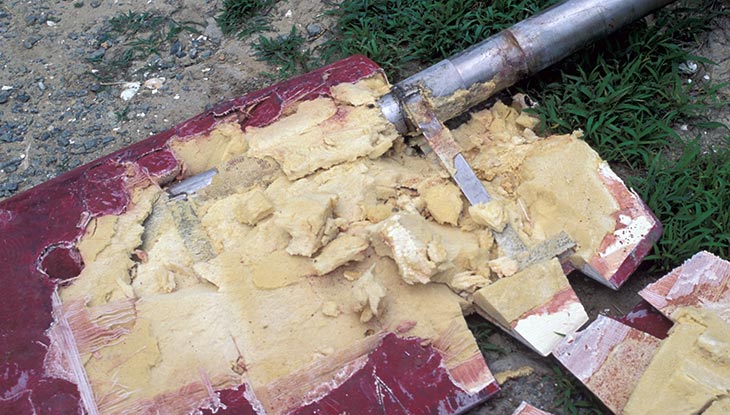
This destroyed foam-core and stainless-steel rudder reveals the conventional construction of such appendages.
Additionally, where possible, the stock should consist of a single section of solid or tubular material; i.e., it should not be sleeved, reduced, or otherwise modified or welded unless done so in an exceptionally robust manner. The webbing must be welded to the stock, but the structure of the stock should not rely on a weld that would experience cyclical, torsional loading.
The webbing in the form of a plate or grid should be welded to the stock with ample horizontal gussets (small wedges welded where the stock and webbing interface), which will reinforce welds 90° to the primary web attachment.
Whether the rudder is spade (supported only at the top) or skeg hung (supported at the top and the bottom), the stock must pass through and be supported by the hull. This is usually accomplished by a component known as a rudder log, or port. In its simplest form it’s a tube or pipe through which the stock passes. Nearly all logs incorporate two other components—a bearing and a stuffing box. The bearing may be as simple as a bronze or nonmetallic bushing or tube inside of which the stock turns; or it may be as complex as a self-aligning roller-bearing carrier that absorbs rudder deflection and prevents binding.
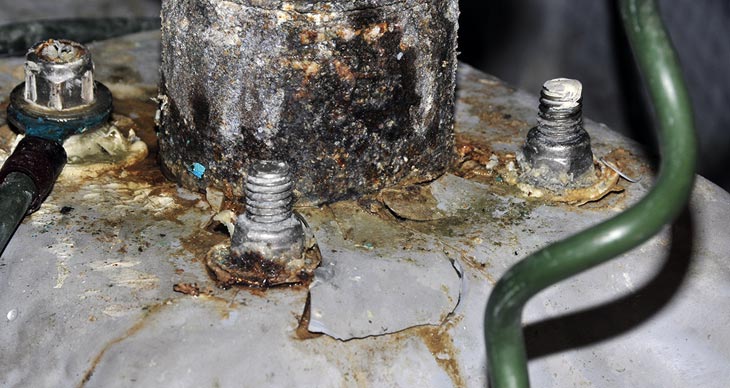
This rudder log is leaking, corroded, and poorly supported, with washers compressing into the backing plate and gelcoat cracking off.
The log transfers tremendous loads and must be exceptionally strong and well bonded to the hull. Fiberglass vessels should rely on a well-tabbed-in purpose-made tube (its filaments are wound and crisscrossed and thus quite strong) that is supported with a series of vertical gussets that distribute the load to the hull’s surrounding structure. On some spade rudder installations, particularly where the log is not, or could not, be long enough, an additional bearing is used at the top of the stock, above the quadrant, where it is supported by the vessel’s deck.
On metal boats the design is similar but with a metal tube welded in place, supported by substantial gussets. For vessels with skeg-hung rudders, the strength of the rudder log is still important. However, because the loads are not imparted by a cantilevered structure, logs used in these applications may be less substantially supported.
Stuffing Box
Unless the rudder log’s upper terminus is well above the waterline or on the weather deck, it is typically equipped with a stuffing box similar to those used for propeller shafts. But unlike a shaft stuffing box, the rudder’s stuffing box shouldn’t leak much, if any, seawater. Because the rudder turns slowly, friction and heat are not a problem. Packing (i.e., waxed-flax packing like that in traditional stuffing boxes) can typically be tight enough to stem all leakage, and lubricating it with heavy water-resistant grease will reduce friction and leakage.
Stuffing boxes that are above the waterline while the vessel is at rest, such as those on many sailboats, are often the most chronically leaky, because the packing tends to dry out and contract. To avoid this, liberally apply grease to the packing material itself; this requires partial disassembly of the stuffing box. Alternatively, a galvanically compatible (316 stainless or Monel for bronze stuffing boxes) grease fitting may be installed and periodically pumped with grease to keep the packing lubricated.
Rudder Bearings

Well-engineered rudder bearings support and lubricate the rudderstock.
Rudder bearings range from the basic rudderstock turning inside a bronze log, to the sophisticated aluminum, stainless, or nonmetallic roller bearings installed in a self-aligning carrier. For most cruising vessels, the choice of bearing is not as important as knowing which type of bearing is in use and its strengths, weaknesses, and maintenance needs. The simple shaft that turns inside a bronze log is durable and reliable but more friction-prone than roller bearings. If lubrication access or a grease fitting is available, it should be pumped with grease periodically, although most rudders rely solely on seawater for lubrication, which is perfectly acceptable.
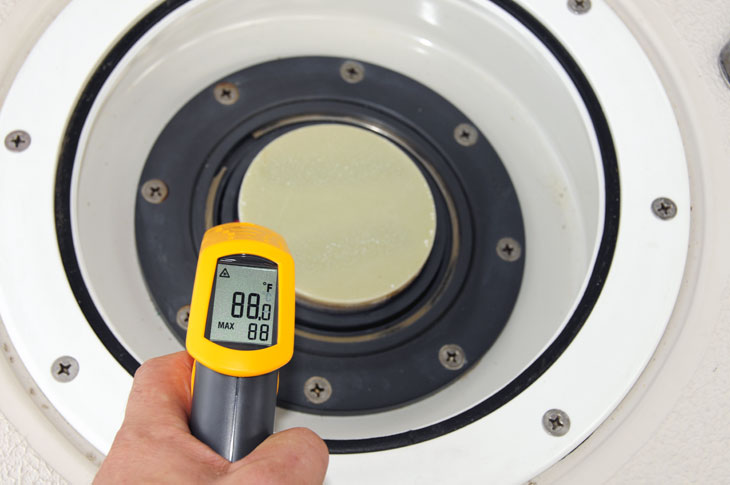
This synthetic upper bearing worked fine in cool temperatures, but when it heated up in the sun, the material expanded and caused binding in system.
Nonmetallic sleeve and roller bearings, often made of ultra high molecular weight polyethylene (UHMWPE), require no maintenance, are extremely slippery, and will not absorb water, an essential attribute for nonmetallic bearings. Delrin and nylon, for instance, will absorb water, expand, and lead to rudder binding. On several high-performance sailing vessels, I’ve had to replace nylon or similar bearings with UHMWPE to restore the steering to its proper specification and effort level.
Propeller Removal
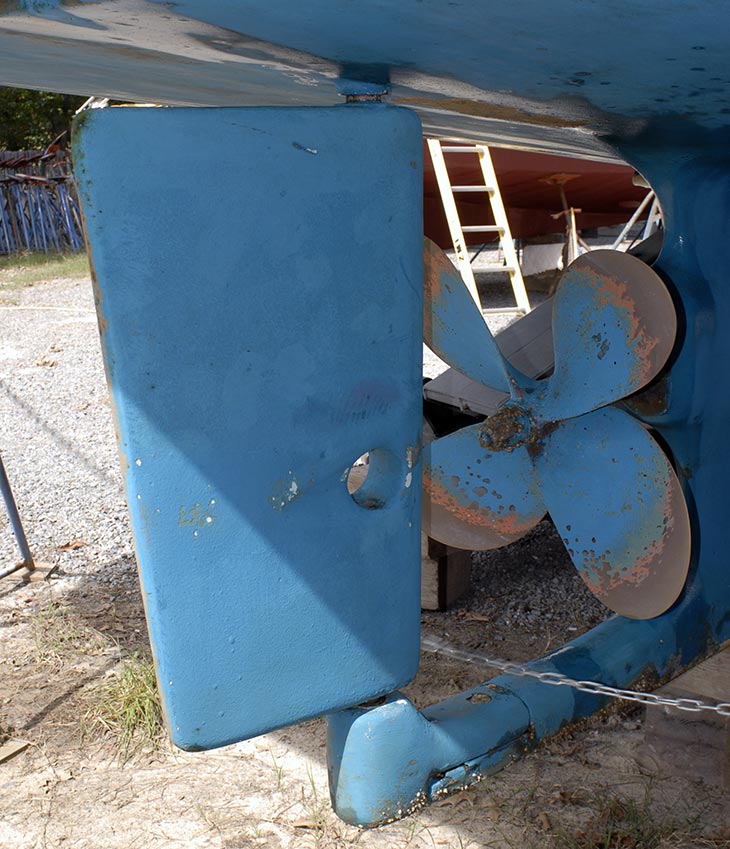
Shaft removal should be possible with the rudder in place. This conventional skeg-hung rudder has a hole to facilitate shaft removal when the rudder is swung hard to port or starboard.
Whether a rudder is a spade or skeg-hung design, it’s important to determine how it will affect the removal of the propeller or the propeller shaft. Is there enough clearance between the shaft’s trailing end and the leading edge of the rudder to allow the propeller to be removed or to use a propeller removal tool? Can the shaft be slid out without removing the rudder? Some rudders are equipped with shaft-removal holes, while others are installed slightly offset from the centerline; or the rudder’s leading edge has an indentation to allow the shaft to be removed. The propeller should be removable without having to unship the rudder. The dimensional rule of thumb calls for clearance of at least the prop’s hub length between the aft end of the shaft and the leading edge of the rudder.
Rudder Stops
The rudder’s movement should be unimpeded as it swings approximately 35° in either direction, making no contact with hull or propeller. Just as important as the rudder travel is how its movement is checked. Other than for the smallest runabouts with jacketed cables, all inboard rudders should rely on hydraulic cylinders to check rudder travel (provided they are designed to do so, and most are) or be equipped with robust stops. Stops must be integral to the hull, supported by substantial tabbing or a welded and through-bolted structure for fiberglass vessels, or by welded angle and shelves for metallic hulls.
About the Author: For many years a full-service yard manager, Steve now works with boatbuilders and owners and others in the industry as Steve D’Antonio Marine Consulting. He is an ABYC-certified Master Technician, and sits on that organization’s Hull and Piping Project Technical Committee. He’s also the technical editor of Professional BoatBuilder .
Read more Repair articles
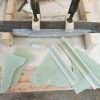
Quick Custom Molds
Making one-off composite parts in the shop.
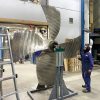
Repairing Bent Props with TrueProp Software
With all the advances in automation and electrification of boat propulsion systems, propellers remain critical to the task of converting power into propulsion. Made of bronze, nickel, aluminum, stainless steel,… Read more »
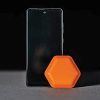
VacPuc Checks Your Vacuum Bags
It’s possible to monitor houses, cars, cats, and boats by smartphone, so why not check vacuum bags during resin infusion? Now composite technicians have this option with VacPuc, a new… Read more »

Recent Posts
- Volvo-Penta’s Bid to Future-Proof IPS
- AIRMAR Achieves World’s First OneNet Product Certification
- Infusing a Workboat Hull with Elium
- Counting Carbon with LCA
- From Langan Design Partners, a Classic Cutter
- Companies (91)
- Construction (115)
- Design (168)
- Drawing Board (11)
- Education (29)
- Environment (18)
- Events (22)
- Materials (55)
- Obituary (18)
- People/Profiles (49)
- Products (18)
- Propulsion Systems (35)
- Racing (17)
- Repair (37)
- Rovings (326)
- Short Cuts (3)
- Sponsored Partner News (19)
- Systems (80)
- Task Sheet (1)
- Uncategorized (29)
- Wood to Glass (8)
ProBoat.com Archives
- Types of Sailboats
- Parts of a Sailboat
- Cruising Boats
- Small Sailboats
- Design Basics
- Sailboats under 30'
- Sailboats 30'-35
- Sailboats 35'-40'
- Sailboats 40'-45'
- Sailboats 45'-50'
- Sailboats 50'-55'
- Sailboats over 55'
- Masts & Spars
- Knots, Bends & Hitches
- The 12v Energy Equation
- Electronics & Instrumentation
- Build Your Own Boat
- Buying a Used Boat
- Choosing Accessories
- Living on a Boat
- Cruising Offshore
- Sailing in the Caribbean
- Anchoring Skills
- Sailing Authors & Their Writings
- Mary's Journal
- Nautical Terms
- Cruising Sailboats for Sale
- List your Boat for Sale Here!
- Used Sailing Equipment for Sale
- Sell Your Unwanted Gear
- Sailing eBooks: Download them here!
- Your Sailboats
- Your Sailing Stories
- Your Fishing Stories
- Advertising
- What's New?
- Chartering a Sailboat
- Sailboat Rudder
Making a Sailboat Rudder for s/y Alacazam
It's not enough just for a sailboat rudder to steer the boat effectively, it should also contribute to the keel's job of providing lift to windward, and for it to do this it must be designed as a hydrodynamic foil.
Of course a rudder doesn't have to provide lift, but it's a wasted opportunity if it doesn't.
As with an aircraft's wing, to develop lift the sailboat rudder must have water flowing over its leading edge at an angle of attack.
Fortunately for us sailors, the pressure of air on the windward side of the sails, pushes the boat bodily off course slightly and it's this leeway that provide the angle of attack - or angle of incidence- that enables our keels and rudders to provide lift.
But What Type of Sailboat Rudder would be Best for Alacazam ?
First, we considered twin transom-mounted rudders. The usual argument for twin rudders is:
- as the boat heels, the leeward rudder is more deeply immersed and provides better control, and
- the boat, resting on the keel and two rudders can dry-out upright.
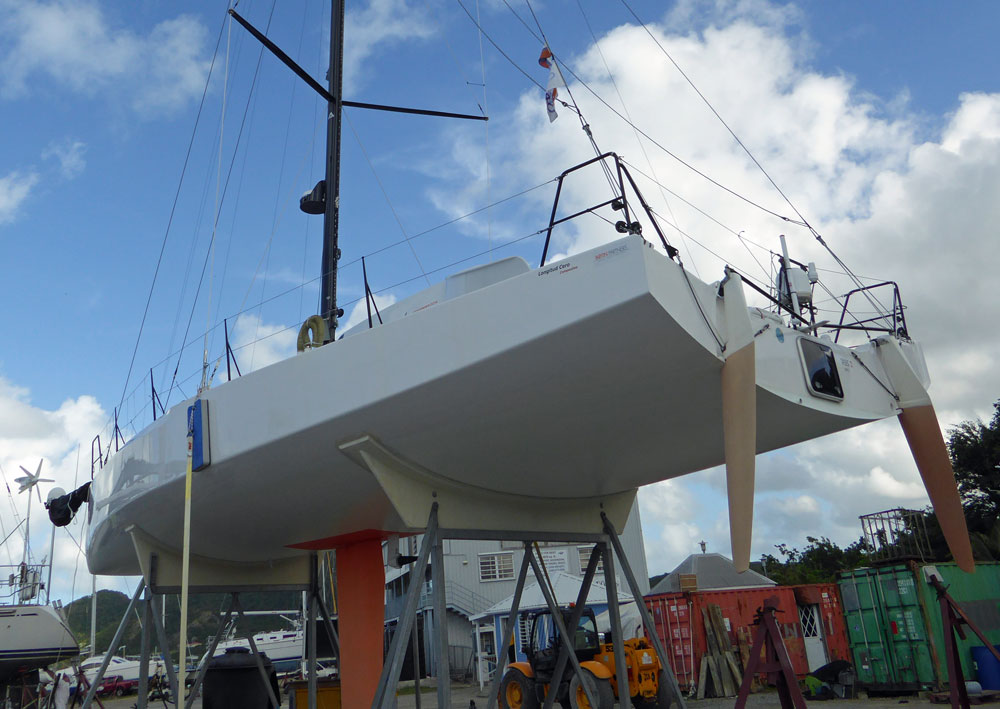
But in the end we decided against the twin rudder arrangement because:~
- with Alacazam's deep draught (7 feet, or 2.2m) the twin rudders wouldn't be deep enough to achieve the drying-out upright benefit, and
- the mechanical complexity of tiller steered twin rudder system went against one of our key design principles - keep it simple, and
- with no propwash flowing over the rudders, manoeuvring under power in tight situations would be a little too interesting for my tastes.
So the conventional single rudder approach it was to be. But what type of sailboat rudder?
A Transom-Hung Rudder
We liked the simplicity of this arrangement, but it didn't suit Alacazam's hull design at the stern. We wanted a sugar-scoop design with a bathing platform to allow easy access from the dinghy which ruled out a transom hung rudder. Similarly, it meant that mounting the servo-pendulum self-steering gear would be unnecessarily complicated.
Spade Rudder
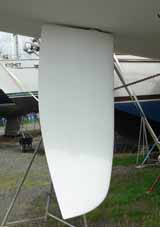
The spade rudder is the most efficient of all sailboat rudders, which is why you're unlikely to see any other design on racing yachts.
The absence of a skeg means that all of its area is used to apply a turning force to the hull, minimizing wetted area and associated drag.
The area ahead of the stock helps to balance the rudder, making life easier for the helmsman.
But it's not the most robust design, being entirely dependent on the strength of rudder stock to resist impact damage.
Theoretically it's just a matter of engineering, but high performance spade rudders just aren't thick enough to incorporate a rudder stock of sufficient diameter for ultimate security.
Skeg-Hung Rudder
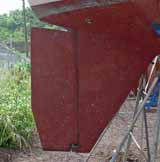
Other than those rudders hung on the following edge of long keels, the skeg hung rudder - supported top and bottom on a full length skeg - is the most robust design.
Without a portion forward of the stock, there's no balancing force to take the load of the helmsman's arms - so loads can be quite heavy in some designs.
Nevertheless, it's a very popular design for offshore cruising boats.
Semi-Balanced Rudder
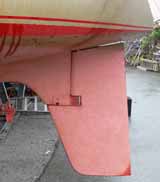
This design of sailboat rudder is something of a compromise between the spade rudder and the full skeg rudder.
Supported at its mid-point by a half-depth skeg, it benefits by the area forward of the stock, below the skeg.
This applies a balancing force as the rudder is turned making the steering lighter than it would otherwise be. And it was this design we chose for Alacazam's rudder.
Making Alacazam's Rudder

A typical productions boat's rudder is likely to have been fabricated as shown here, with two GRP mouldings 'clamshelled' around a foam core.
Not the most reliable arrangement you might think - and you'd be right.
We wanted something a little more robust for Alacazam's rudder.

But first, the rudder stock.
We fabricated this from a 2" (50mm) diameter stainless steel solid bar and welded on flat stainless tangs that would be embedded within the rudder.
The Admiralty Bronze casting will eventually connect the rudder to the skeg.
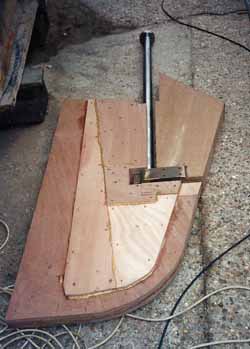
With the rudder stock fabricated, we began the construction of the rudder core.
It was made up from half inch (12mm) marine ply sheets, cut to shape and incorporating cut-outs for the tangs, screwed and glued together.
The rudder and skeg was built up as a single unit at this stage.
The rudder design software generated coordinates for various stations along the rudder, and we used these to cut templates so that we could get the shape right.
Shaping the rudder profile was done by hand, initially with a plane to remove the excess, then with a file and diminishingly coarse grades of sandpaper.
Once the rudder profile matched the appropriate template we removed the section that would form the skeg.
Next, the rudder was fitted to the stock with any gaps between the tangs and the ply taken up with high-strength epoxy 'gloop'.
Finally both the rudder and the skeg were sheathed in several layers of epoxy-glass rovings before being filled and faired with epoxy fairing compound.
Fitting the Sailboat Rudder
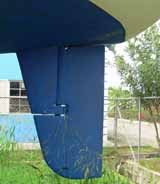
The skeg was letter-boxed through a slot cut in the hull, securely braced internally and bonded to it with fillets of high-strength epoxy and epoxy glass rovings.
Inside the hull we had constructed a GRP tube to contain the stock, and the skeg was also bonded to the lower end of that.
The rudder was then securely fitted to the stock via the bronze bearing, and located at the top of the rudder by a stainless steel bearing.
That's it, we now have a very robust and efficient rudder securely attached to Alacazam's hull.
Recent Articles
Amel Kirk 36 Sailboat Specs & Key Performance Indicators
Sep 07, 24 03:38 PM
Pearson 33 for sale
Sep 04, 24 03:29 PM
Apla 42 Sailboat Specs & Key Performance Indicators
Aug 30, 24 02:51 AM
Here's where to:
- Find Used Sailboats for Sale...
- Find Used Sailing Gear for Sale...
- List your Sailboat for Sale...
- List your Used Sailing Gear...
Building Alacazam...
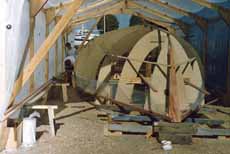
But why go to the bother of building your own boat?
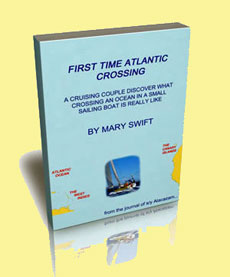
Copyright © 2024 Dick McClary Sailboat-Cruising.com
- MEO Class 4
- _Epareeksha MCQ
- Machineries
- _Main Engine
- _Aux Engine (D/G)
- _Air Compressor
- _Freshwater Generator
- _Hydrophore
- _Refrigeration
- Naval Arch.
- Electricity
Ship Rudders: Parts, Function, Types with simple diagram

Post a Comment
>> Your Comments are always appreciated... >> Discussion is an exchange of knowledge It Make the Mariner Perfect.... Please Discuss below...
Our website uses cookies to improve your experience. Learn more
Contact Form

Ridetheducksofseattle is reader-supported. When you buy through our links, we may earn an affiliate commission. Learn more
What is a Rudder on a Boat? (Identify, Purpose, Features & More)
Written by Anthony Roberts / Fact checked by Jonathan Larson
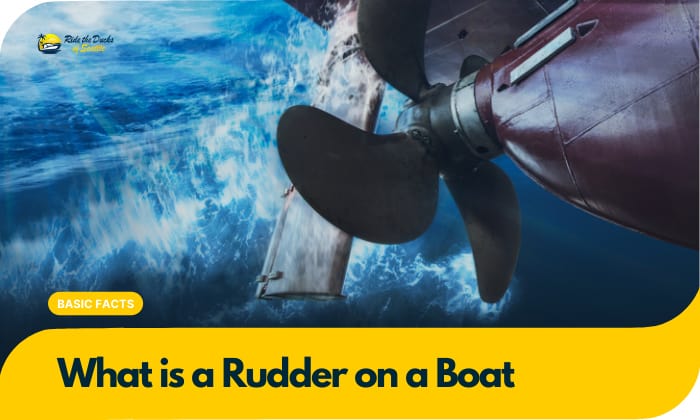
Seasoned sailors say controlling a vessel’s directions is easy if you know rudder mechanics and controls. But what is a rudder on a boat? The rudder is a vessel’s equivalent of an airplane’s vertical stabilizer (or tail) rudder, allowing boaters to steer the watercraft left or right.
Please keep reading because more fascinating facts about this integral component of boat or ship steering mechanism await. We will talk about its history, operation, purpose, types, and more.
Let us start learning more about the rudder of a boat or ship.
Table of Contents
Defining the Boat Rudder
A history of vessel steering, purpose of a boat rudder, how do rudders work, essential features, how to identify a boat rudder, the look of a marine rudder, 1. balanced rudders, 2. unbalanced rudders, 3. semi-balanced rudders, 4. skeg-mounted rudders, 5. flap rudders, frequently asked questions.
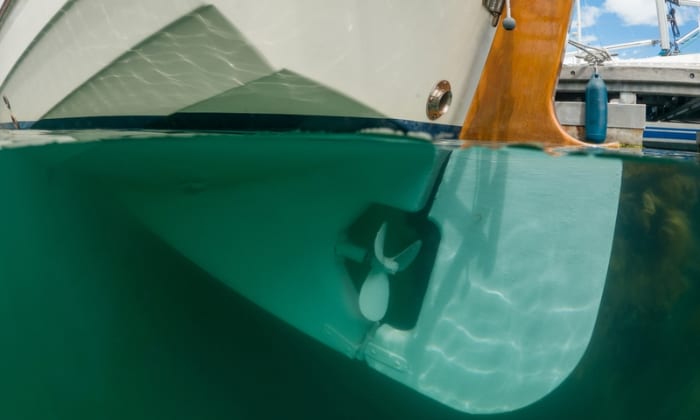
Conventional axial rudder definition conjures an image of a vessel’s control surface, allowing the boat or ship to steer in the desired direction. The control surface or “blade” swivels left or right on a vertical axis, hence the name “axial rudder.”
So, what does rudder mean? This term implies a steering component requiring other elements to control its movements or actions.
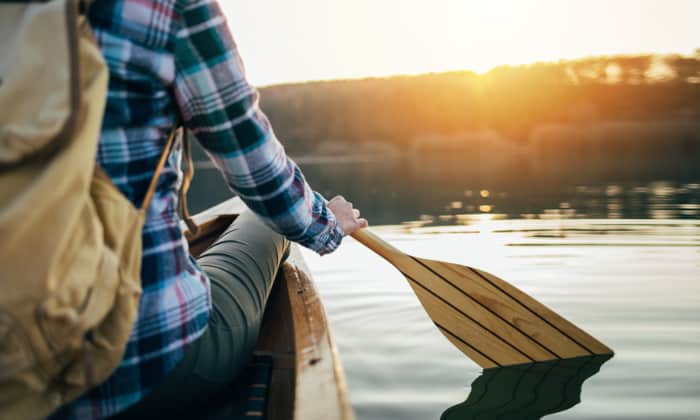
It is challenging to ascertain the answer to the question, “when was the rudder invented?”
- The most definitive answer we found is in the 1st century AD. Han Dynasty Chinese was the first to develop a stern mounted rudder that resembled modern days’ ones.
- However, other experts say the ancient Phoenicians used an oar to steer their watercraft across the Mediterranean between 1550 and 300 BC. Even older are ancient Egyptian claims, featuring specially-designed oars for steering vessels between 2686 and 2134 BC.
That said, it’s worth noting that steering oars, including the ancient ones we mentioned above, do not typify the modern boat rudder. Unsurprisingly, many scholars refute the 2686-2134 BC rudders invention date, underscoring its limited use to small vessels and the tendency to interfere with sail handling.
Thus, although steering oars played a vital role in sternpost rudder development, the consensus regarding the rudders original date of invention is between 202 BC and 220 AD Han Dynasty Chinese with their sternpost-mounted rudder.
- Afterward, this hydrodynamic component allegedly reached Europe and the rest of the world during the Middle Ages thanks to the birth of tourism, massive ecclesiastical reforms, and higher educational expansion.
- In 1843, English mechanical and civil engineer Isambard Kingdom Brunei designed the “balanced rudder” and fitted it into the SS Great Britain. It’s the rudder design we know nowadays, considering it’s remained unchanged ever since.
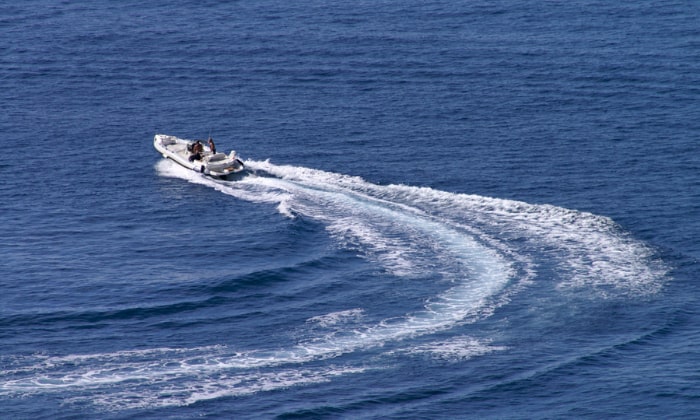
It should be easy to answer the question, “what does a rudder do?” after understanding its fundamental definition. Operating the rudder allows it to move right or left on its axis, changing the vessel’s direction.
However, folks must note that rudders (sternpost or axial) function in other ways as well. For example, some systems guarantee efficient and ultra-smooth treading in the water, while others allow for sharper turns.
Moreover, some rudders ensure optimum operational ease and maximum vessel stability, while others protect watercraft from potential water debris-related damage.
The rudder on a ship relies on unequal water pressures.
Imagine the rudder as a board parallel to water movement. Changing the boat rudder direction (i.e., right or left) exposes the blade’s surface to oncoming water flow.
This action increases the pressure on the side directly facing the water flow while reducing pressure on the other side. The resulting unequal pressure pushes the rudder and swings the boat’s hull in that direction.
To turn the rudder of a ship, you can rely on electrical machinery, steam-powered systems, and hydraulic mechanisms. However, small vessels only require a manually-operated handle, usually known as a helm or tiller.
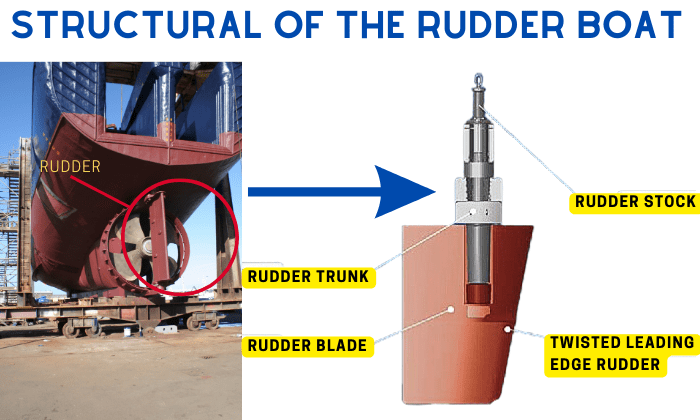
If you present non-boating community members a ship rudder picture, there is a good chance all they see is a simple plane sticking out vertically at the vessel’s bottom rear. However, this vessel steering component has several elements or features that allow it to function as designed.
- Rudderstock – stainless steel, aluminum, carbon fiber, or bronze shaft, rod, or tube connecting the boat’s steering system to the rudder’s “flat plane” or “blade.”
- Rudder log – a rudder supporting element, which the rudder stock passes through.
- Rudder bearings – similar to ball bearings, these components allow the rudder to move across its range of motion.
- Stuffing box – a compartment that contains “heavy, water-resistant grease” for leak prevention and friction reduction that comes from rudder movement.
Identifying a marine rudder is not difficult, especially if we know its location. Unlike most vehicles with steering systems controlling the front wheels, a boat’s rudder system is almost always at the stern, which is the vessel’s rear.
Hence, you only need to check this part of the ship to identify a marine rudder. The basic design assumes a “flat blade or plane” hanging from or connected to the sternpost.
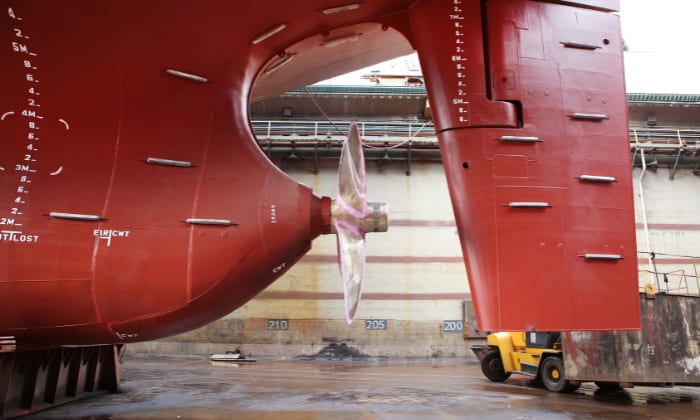
Marine rudders vary in design, depending on several factors. These influences include propeller design, hull form, stern-to-propeller clearance, stern structural arrangement, vessel speed, and hydrodynamic aspects. The final rudder shape, size, and configuration reflect these parameters.
However, most marine rudders have a straightforward look – a large, flat surface, sheet, plate, blade, or fin connected to the vessel at the rear or aft section.
Types of Rudder
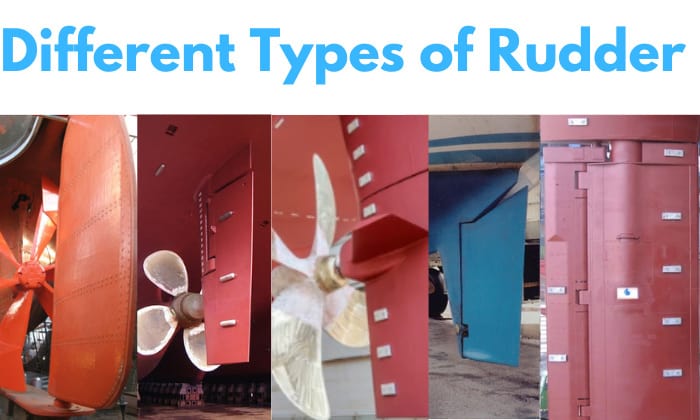
Modern vessels feature different rudder types with characteristic design features and functions, as shown below:
Balanced rudders function best on medium- to large-sized ships that require efficient and steady sailing.
Simply put, it’s a rudder plate with the uppermost part connected to the stock with the bearing inside the hull. In addition, it must be supported with a bottom pintle. A spade rudder is also a sub-category of balanced ones, although it has a longer stock to accommodate the lack of a pintle on its underside.
The difference between these two designs is that balanced rudders with a supporting pintle are mostly used for single-screw ships, whereas spade rudders can go with either single- or twin-screw vessels.
This type of rudder has its blade length supported by a rotation axis or rudder stock. Its blade is exposed to bending moments, while its steering gear is what provides the turning torque.
In most cases, unbalanced rudders can only be found on small boats that call for the ability to make tight turns, such as watercraft for skiing.
This marine rudder design marries the remarkable benefits of balanced and unbalanced rudder systems. It’s called its name because only its lower half is what keeps the balance in its design (meaning the lower half doesn’t rotate on a rudder stock axis).
The most noticeable benefit of semi-balanced rudders is their responsiveness, making steering the vessel much easier and smoother – you don’t even need to exert too much force to turn the rudder.
Used for better vessel protection against debris collision and impact due to its structural strength, the skeg-mounted rudder is also available in unbalanced, balanced, and semi-balanced ones. Although somewhat difficult to turn, it’s suitable for both single- and twin-screw ships.
These rudders feature a hydraulically or mechanically activated trailing edge flap-integrated blade. It allows boats to improve their maximum lift by up to 70%, ensuring exceptional maneuverability.
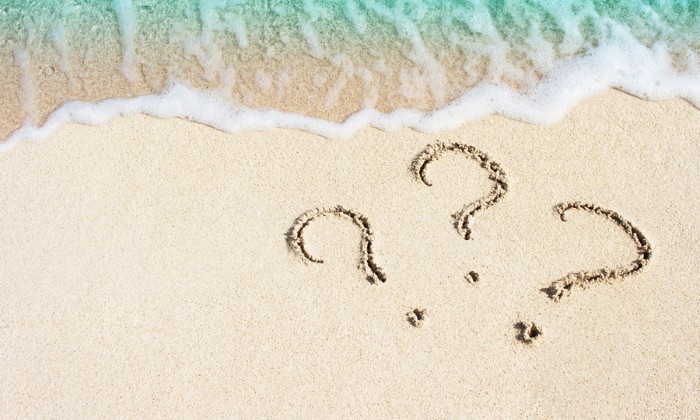
Can you steer a boat without a rudder?
Yes, you can steer a boat without a rudder. However, the solutions are not as efficient and effortless as a rudder.
Most boaters would tie a drogue, sail bag, or several buckets on a line and drag them behind the boat. This setup will allow some degree of steering and reduce the watercraft’s speed.
You can also improvise with a door or floorboard, lashing it on the vessel’s exterior transom via a spinnaker pole.
How much does it cost to rebuild rudder?
Rebuilding a boat rudder can cost you about $3,500, depending on various factors. For example, you can expect more than 140 hours to rebuild the rudder. Multiplying this by $8 to $9 an hour puts the bill at $1,120. Some rudder rebuilders might charge more.
The materials can cost about $1200, plus an extra $200 to $250 for repairing the fiberglass sections next to the rudder. Rudder fabrication can cost you around $1,100 but can be costlier depending on the fabricator.
Is tiller same as rudder?
No, a tiller differs from a rudder . The former is a manually-operated handle or rod connecting to the rudder. You can find this component in transom- or outboard-type rudders.
What is a rudder on a boat? Although ascertaining its “date of invention” can be daunting, a rudder’s simplest definition is a vertical plane or blade that skippers or helmspeople manipulate to change a vessel’s heading or course.
Rudders might have come from humble beginnings as steering oars, but 19th-century innovations gave rise to modern rudder designs. We cannot imagine a 21st-century watercraft without a rudder. After all, it is an integral steering system component.

Ten years of enjoying countless trips on boats never made me love them any less! So I am here to put all those experiences into good use for other boaters who want to have a safe and fun trip with their friends and families.

- Yacht Brokerage
- Ocean Explorer 60
- Ocean Explorer 64
- Ocean Explorer 72
- Ocean Explorer 78
- Yacht Conveyancing
- Selling your yacht
- Yachts we list and yachts we sell
- Buying a Yacht
- The Yacht Purchase Process
- Yacht VAT, RCD and Registration
- Yacht Finance
- Yacht Insurance
- Further Yacht Services
- +44 (0)1590 673715
Choosing a Blue Water Yacht – Rudder Type
Posted Wednesday 15th July 2015

Over the last few weeks, Grabau International has taken you through a variety of subjects which encompass choosing the right yacht for blue water adventures. This guide is not written to dictate what to choose, or to supply a comprehensive encyclopedia of every option and variable, but simply a basic explanation of the main options and some guidance on what to look out for. Finding a yacht will always be a battle of your head over your heart, so the purpose of this guide is to give your head some questions to ask in the hope that an amicable compromise can be made with your heart. Part 4 of this guide looks at the question of rudders and steering .
Yachts use aft-mounted rudders to change direction and to counter the effects of weather-helm (where the yacht naturally tries to turn into wind when pressed to windward). Using either a wheel connected to the rudder stock via a linkage system or a tiller attached directly to the rudder post, the rudder can be turned creating a force of water striking one edge of the rudder blade to turn the stern in the opposite direction.
The type of rudder and fitted to a yacht is often directly related to the type of keel which was covered in part 3 of this guide , and the type of steering is usually dictated by the size and position of the cockpit and space directly beneath or aft of it.
As always, due to the huge variety of yachting pursuits, different rudder types work for different purposes. Those looking to go racing will almost certainly require a high aspect fully-balanced rudder whilst blue water sailors may wish to seek the additional strength and protection afforded by a fully or semi-skegged rudder blade.
Spade Rudder
Where the blade hangs down beneath the yacht and is self-supported by the stock. By moving the rudder stock aft from the leading edge, a spade rudder becomes a balanced rudder.
Balanced Rudder
The ‘balanced’ part comes in by virtue that the axis of rotation is behind the leading edge which means that when the rudder is turned, the pressure of water caused by the yacht’s movement through the water acts upon the forward part to counteract the force of resistance exerted by the larger aft section. The end result is a very light and reactive helm which is perfect for more performance-orientated yachts. Balanced rudder configurations are also usually married with fin keel profiles to further aid maneuverability and performance.
The downsides with spade and balanced spade rudders are the complete reliance upon the rudder stock to maintain structural integrity and the lack of protection to the leading edge of the blade from underwater impacts. Having seen a car drive into the rudder blade of a Volvo 70 (whilst ashore!) and the damage caused to the car whilst no apparent damage was caused to the rudder blade, a well-designed balanced rudder should offer few concerns for the cruising yachtsman.

Balanced rudder on a Frers-designed Nautor Swan
Skegged (semi or full) Rudder
A slightly more traditional and ‘belt & braces’ approach where the rudder is further supported, either at the bottom of the blade (fully-skegged) or midway down the blade (semi-skegged). This will usually be stronger and provide better resilience against impact. The moulded skeg can often help to guide any lobster pot or fishing lines downwards towards the bottom of the blade rather than jamming themselves against the stock. Most fully-skegged rudders are not balanced, so they may take a little more effort to steer, but it is possible with semi-skegged rudders to place the stock far enough aft to provide a balancing effect.

Semi skeg rudder on Malo 46

Full skeg rudder
Full keel rudder
Yachts with long-keels, such as Island Packet and most classics, have a rudder which is hinged to the aft edge of the keel, forming a continuous surface. The engine’s propeller is then usually positioned in an aperture at the aft end of the keel, but forward of the rudder blade. This configuration offers immense strength and protection, but the steering can be quite heavy as there is no balancing effect.

Full keel rudder on Tradewind 35
Outboard rudder
Mostly found on yachts beneath 30ft, outboard rudders are mounted outside of the hull on the yacht’s stern. Most outboard rudders are turned using a tiller rather than a wheel as there is no rudder post to connect the steering gear. Outboard rudders do not require a hole through the hull for a rudder post and are less likely to cause structural issues if damaged, but they are more exposed and therefore vulnerable and it is very difficult to balance them, so steering can be heavier than with a fully-balanced spade rudder.

Outboard (transom-hung) rudder on Hunter 707 sportsboat
Twin Rudders
Increasingly common on cruising as well as racing yachts as transom-profiles get broader. Twin rudders can be either spade or skeg-hung and can be reinforced to allow the yacht to take the ground when used with a lifting keel profile. Yachts fitted with twin rudders will lose the benefit of ‘prop wash’ to aid maoeuvering astern, but the practical benefits in terms of sailing to windward and (in some cases) drying out make them the only option in many cases.

Twin rudders on a modern Southerly lift keel yacht
Steering Systems
Wheel Steering
Now almost universal on all but the smallest of yachts. Large yachts (or those with broader transoms) will often have twin wheels which have their advantages -they do not encroach on cabin space beneath the cockpit sole, and also allowing clear & unobstructed passage from the cockpit the bathing platform. Wheel steering systems can be connected to the rudder stock through a variety of linkages including rod, cable, chain and even hydraulic steering systems.

Twin wheel steering on an Italia Yachts 15.98
Tiller Steering
Rarely found much above 28 feet unless for racing duties (where they can appear on yachts even as larger as TP52’s), but definitely appealing to those who like the K.I.S. (keep it simple) approach thanks to direct connection to the rudder stock. The downside is that generally the area either athwartships or aft of the tip of the tiller is a ‘no go zone’ to anyone other than the helmsman.

Tiller steering on an Italia Yachts 9.98
Rudder Stocks
These can be alloy, stainless steel or composite. Alloy is popular on high-end yachts as it is strong and light. Stainless is much heavier but perhaps less susceptible to pitting and swelling, but can suffer crevice corrosion. Composite can be found on mass-production yachts or custom high performance yachts. There is no ‘best option’, but be sure to inspect the stock very carefully before embarking on any serious ocean mileage.
Back to News
Contact us at
[email protected], subscribe to receive our monthly news updates.
Click here to subscribe
GI Lymington (HQ)
+44 (0)1590 673715 [email protected] Email Lymington
GI South Coast
+44 (0)1590 902210 [email protected] Email South Coast
+44 (0)7973 301668 [email protected] Email London
GI Scotland
+44 (0)7988 763254 [email protected] Email Scotland
+39 333 74 89 281 [email protected] Email Italy
+34 675 236174 [email protected] Email Palma
GI Scandanavia (Finland)
+358 408 098688 [email protected] Email Finland
GI Scandanavia (Sweden)
+358 406 861501 [email protected] Email Sweden

Terms and Conditions | Privacy Notice & Privacy Policy | Cookie Policy | Contact Us Site Map --> © 2024 Grabau International. All rights reserved. Company Registration Number: 9374773
Terms and Conditions | Privacy Notice & Privacy Policy | Cookie Policy | Contact Us | Site Map © Grabau International. All rights reserved. Company Registration Number: 9374773
Grabau International Email Newsletter
Enter your details below to receive our monthly email newsletter and further news on upcoming events and services.
Please select your area of interest Sailing Motor Both

- Privacy Overview
- Strictly Necessary Cookies
This website uses cookies so that we can provide you with the best user experience possible. Cookie information is stored in your browser and performs functions such as recognising you when you return to our website and helping our team to understand which sections of the website you find most interesting and useful.
Strictly Necessary Cookie should be enabled at all times so that we can save your preferences for cookie settings.
If you disable this cookie, we will not be able to save your preferences. This means that every time you visit this website you will need to enable or disable cookies again.
RetireFearless
Rudder Types for Sailboats
A rudder is a one-of-a-kind technological achievement for sailboats. There are a handful of rudder types for sailboats to allow sailors to steer.

March 16, 2023
This article may contain affiliate links where we earn a commission from qualifying purchases.
Today’s sailboats use various rudders that serve unique purposes in steering or performance. You are probably wondering which rudder type you have on your boat and which one is best.
There are four types of rudders, which are skeg, spade, outboard, and full. Depending on the size of the boat and the hull will determine which rudder it will need. In addition, each rudder type will have a slight variation that will meet certain expectations of performance on the boat.
Sailors need to rely on a rudder in order to steer their boat efficiently. Each boat will not have the same rudder, as different styles of sailing require different rudders.
According to experienced sailors, each rudder has its pros and cons. However, the best rudder needs to match your expectations in sailing.
Table of Contents
Rudder Types
With the four rudder types mentioned, each one will have its pros and cons. As you begin your travels on bluewater or are interested in learning more, then it would not hurt to check out what each rudder is designed to do.
Full Keel Rudder
If you were to picture a sailboat with a rudder, it would likely be a full keel rudder. The most common rudder type is the full since a lot of sailboats use a full keel.
The reason a full keel is the most common keel on a sailboat is that it is the best one to provide stability. In that case, you need a rudder that can accommodate that type of boat.
On a full keel sailboat , the rudder looks like it is part of the keel itself. It is actually attached on a hinge, giving it the appearance that it is fully connected to the keel.
Advantages of a Full Keel Rudder
A full keel rudder is quite strong and actually helps tremendously with the protection of the boat. During a strong storm or harsh waves, it can be easier to navigate with this type of rudder. In addition, debris is significantly less likely to snag on anything like other rudders.
Disadvantages of a Full Keel Rudder
While a full keel rudder might be the best one to handle in strong storms, it is still the most difficult rudder to handle. Since the flow of the water is providing pressure on the full keel, it makes it harder to move the rudder. You would need to put a lot of effort into steering, especially in harsher conditions.
Skeg Rudders
Skeg rudders might give a full keel rudder a run for its money due to its durability. These are often referred to as skeg mounted rudders.
These are similar to full keel rudders, but can also be used on fin keel boats . This alone gives it a slight edge over full keel rudders, but each boat design will differ.
Advantages of a Skeg Rudder
With similarities to a full keel rudder, you are going to have the stability as well in a skeg rudder. The added bonus is that it works in either a full keel boat and a fin keel.
Disadvantages of a Skeg Rudder
Just like a full keel rudder, all of the pressure of the water hits on one side or the other. This means it will be hard to turn in rough conditions.
Spade Rudders
These rudder types are best fit for a fin keel boat rather than a full keel or to the types of boats. It enters straight down into the water and can rotate left or right using a post that extends within the hull.
Advantages of a Spade Rudder
The best advantage of a spade rudder is that it can be part of the fin keel. You can turn this rudder much easier than a full keel rudder or skeg rudder. The water is not forced one side or the other, allowing a better flow and easier turn.
Disadvantages of a Spade Rudder
If you sail upon a lot of debris in the water, you are likely going to damage the rudder. These are more delicate than skeg or full keel rudders, as they are more exposed.
Debris can get caught in between and potentially wrapped within the space rudder. In addition, rough water can be a nightmare. Tough conditions can cause enough pressure to bend or potentially break the rudder.
Outboard Rudder
Outboard rudders are not attached to the boat’s hull and are mounted outside at the back . Typically, these are not connected to a steering wheel and are connected by a tiller.
A tiller is a steering lever that can take some getting used to if you have solely used steering wheels. On smaller boats, sailors actually like a tiller over a wheel.
Advantages of an Outboard Rudder
If an outboard rudder becomes damaged, it will not typically affect the rest of the boat. This is because there is not a rudder post through the hull.
In the event that you damage it while at sea, you have the opportunity to fix it. Since it is on hinges and not attached to the hull, it might be able to be fixed. This also means the rudder might be stronger than other rudder types.
Disadvantages of an Outboard Rudder
Since the outboard rudder is at the back of the boat, it is vulnerable in some situations. If floating debris or something like a rope is in the water, it can tangle up in the rudder or damage it.
The location of the rudder also makes it harder to turn than a spade rudder. In tough conditions, this might be difficult to turn.
Purpose of a Rudder
A rudder is one of many important components of a boat to operate as efficiently as possible. Some boats are built for speed and others for comfort, so a rudder also has to fit that category.
Water pressure will dictate how the rudder moves in the water. Whichever direction you turn the rudder, then water pressure will push against it and allow you to turn.
While a sailboat is turning, it is pivoting around a middle point of the boat. The stern and bow move at the same time, while the middle point of the boat remains in place. Knowing how to properly operate a rudder to steer can make a huge difference in avoiding a crash.
Variations of Rudders
While some rudders are fairly cut and dry for their intended use, other rudders have slight variations to the design. This allows a little bit of flexibility on some boats, which is great because not all boats are designed the same.
Balanced Rudder
A balanced rudder is a form of a spade rudder with a slight difference in free space at the top. The leading edge allows rotation from one side of the boat while the trailing edge goes opposite.
The post is also a few inches back from the front of the rudder, which is slightly different from a regular spade rudder. Even though the turning action is roughly the same in comparison to a spade rudder, the force on the helm has more balance and makes it easier to steer.
You will usually see this type of rudder in performance boats or yachts. Furthermore, they are always paired with a fin keel to provide the best performance overall.
The only drawbacks to a balanced rudder is that it is susceptible to debris if you were to run anything over in the water. You have to rely on the structural integrity and hope that it is strong enough to take a blow. If it were to fail, it does not revert back to the center and might make it difficult to navigate the boat.
Unbalanced Rudders
Unbalanced rudders have the support from a full length skeg and are attached to the furthermost point of their span. It is unbalanced because the entire rudder is aft of its axis or the centerline where the rudder stock is located.
When you begin turning this rudder type, you get all of the force on one side. Whoever is steering the boat will notice this feeling compared to other rudder types, especially when using a tiller.
As you can gather, these rudder types are not commonly used today. You might find one used in history books or replicas of older boats.
If this were commonly in use today and were to fail at sea, the rudder remains in place and not go back to the centerline. This caused serious issues in the past and arguably why it is not very popular anymore.
Semi-balanced Rudders
If you can picture what a balanced and unbalanced rudder would look like, then a semi-balanced rudder is something in between. The name suggests that it is partially balanced and unbalanced at times.
The top part of the rudder is unbalanced, while the lower part is balanced. With the top part being this way, it helps by providing structural support to the rudder by aiding in vertical displacement.
During this process, the balanced section will endure less torque pressure during swings. It will then return back to the centerline if the steering equipment fails, which is a critical aspect that balanced and unbalanced rudders did not originally have.
Semi-balanced rudders are also different from other types since they vary in size and shape. You will often hear sailors talk about the depth of the horn, which is the connection between the rudder and the boat.
A shallow horn rudder has a horn that extends less than half of the chord length from its top. In a deep horn rudder, the horn extends more than 50 percent of its chord length from the top.
Semi-balanced rudders have had some unique innovations over the years. They appear to be the best of both worlds between balanced and unbalanced.
Twin Rudders
Twin rudders have been used since 1980 among racing boats. Over the last decade or so, they have increased in popularity among cruising sailboats.
Twin rudders have a history of being difficult to operate in tight spaces if you do not have experience with them. This is true, especially since it navigates a little differently than one rudder.
When using a boat that has a twin rudder, the prop wash moves by both rudders and you cannot have the same maneuverability as with one rudder. One tactic you could do is to increase your boat speed to increase water flowing between the rudders. In doing so, it could cause some concern in tight spaces if you are unable to land exactly where you want.
One positive to twin rudders is that it performs well in reverse. You do not have as much prop walk as other boats and can handle better in lower speeds due to increased blade length on both rudders.
Another benefit is that it responds better to the wind. In single rudder boats, the wind can push the bow in one direction while the stern goes opposite. For twin rudders, the wind does not have as much of an impact in that regard.
Can Rudders Fail While in Use?
Just like anything in life that you use, it has a lifespan on it. For a rudder, some can fail while you are using them at sea.
Rudders failing at sea is actually a common hazard, so knowing what to do in that situation is very important. Sometimes cheaper boats, like a fiberglass boat, will experience a rudder failure likely before a more expensive boat.
The material of the rudder pole has to be a good blend of flexibility and strength. If it is too weak, it will break. If it is too strong, it might damage the hull since it cannot flex properly.
The framework inside the rudder should be a heavy-duty metal, because if it breaks, then it will be unusable. This is likely the case in cheaper boats, where costs have been cut in certain areas. Depending on the boat brand, you might see welding jobs that are not executed properly for rudders.
In addition, the type of rudder you use at sea can make a big difference. Full keel rudders might be the best option since it is protected from debris and offers the best stability. Depending on your sailing goals, the right rudder type will be different for everyone.
What are Rudders and Stocks Made out of?
Rudders have historically been crafted out of heavy duty stainless steel or aluminum. You want something that is non-corrosive and can withstand some beating.
If you were to look at high performance yachts, these typically have alloy since it is lighter but also strong. Stainless steel can handle swelling and debris, but crevice corrosion could be an issue.
Composite is another material that is used in mass production yachts or high performance boats. Some material is arguably better than others, but there is really not a perfect option out there. A proper inspection is needed before doing any long term use at sea.
Why a Tiller Could be Better than a Wheel for Rudders
If you have sailed a boat with a steering wheel and have never used a tiller, you could be missing out. Regardless if you are new to sailing or a seasoned pro, a tiller is very easy to use.
Tillers provide instant feedback when turning a boat, whereas steering wheels take a minute to get results. For newer sailors, a wheel could prove to be frustrating in rough conditions.
Depending on the size of your boat, a wheel might be the better option. In larger boats, a tiller does not perform the same.
Even though a tiller is harder to turn, it still offers an immediate reaction. This is why you will oftentimes see tillers on racing boats because they provide instant feedback.
What Happens if Your Rudder Fails?
While safety is a priority in everything you do while sailing, there are some situations you cannot avoid. No matter how much preventative maintenance you do, your rudder might still become damaged or unable to use.
If bearings have seized, the rudder can become difficult to move at first but will eventually lock up. Your steering capability will eventually be impossible and quite difficult to stop the boat from rounding into the wind.
If it were to fall off completely, then you will have quite a difficult time tracking the boat. The rotation of the boat might even be abrupt or rapid.
It is important to stay calm during a situation like this and to check on the crew. Drop your sails and attempt to gain some control.
You could even try pointing the bow into the wind and dropping anchor to reduce motion. Once the boat is under control, check for damage and call for assistance.
If you cannot phone for assistance, the best thing you can do is to create a makeshift rudder or potentially purchase one before a situation like this happens. For example, brands like Seabrake and Delta Drogue are quality rudders you could use in a pinch to safely make it back to shore.
Recent Articles

What Size Sailboat Can One Person Handle?

How To Tie A Sailboat To A Mooring Ball Ring

What Is The Ideal Wind Speed When Sailing?

How To Use a Sailboat Winch

Things You Need To Liveaboard a Sailboat

Types of Sailboat Keels
I'm Michael Moris. I've been sailing my whole life, and it has taken me to places I never imagined. From the Caribbean to Europe, from New Zealand to South America - there's nowhere that hasn't felt like home when you're on a boat!

Trending Articles

How Far Is Havana From Miami By Boat?

Yachting Vs Sailing

Who Is Sailing Doodles?
Subscribe To Our Newsletter
Thank you! You're signed up for our free newsletter!
Oops! Something went wrong while submitting the form
About Our Team
We are a publishing team of licensed Nursing Home Administrators, Nurses, Assisted Living Directors, Health Professionals, Gardeners, and individuals with vast experience with senior living and activities.

©2024 Retire Fearless. All rights reserved.
We can be reached via email at [email protected]
Retirefearless.com is a participant in the Amazon Services LLC Associates Program, an affiliate advertising program designed to provide a means for sites to earn advertising fees by advertising and linking to Amazon. This site also participates in other affiliate programs such as CJ, ClickBank and more, and is compensated for referring traffic and business to these companies.
Facebook Pinterest

IMAGES
VIDEO
COMMENTS
It is harder to move a full rudder than to move other types of rudders. Water flowing by the boat puts a great deal of pressure on a full keel rudder and makes the rudder hard to move. It takes a lot of force to push the rudder against the water moving past the boat. Spade rudders. Spade rudders are for fin keel boats rather than full keel boats.
The role of boat rudders in steering. Boat rudders play a vital role in steering a ship. When the helmsman turns the wheel or tiller, the rudder changes its angle, redirecting the water flow on one side of the boat, creating more resistance on that side, and causing the boat to turn in the opposite direction. Types of boat rudders
The primary types of marine rudders include balanced, semi-balanced, and unbalanced rudders, each offering unique design features and advantages. Additionally, specialized designs such as spade rudders, skeg rudders, and flapped rudders are utilized for specific applications. Balanced Rudders: Balanced rudders are designed so that the centre of ...
The type of rudder is often related to the boat's type of keel. Rudder on Full-Keel Sailboat . As shown in this photo, the rudder of a full-keel boat is usually hinged to the aft edge of the keel, making a continuous surface. The engine's propeller is usually positioned in an aperture between the keel and rudder.
To broadly categorize conventional rudders, there are two types of ship rudders: 1. Spade or Balanced Rudder. A spade rudder is basically a rudder plate that is fixed to the rudder stock only at the top of the rudder. In other words, the rudder stock (or the axis of the rudder) doesn't run down along the span of the rudder.
Various Sail Boat Rudder Designs. Now, let's look at the various types of rudders you might see if you took a virtual walk around a boatyard. Since rudders are mostly underwater on the boat's hull, it's impossible to compare designs when boats are in the water. Keep in mind that these rudders work the same way and achieve the same results.
Spade rudders are supported by bearings inside the boat, so push the bottom of a spade rudder side to side to check for tube wear or other bearing problems. Check inboard rudders of all types by locking the tiller or quadrant rigidly against a stop and trying to move the back edge of the rudder blade.
Spade Rudder. A spade rudder is one of the most common types of rudders used on sailboats. It is usually mounted on the back (transom) or off one side of the boat on an outboard rudder. Spade rudders provide excellent directional control when cruising or racing, but require more effort when steering due to their large size and weight.
The four rudder types are: full rudder, spade rudder, skeg rudder, and outboard rudder. We will discuss the advantages and disadvantages of each. Full Rudder. The full or full keel rudder is at the aft end of a full length keel. The keel-rudder runs along the entire length of the bottom of the boat's hull.
Sailboat Rudders. The primary purpose of sailboat rudders is of course to give the helmsman the ability to steer the boat, but a well-designed one will also provide hydrodynamic lift to windward, in the same manner as does the keel. These twin high-aspect ratio rudders on an all-out race boat are clearly optimised for their hydrodynamic ...
A rudder is a flat blade attached to the stern of a boat that can be turned to change the boat's direction. There are several types, each with unique characteristics, advantages, and disadvantages. This article will closely examine a rudder's purpose, history, parts, styles, and function.
Spade rudder. The spade rudder system is common on many modern designs of both sail and power boats. This type is known as a balanced rudder, meaning that it pivots at a point well back from its forward edge (whereas transom hung rudders are referred to as unbalanced rudders). This makes it easier to turn than a transom hung rudder.
It would be more helpful to indicate which boat manufacturers have the type of rudder the author recommends. After all, the buyer usually cannot be expected to change a rudder prior to buying it; it is also expensive. By the way, these types of very sophisticated articles are seen when it comes to hulls, keels, or rigging but without ...
The type of rudder used depends on the boat's size, design, and intended use. Materials Used in Rudder Construction. Rudders can be made from various materials, each with its advantages and disadvantages. Wooden rudders are the traditional choice and are still used in some sailboats today. However, they are relatively heavy and require ...
The boat racing along with less resistance. Spade and partial spades are becoming the most popular rudder type. The Hylas 70 has a partial spade rudder as well as early 54's. A skeg rudder is the most popular with the swiftness of a spade and the safety of a full. Skeg A skeg rudder is more modern in performance and safety.
7-Spade Rudder. A spade rudder is a type of boat rudder that is designed with a single blade that is attached to the hull of the boat. The term "spade" refers to the shape of the rudder, which is narrow and tapered like a spade or shovel. Compared to other types of rudders, such as skeg-mounted or transom-mounted rudders, a spade rudder ...
1. Balanced. This type is attached to the boat and supported by a pintle on the bottom and stock on the top, effectively holding the rudder in place. It is characterized by being partially positioned in front of the connecting post, which balances the rudder. Balanced rudders produce less resistance and allow for smooth and efficient sailing.
The 20-knot semi-displacement lobster yacht's rudder I measured yielded an even 2.0 aspect ratio, which is considered respectable for this application. More identifiable rudder components include the stock; web or ... depending upon type, of many rudder designs. Because this component provides the primary connection between the rudder's ...
But What Type of Sailboat Rudder would be Best for Alacazam? First, we considered twin transom-mounted rudders. The usual argument for twin rudders is: as the boat heels, the leeward rudder is more deeply immersed and provides better control, and; the boat, resting on the keel and two rudders can dry-out upright.
Bearings:- Weight of the rudder is taken by the combination of upper and lower bearing. Drain Plug:- Drain plugs are provided for the drainage of water. Lifting tube:- it is fitted to allow unlifting of the rudder. Rudder Pintle:- Pindle is a pin or bolt, which is used as a part of a pivot or hinge. Types of rudders. >Spade or Balanced rudder.
The rudder is a vessel's equivalent of an airplane's vertical stabilizer (or tail) rudder, allowing boaters to steer the watercraft left or right. Please keep reading because more fascinating facts about this integral component of boat or ship steering mechanism await. We will talk about its history, operation, purpose, types, and more.
The type of rudder and fitted to a yacht is often directly related to the type of keel which was covered in part 3 of this guide, and the type of steering is usually dictated by the size and position of the cockpit and space directly beneath or aft of it. As always, due to the huge variety of yachting pursuits, different rudder types work for ...
Today's sailboats use various rudders that serve unique purposes in steering or performance. You are probably wondering which rudder type you have on your boat and which one is best. There are four types of rudders, which are skeg, spade, outboard, and full. Depending on the size of the boat and the hull will determine which rudder it will need.